Thelonius Monk: "Genius Of Modern Music, Vol. 1" (BLP 5002, 15. Okt. 1947 - 2. Juli 1948) |
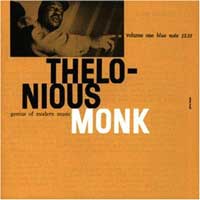 Ich komme bei diesen frÞhen Aufnahmen von Monk, Miles & Co. immer ein wenig durcheinander,
denn die Aufnahmen stammen zwar von 1947 und '48, wurden aber zuerst als 78er Schellacks verÃķffentlicht,
als 1o"-Alben auf Vinyl wohl aber erst spÃĪter, denn die ersten 10"
von Blue Note erschienen erst 1951. Ein Pflichtkauf, weil Monks erste eigene Version von "'Round Midnight" mit dabei ist.
Ich komme bei diesen frÞhen Aufnahmen von Monk, Miles & Co. immer ein wenig durcheinander,
denn die Aufnahmen stammen zwar von 1947 und '48, wurden aber zuerst als 78er Schellacks verÃķffentlicht,
als 1o"-Alben auf Vinyl wohl aber erst spÃĪter, denn die ersten 10"
von Blue Note erschienen erst 1951. Ein Pflichtkauf, weil Monks erste eigene Version von "'Round Midnight" mit dabei ist.

 Mehr ...
Mehr ...
Bebop-Pianist Monk zeigt bei heißen Combo-Sessions, wieviel virtuose Kraft seine oft skurrilen Ideen wecken können. Er liebte harte Brüche sowie hitzige Soli und ließ sich dafür Themen von zeitloser Schönheit einfallen. Die spielte er 1947 in Trio- sowie Quintett-Besetzungen.
(© Audio)
"Genius Of Modern Music Vol.1" (CDP 7815102, 63:16) und "Vol.2" (CDP 7815112, 60:35), sowie "Milt Jackson" sind die einzigen Aufnahmen, die der revolutionäre Monk unter seinem Namen für Blue Note einspielte. ** Interpret.: 10/08 ** Klang.: 06-08 ** Repertoire.: 10
(© Stereoplay)
Volume 1 of the two-volume Genius of Modern Music set comprises the first sessions Thelonious Monk recorded as a leader, on October 15 and 24 and November 21 of 1947. It's impossible to overstate the importance of these sessions. They include some of the earliest recordings of Monk compositions that would become standards, despite their angularity and technical difficulty: the strange, sideways chord progression of "Thelonious"; the bouncy and cheerful but melodically cockeyed "Well, You Needn't"; the post-bop Bud Powell tribute "In Walked Bud"; and, of course, "'Round Midnight," which is now one of the most frequently recorded jazz compositions ever. There are kinks to be worked out: Art Blakey's drumming is fine, but he obviously hasn't quite taken the measure of Monk's compositional genius, and on the November session, alto saxophonist Sahib Shihab employs a fat, warbly tone that sounds out of place. But the excitement of discovery permeates every measure, and Monk himself is in top form, his solos jagged and strange, yet utterly beautiful. This first volume of Genius of Modern Music, along with the second, belongs in every jazz collection.
(by Rick Anderson, All Music Guide)
Blue Note was the first record company to take a chance with Monk, whose unorthodox music with its jarring dissonances and quirky melodies many listeners found challenging. The label recorded a slew of 78-rpm singles between 1947 and 1952, eventually collecting those sides on two companion LP volumes titled Genius of Modern Music. Highlights are plentiful, including early versions of Monkâs most memorable tunes such as âStraight No Chaser,â âRuby My Dear,â âWell You Neednât,â and the immortal ballad âRound About Midnight.â
(www.udiscovermusic.com)
Platz15bei uDiscoverMusic.
|
| Thelonius Monk: "Genius Of Modern Music, Vol. 2" (BLP 5009, 15. Okt. 1947 - 23. Juli 1951) |
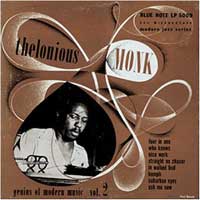 Der zweite Teil des Monk-Klassikers, dieses Mal mit Aufnahmen von 1947 bis '51, auf meiner CD sogar mit Aufnahmen von 1952.
Der zweite Teil des Monk-Klassikers, dieses Mal mit Aufnahmen von 1947 bis '51, auf meiner CD sogar mit Aufnahmen von 1952.
|
| Miles Davis: "Vol. 3" (BLP 5040, 06. MÃĪrz 1954) |
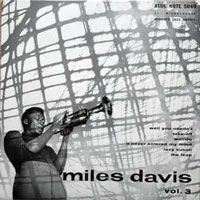 Miles in Quartettbesetzung mit Horace Silver, Percy Heath und Art Blakey.
Diese gut klingenden Aufnahmen gelten als eine der frÞhesten im Hardbob-Stil.
Miles in Quartettbesetzung mit Horace Silver, Percy Heath und Art Blakey.
Diese gut klingenden Aufnahmen gelten als eine der frÞhesten im Hardbob-Stil.

 Mehr ...
Mehr ...
Though Miles Davis mainly recorded for Prestige in the first half of the 1950s, he cut three sessions â with different sets of musicians â for Blue Note between 1952 and 1954. It resulted in two albums that are regarded as a blueprint for the hard bop sound, infusing jazz with blues and gospel elements. Whether heâs playing fast and furiously on uptempo material, like âTempus Fugit,â or waxing lyrical on the wistful ballad, âIt Never Entered My Mind,â Milesâ playing is never less than sublime.
(www.udiscovermusic.com)
Platz26bei uDiscoverMusic.
|
| Sonny Rollins: "Vol. 2" (BLP 1558, 14. April 1957) |
 Na? Kommt Euch das Cover bekannt vor? Genau, Joe Jackson hat
es mal fÞr sein jazzangehauchtes Album "Body
And Soul" nachgestellt. Auch der Plattentitel bezieht sich
auf Jazz, denn der gleichnamige Song wurde damals in der Version von
John Coltrane bekannt.
Na? Kommt Euch das Cover bekannt vor? Genau, Joe Jackson hat
es mal fÞr sein jazzangehauchtes Album "Body
And Soul" nachgestellt. Auch der Plattentitel bezieht sich
auf Jazz, denn der gleichnamige Song wurde damals in der Version von
John Coltrane bekannt.

 Mehr ...
Mehr ...
Compared to his Prestige, Riverside and Contemporary recordings of the 1950s, some of Rollins's appearances on Blue Note seemed anticlimactic but none should be overlooked. This unusual LP mostly has Rollins in an all-star quintet with trombonist J.J. Johnson, pianist Horace Silver, bassist Paul Chambers and drummer Art Blakey but Thelonious Monk sits in on his ballad "Reflections" and on "Misterioso" both Silver and Monk get to take contrasting solos. Of the other selections, Rollins's two originals ("Why Don't I" and "Wail March") are worth reviving and he finds something new to say on "Poor Butterfly" and an uptempo "You Stepped out of a Dream."
(by Scott Yanow, All Music Guide)
|
| Johnny Griffin: "Blowin' Session" (BLP 1559, 06. April 1957) |
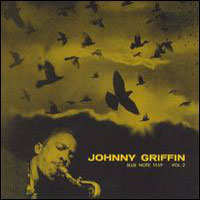

 Mehr ...
Mehr ...
A Blowin' Session is one of the greatest hard bop jam sessions ever recorded; it is filled with infectious passion and camaraderie. It's also the only time tenor saxophonists Johnny Griffin and John Coltrane would play together on record. Initially Coltrane wasn't scheduled to be on this date, but Griffin saw him on his way to Rudy Van Gelder's studio and asked him to join the remaining musicians, third tenor Hank Mobley, trumpeter Lee Morgan, pianist Wynton Kelly, bassist Paul Chambers, and drummer Art Blakey. These musicians were all associates within the same East Coast hard bop scene of the time; they came from the Jazz Messengers and Miles Davis' quintet, and many had played with Dizzy Gillespie's big band. Showcased on this April 8, 1958, session are two standards, "The Way You Look Tonight" and "All the Things You Are," along with two original Griffin compositions, "Ball Bearing" and "Smoke Stack." An added bonus on the 1999 Rudy Van Gelder remastered edition is an alternate take of "Smoke Stack." Of special note is "The Way You Look Tonight," featuring the three tenors trading off with complexity and speed that is still astonishing, especially in the case of Griffin (dubbed the world's fastest saxophonist) and Coltrane's ability to navigate complex chord changes over a fast tempo.
(by Al Campbell, All Music Guide)
|
John Coltrane: "Blue Train" (BLP 1577, 15. Sept. 1957) |
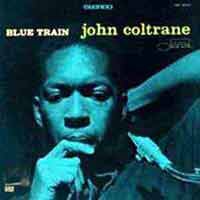 Ein eher unbekanntes Album des grÃķÃten Saxofonisten aller Zeiten,
noch vor denen bei Atlantic und Impulse und sein einziges
fÞr Blue Note. Mit der bewÃĪhrten Rhythmusgruppe von Miles
Davis (Schlagzeuger Philly Joe Jones und Bassist Paul Chambers),
Kenny Drew am Piano, Posaunist Curtis Fuller und Trompeter
Lee Morgan war das sogar ein Sextett mit drei BlÃĪsern.
Ein eher unbekanntes Album des grÃķÃten Saxofonisten aller Zeiten,
noch vor denen bei Atlantic und Impulse und sein einziges
fÞr Blue Note. Mit der bewÃĪhrten Rhythmusgruppe von Miles
Davis (Schlagzeuger Philly Joe Jones und Bassist Paul Chambers),
Kenny Drew am Piano, Posaunist Curtis Fuller und Trompeter
Lee Morgan war das sogar ein Sextett mit drei BlÃĪsern.

 Mehr ...
Mehr ...
ïŧŋ
This album, recorded in September 1957, marked John Coltraneâs comeback after his heroin use led to his ejection from Miles Davisâ band earlier in the year. After going cold turkey and successfully beating his addiction, Coltrane was a man reborn whose music became more sharply focused, especially after he began working with Thelonious Monk. He was still playing with Monkâs quintet when he recorded Blue Train with a sextet that included young trumpet genius Lee Morgan. All but one of the tunes is by the saxophonist, and itâs the title cut, with its memorable clarion call theme, which is the stand-out. Widely acknowledged as Traneâs first masterpiece, anyone looking to buy John Coltrane for the first time needs to start here.
(www.udiscovermusic.com)
Blue Train was the first of several musical masterpieces that Coltrane would create in his short recording career. It came at a time when the saxophonist, who had transformed his life after overcoming heroin addiction, was playing with Thelonious Monk and honing his famous âsheets of soundâ style. Though âTraneâ had a deal with Prestige, he negotiated to do a one-off LP for Blue Note. The resulting album, rendered in a hard bop style, was the catalyst that kick-started his solo career. Thanks to the presence of Curtis Fullerâs resonant trombone, Blue Train offered a unique sonic signature with its three-horn frontline. It also showcased Coltraneâs advances as both an improviser and composer, especially on the magnificent title track and âLocomotion.â
(www.udiscovermusic.com)
Although never formally signed, an oral agreement between John Coltrane and Blue Note Records founder Alfred Lion was indeed honored on Blue Train -- Coltrane's only collection of sides as a principal artist for the venerable label. The disc is packed solid with sonic evidence of Coltrane's innate leadership abilities. He not only addresses the tunes at hand, but also simultaneously reinvents himself as a multifaceted interpreter of both hard bop as well as sensitive balladry -- touching upon all forms in between. The personnel on Blue Train is arguably as impressive as what they're playing. Joining Coltrane (tenor sax) are Lee Morgan (trumpet), Curtis Fuller (trombone), Kenny Drew (piano), Paul Chambers (bass), and Philly Joe Jones (drums). The triple horn arrangements incorporate an additional sonic density that remains a trademark unique to both this band and album. Of particular note is Fuller's even-toned trombone, which bops throughout the title track as well as the frenetic "Moments Notice." Other solos include Paul Chambers' subtly understated riffs on "Blue Train" as well as the high energy and impact from contributions by Lee Morgan and Kenny Drew during "Locomotion." The track likewise features some brief but vital contributions from Philly Joe Jones -- whose efforts throughout the record stand among his personal best. Of the five sides that comprise the original Blue Train, the Jerome Kern/Johnny Mercer ballad "I'm Old Fashioned" is the only cover tune in the stack. In terms of unadulterated sentiment, this version is arguably untouchable. Fuller's rich tones and Drew's tastefully executed solos cleanly wrap around Jones' steadily languid rhythms. This is sheer jazz nirvana. In the spring of 1997, the Ultimate Blue Train CD was released, boasting 20-bit remastered audio as well as one alternate take of both "Blue Train" and "Lazy Bird." Additionally, the disc includes "At Least Listen" -- an interactive CD-ROM program featuring video clips and interview clips with Fuller circa 1995, as well as many brilliant photographs taken during the recording sessions. Without reservation, Blue Train can easily be considered in and among the most important and influential entries not only of John Coltrane's career, but of the entire genre of jazz music as well.
(by Lindsay Planer, All Music Guide)
Recorded as a one-off while he was still contracted to the Prestige label, Blue Train was John Coltraneâs only solo offering for Alfred Lion and Francis Wolffâs imprint. Recorded in late 1957, after the saxophonist had gone âcold turkeyâ to quit the heroin addiction that got him fired from Miles Davisâ band earlier in the year, Blue Train marked his rebirth as a drug-free musician. Perhaps because of this, it was Traneâs first truly exceptional long-player and showed him living up to the promise he had shown before drugs threatened to derail his career. Coltrane leads a sextet with a three-horn frontline that includes trumpeter Lee Morgan and trombonist Curtis Fuller, the latter bringing a rich sonority to the album. The opening title tune, with its memorable clarion call horn theme, is one of Coltraneâs classic compositions and offers a vivid example of his ornate âsheets of soundâ soloing style in a hard bop setting. The only cover among the albumâs five tunes is the Johnny Mercer-Jerome Kern-written âIâm Old Fashionedâ, a plaintive ballad on which Coltrane favours deep emotional expression over flashy displays of technique. Not only an essential entry in any guide to Blue Note, but one of the first ports of call for anyone interested in John Coltrane, Blue Train is a must-hear album.
(www.udiscovermusic.com)
Platz2bei uDiscoverMusic.
|
Sonny Clark: "Cool Struttin'" (BLP 1588, 05. Jan. 1958) |
 Ein echter Hardbob-Klassiker in jedem Fall - vielleicht sogar
das Blue-Note-Album-Schlechthin? Ich kenne kaum etwas
mit mehr Swing als diese Aufnahmen des oft unterschÃĪtzten Pianisten,
hier zusammen mit dem Trompeter Art
Farmer, dem Altsaxofonisten Jackie McLean
und der ein Jahr spÃĪter durch das Miles Davis-Album "Kind
Of Blue" weltbekannt werdenden Rhythmusgruppe mit Schlagzeuger
Philly Joe Jones und Bassist Paul Chambers.
Ein echter Hardbob-Klassiker in jedem Fall - vielleicht sogar
das Blue-Note-Album-Schlechthin? Ich kenne kaum etwas
mit mehr Swing als diese Aufnahmen des oft unterschÃĪtzten Pianisten,
hier zusammen mit dem Trompeter Art
Farmer, dem Altsaxofonisten Jackie McLean
und der ein Jahr spÃĪter durch das Miles Davis-Album "Kind
Of Blue" weltbekannt werdenden Rhythmusgruppe mit Schlagzeuger
Philly Joe Jones und Bassist Paul Chambers.
(08.08.2006)

 Mehr ...
Mehr ...
Recorded in 1958, this legendary date with the still-undersung Sonny Clark in the leader's chair also featured a young Jackie McLean on alto (playing with a smoother tone than he had before or ever did again), trumpeter Art Farmer, and the legendary rhythm section of bassist Paul Chambers and drummer Philly Joe Jones, both from the Miles Davis band. The set begins with one of the preeminent "swinging medium blues" pieces in jazz history: the title track with its leveraged fours and eights shoved smoothly up against the walking bass of Chambers and the backbeat shuffle of Jones. Clark's solo, with its grouped fifths and sevenths, is a wonder of both understatement and groove, while Chambers' arco solo turns the blues in on itself. While there isn't a weak note on this record, there are some other tracks that stand out, most notably Miles' "Sippin' at Bells," with its loping Latin rhythm. When McLean takes his solo against a handful of Clark's shaded minor chords, he sounds as if he may blow it -- he comes out a little quick -- but he recovers nicely and reaches for a handful of Broadway show tunes to counter the minor mood of the piece. He shifts to both Ben Webster and Lester Young before moving through Bird, and finally to McLean himself, riding the margin of the changes to slip just outside enough to add some depth in the middle register. The LP closes with Henderson and Vallée's "Deep Night," the only number in the batch not rooted in the blues. It's a classic hard bop jamming tune and features wonderful solos by Farmer, who plays weird flatted notes all over the horn against the changes, and McLean, who thinks he's playing a kind of snake charmer blues in swing tune. This set deserves its reputation for its soul appeal alone. [The CD version includes two bonus tracks: "Royal Flush" and "Lover"].
(by Thom Jurek, All Music Guide)
Conrad âSonnyâ Clark was a hard bop pianist from Pennsylvania who lived fast and died young. Regarded as his magnum opus, Cool Struttinâ was the seventh of nine albums he recorded for Blue Note during a fertile five-year stay. The album features a two-horn frontline consisting of altoist Jackie McLean and trumpeter Art Farmer, who are underpinned by a rhythm section comprised of Miles Davisâ then bassist Paul Chambers and drummer Philly Joe Jones. From the soulful, swaggering title track to the hard-swinging âBlue Minorâ and âSippinâ At Bells,â Cool Struttinâ showcases the virtues of the hard bop style at its creative apex.
(www.udiscovermusic.com)
Platz22bei uDiscoverMusic.
|
Cannonbal Adderley: "Somethin' Else" (BLP 1595, 09. MÃĪrz 1958) |


 Mehr ...
Mehr ...
ïŧŋ
Adderley was about to push into the soul-jazz era when he made this one-off for Blue Note. In a sense it was a vale to what had passed between the altoist and Miles Davis during the time they shared the bandstand in the Miles Davis Sextet, complete with Milesâ compulsive borrowings from Ahmad Jamal and the delicate balance struck between the beautiful simplicity of the emerging modernist simplicity and Cannonâs natural ebullience. Miles got the altoist to shine through ballads and burnished blowing throughout, complementing in fine style while the rest of the crew kept a discreet distance.
Adderley war im Begriff in die Soul-Jazz-Ãra zu drÃĪngen, als er dieses einmalige Album fÞr Blue Note machte. In gewissem Sinne war es ein Lebewohl zu dem, was zwischen dem Altoisten und Miles Davis war in der Zeit, als sie die BÞhne im Miles Davis Sextet teilten, vollendet mit Miles zwanghaften Anleihen an Ahmad Jamal und dem empfindlichen Gleichgewicht zwischen der schÃķnen Einfachheit, die zwischen der aufkommenden modernistischen Einfachheit und Cannons natÞrlichen Ãberschwang geschah. Miles brachte den Altoisten zum Erstrahlen durch Balladen, im feinen Stil ergÃĪnzend mit durchgÃĪngig aufpoliertem Spiel, wÃĪhrend der Rest der Mannschaft einen diskreten Abstand hielt.
(Keith Shadwick, Die Musikzeitschrift Jazzwise wÃĪhlte es auf Platz 58 in der Liste The 100 Jazz Albums That Shook the World. )
Topping our list of the greatest 50 Blue Note albums is alto saxophonist Julian âCannonballâ Adderleyâs only recording for Alfred Lionâs label. What was also significant about the album was that it featured Miles Davis in a rare sideman role, which came about because Adderley, then 29, was playing in the trumpeterâs sextet at the time. Milesâ presence â playing a muted horn â functions as a source of inspiration for the Florida-born saxophonist, who serves up a career-defining opus. Also assisting are pianist Hank Jones, bassist Sam Jones, and drummer Art Blakey. They combine their talents to create a compelling musical synergy on six tracks that range from haunting ballads (âAutumn Leavesâ) to swinging uptempo numbers (âLove For Saleâ). Somethinâ Else is an inspired collection of modern jazz and remains one of Blue Noteâs â and jazzâs â significant recordings.
(All Music Guide)
Platz1bei uDiscoverMusic.
|
Art Blakey And The Jazz Messengers: "Moanin'" (BLP 4003, 30. Okt. 1958) |
 Mit dem Titelsong aus der Feder von Pianist Bobby Timmons und "Along Came
Betty" von Saxofonist Benny Golson enthÃĪlt das Album gleich zwei Originalaufnahmen
zukÞnftiger Jazzklassiker. An der Trompete Þberzeugt Lee Morgan.
Mit dem Titelsong aus der Feder von Pianist Bobby Timmons und "Along Came
Betty" von Saxofonist Benny Golson enthÃĪlt das Album gleich zwei Originalaufnahmen
zukÞnftiger Jazzklassiker. An der Trompete Þberzeugt Lee Morgan.
(10.03.2009)

 Mehr ...
Mehr ...
Das ist wahrlich einer der groÃen Klassiker des Hardbop: Art Blakey fÞhrt seine wohl beste Jazz-Messengers-Besetzung durch ein treibendes Programm, das keinen Moment nachlÃĪsst. Tenorsaxophonist Benny Golson (dessen in der Folge zum Jazzklassiker gewordenes "Along Came Betty" hier zum ersten Mal zu hÃķren ist), der brillante Trompeter Lee Morgan und der funky Pianist Bobby Timmons, der den Titelhit schrieb, spielen einige der besten Solos ihrer gro&Ãen Karrieren, und Blakey selbst war niemals besser. Diese CD sollte in keiner Jazzsammlung fehlen. Sie bleibt einer der fÞhrenden Posten im Blue Note-Katalog und das mit Recht. Im Rahmen der 60-Jahr-Feier des Blue-Note-Labels 1999 hat Rudy Van Gelder, der Produzent der Originalaufnahme, einen Bombenjob mit dem Remix von "Moanin'" abgeliefert: Die BÃĪsse sind wÃĪrmer geworden, das Gesamtspektrum farbiger. Das Booklet mit den alten Schwarzweiss-Fotos der Session ist wie ein LP-Klappcover zu Ãķffnen.
(Skip Heller, aus der Amazon.de-Redaktion)
Renowned for his powerful, energetic style, Pittsburgh drummer Art Blakey had been leading The Jazz Messengers for five years when they released Moaninâ, arguably the groupâs definitive recording. Due to the many young, up-and-coming musicians that passed through the groupâs ranks during its long history (1954-1990), the band was dubbed the âHard Bop Academyâ, and on Moaninâ Blakeyâs new recruits included Philadelphia pianist Bobby Timmons, who wrote the albumâs gospel-flavoured title tune, often cited as a quintessential example of the Blue Note sound. Also fresh in from Philly was tenor saxophonist Benny Golson, who composed three of the albumâs other highlights â âAlong Came Bettyâ, âThe Drum Thunder Suiteâ (a vehicle for Blakeyâs polyrhythmic percussion prowess) and âBlues Marchâ â while teenage trumpet sensation Lee Morgan shone throughout with his precocious virtuosity. Though regarded as an archetypal hard bop session, the albumâs title song, with its sanctified call-and-response cadences, anticipated the more immediate soul jazz style of the early 60s. Francis Wolffâs stark cover portrait of Blakey caps what is one of the greatest albums in Blue Noteâs repertoire â one that no guide to Blue Note can be without.
(www.udiscovermusic.com)
Though regarded as the progenitors of hard bop, The Messengers helped to birth soul-jazz with this sensational album that premiered a new line-up of the band. Horn players Benny Golson and Lee Morgan together with pianist Bobby Timmons and bassist Jymie Merritt. Timmons wrote the catchy title tune, whose Amen-style call-and-response cadences referenced gospel music. The album also contained two other classic songs, both from Golsonâs pen: âBlues Marchâ and âAlong Came Betty.â Blakey showcased his polyrhythmic prowess on an epic percussion-focused piece called âThe Drum Thunder Suite.â
(www.udiscovermusic.com)
Platz5bei uDiscoverMusic.
|
Hank Mobley: "Soul Station" (BLP 4031, 07. Feb. 1960) |
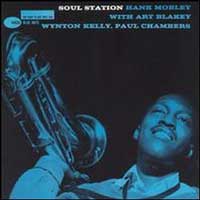 Hank Mobley hat als Tenorsaxofonist zwar nie den Bekanntheitsgrad von John
Coltrane oder Sonny Rollins erreicht
und war sicherlich nicht so "innovativ" wie Coltrane, hat aber
nichtsdestotrotz ein paar ausgezeichnete Alben aufgenommen. Dieses "typische
Blue-Note-Album" gilt zu recht als eines seiner besten. Mit dem unvergleichlichen
Art Blakey am Schlagzeug, sowie Wynton Kelly
am Piano und Paul Chambers am Kontrabass, beide Mitglieder vom
Miles Davis Quintet und auch auf dessen legendÃĪrem Album "Kind
Of Blue" dabei.
Hank Mobley hat als Tenorsaxofonist zwar nie den Bekanntheitsgrad von John
Coltrane oder Sonny Rollins erreicht
und war sicherlich nicht so "innovativ" wie Coltrane, hat aber
nichtsdestotrotz ein paar ausgezeichnete Alben aufgenommen. Dieses "typische
Blue-Note-Album" gilt zu recht als eines seiner besten. Mit dem unvergleichlichen
Art Blakey am Schlagzeug, sowie Wynton Kelly
am Piano und Paul Chambers am Kontrabass, beide Mitglieder vom
Miles Davis Quintet und auch auf dessen legendÃĪrem Album "Kind
Of Blue" dabei.

 Mehr ...
Mehr ...
ïŧŋ
A virtuoso saxophonist who has often been criminally underrated â perhaps because he wasnât a pathfinder in the mould of revolutionary figures such as Coltrane or Ornette Coleman â Hank Mobley was, nevertheless, a pivotal and prolific figure in the evolution of hard bop, recording a whopping 26 albums for Blue Note between 1955 and 1970. Though his output was consistently good and rarely dipped in quality, one album stands head and shoulders above the rest to earn its place in this guide to Blue Note: Soul Station. Recorded in February 1960, it finds Mobley leading a stellar quartet comprised of Miles Davis band members â pianist Wynton Kelly and bassist Paul Chambers â plus Þber-drummer Art Blakey. The sprightly but mellow opener, Irving Berlinâs âRememberâ, is the chief standout, highlighting Mobleyâs gorgeous, well-rounded tone. Itâs one of two fine covers on the album, but the tenor saxophonist also impresses on three striking originals, including a funky, finger-clicking soul jazz groove called âDig Disâ and the bluesy, slow-paced title song.
(www.udiscovermusic.com)
An often underrated tenor saxophonist whose mellow, sonorous style was overshadowed by the more visceral approach of his contemporaries, Georgia-born Hank Mobley nevertheless belongs in the pantheon of jazzâs elite horn players. He recorded 26 album sessions for Blue Note, of which Soul Station is the most remarkable. Featuring high-caliber sidemen â Wynton Kelly, Paul Chambers, and Art Blakey â the album finds Mobley in irresistible form. In addition to four superlative original numbers, Mobley provides soulful interpretations of two standards, including a beautiful rendition of Irving Berlinâs âRemember.â
(www.udiscovermusic.com)
Platz11bei uDiscoverMusic.
|
| Tina Brooks: "True Blue" (BLP 4041, 25. Juni 1960) |
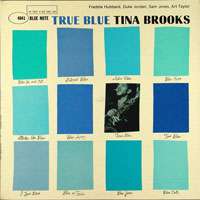 Tina Brooks ist als Blue Note-Tenorsaxofonist nie so bekannt geworden wie Sonny Rollins,
John Coltrane, Joe Henderson, Wayne Shorter
oder Hank Mobley. Deshalb ist wohl auch vielen diese schÃķne Hardbop-Session mit
Freddie Hubbard (tp), Duke Jordan (p), Sam Jones (b) und Art Taylor
(dr) entgangen. Sommermusik.
Tina Brooks ist als Blue Note-Tenorsaxofonist nie so bekannt geworden wie Sonny Rollins,
John Coltrane, Joe Henderson, Wayne Shorter
oder Hank Mobley. Deshalb ist wohl auch vielen diese schÃķne Hardbop-Session mit
Freddie Hubbard (tp), Duke Jordan (p), Sam Jones (b) und Art Taylor
(dr) entgangen. Sommermusik.

 Mehr ...
Mehr ...
Tenor saxophonist Harold âTinaâ Brooks recorded five albums in all for Blue Note but only one, True Blue, was released during his lifetime. Originally from Fayetteville, North Carolina, Brooks was an exponent of hard bop and played as a sideman for Kenny Burrell and Freddie Hubbard on Blue Note studio dates before Alfred Lion recorded him as a leader. Hubbard appears on True Blue, together with pianist Duke Jordan, bassist Sam Jones and drummer Art Taylor, who offer sterling support throughout the six-track album. Apart from the closing standard âNothing Ever Changes My Love For You,â Brooks serves up five original and consistently strong compositions, ranging from the finger-snapping âGood Old Soulâ to the more urgent âMiss Hazel.â
(www.udiscovermusic.com)
Platz35bei uDiscoverMusic.
|
| Horace Parlan Quintet: "Speakin' My Peace" (BLP 4043, 14. Juli 1960) |

|
| Art Taylor: "A.T.'s Delight" (BLP 4047, 06. August 1960) |


 Mehr ...
Mehr ...
Art Taylor war lange Jahre fester Bestandteil der Blue Note Hausband, doch dies ist das einzige Album des Drummers unter seinem Namen, wÃĪhrend seiner langen Karriere bei Blue Note. Das Album aus dem Jahr 1960 zeigt EinflÞsse aus dem Calypso und besonders bei âCookoo and Fungi" bringt die doppelte BlÃĪserbesetzung die geradezu nervÃķse Energie der Truppe hervorragend zur Geltung.
Although Art Taylor was one of the busiest modern second-generation jazz drummers, working in the studio with Coleman Hawkins, Donald Byrd, John Coltrane and many others, he only released five albums under his own name, of which A.T.'s Delight was the third. And a delight it is indeed, bright and percussive, and when conga player Carlos "Patato" Valdes joins Taylor and pianist Wynton Kelly and bassist Paul Chambers on three cuts (Thelonious Monk's "Epistrophy," "Move" and a Taylor calypso-inflected original called "Cookoo and Fungi"), the rhythm pocket opens into a deep blue sea for the horn men (Stanley Turrentine on tenor sax and Dave Burns on trumpet). "Move" does exactly that, it moves, and at a blistering pace. Monk's "Epistrophy," thanks in part to Valdes, reveals its rumba roots, and has never sounded brighter. The seldom-covered Coltrane composition "Syeeda's Song Flute" seems likewise refreshed and revived. The lone Taylor original, the driving "Cookoo and Fungi," is as sharp and alert is a kitten waking from a nap in the spring sun, and Taylor's drum solo is crisp, efficient and slides seamlessly into the calypso-informed main theme. A.T.'s Delight is a solid outing, with a wonderfully nervous but completely focused energy.
(by Steve Leggett, All Music Guide)
|
Freddie Hubbard: "Ready For Freddie" (BLP 4085, 12. Aug. 1961) |
 Kein besonders kreativer LP-Titel, aber eines der besten Alben eines der besten Jazztrompeter.
"High End Blue Note" sozusagen, Dank Freddie Hubbard,
Tonmeister Rudy van Gelder (wer sonst?) und der tollen Band: Schlagzeuger
Elvin Jones, Pianist McCoy Tyner und Bassist Art Davis
vom Coltrane Quartett (bei Art Davis
bin ich mir nicht sicher, ob er dort fest dabei war oder nur "ErgÃĪnzungsspieler"
), dazu der damals noch "junge" Tenorsaxofonist Wayne
Shorter und Euphoniumspieler Bernard McKinney (der nannte sich
spÃĪter Kiane Zawadi, warum auch immer), aufgenommen
am 12. August 1961. Das im Jazz eher selten eingesetzte Euphonium liegt
von der Lage her zwischen der Trompete und der Tuba und klingt fÞr
ungeÞbte Ohren (also z. B. meine) wie eine Posaune.
Kein besonders kreativer LP-Titel, aber eines der besten Alben eines der besten Jazztrompeter.
"High End Blue Note" sozusagen, Dank Freddie Hubbard,
Tonmeister Rudy van Gelder (wer sonst?) und der tollen Band: Schlagzeuger
Elvin Jones, Pianist McCoy Tyner und Bassist Art Davis
vom Coltrane Quartett (bei Art Davis
bin ich mir nicht sicher, ob er dort fest dabei war oder nur "ErgÃĪnzungsspieler"
), dazu der damals noch "junge" Tenorsaxofonist Wayne
Shorter und Euphoniumspieler Bernard McKinney (der nannte sich
spÃĪter Kiane Zawadi, warum auch immer), aufgenommen
am 12. August 1961. Das im Jazz eher selten eingesetzte Euphonium liegt
von der Lage her zwischen der Trompete und der Tuba und klingt fÞr
ungeÞbte Ohren (also z. B. meine) wie eine Posaune.
(28.05.2008)

 Mehr ...
Mehr ...
Trumpeter Freddie Hubbard really came into his own during this Blue Note session. He is matched with quite an all-star group (tenor saxophonist Wayne Shorter, pianist McCoy Tyner, bassist Art Davis, and drummer Elvin Jones in addition to Bernard McKinney on euphonium), introduces two of his finest compositions ("Birdlike" and "Crisis"), and is quite lyrical on his ballad feature, "Weaver of Dreams." Hubbard's sidemen all play up to par and this memorable session is highly recommended; it's one of the trumpeter's most rewarding Blue Note albums.
(by Scott Yanow, All Music Guide)
|
| Ike Quebec: "Blue And Sentimental" (BLP 4098, 23. Dez. 1961) |
|
 Ike Quebec war ein enger Freund von Produzent und Labelchef Alfred Lion, arbeitete
hauptsÃĪchlich als Talentscout fÞr Blue Note, nahm aber auch gelegentlich noch eigene Alben auf.
Ike Quebec war ein enger Freund von Produzent und Labelchef Alfred Lion, arbeitete
hauptsÃĪchlich als Talentscout fÞr Blue Note, nahm aber auch gelegentlich noch eigene Alben auf.
Das 1963 erschienene Album "Blue And Lonesome" ist noch viel
besser, als das wenige Tage vorher aufgenommene Album "It
Might As Well Be Spring". Begleiter aus der 1. Jazz-Liga
sind dabei: Gitarrist Grant Green, Bassist Paul
Chambers und Schlagwerker Philly Joe Jones. Aber vor allem
Þberzeugt der Ton von Ike. Perfektes Nachtclub-Saxofon. WunderschÃķn.
Balsam fÞr die Ohren.
|
| Ike Quebec: "It Might A Well Be Spring" (BLP 4105, 09. Dez. 1961) |
|
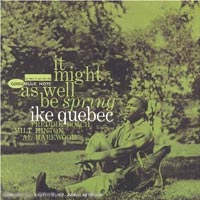 Aufgenommen 1961, verÃķffentlicht aber erst 1964, was aber nicht ungewÃķhnlich fÞr
Blue-Note und viele andere Jazzlabels war: Oft wurde in einer Session
Material fÞr mehrere Alben eingespielt, manchmal verschwanden ganze
Sessions und somit ganze geplante Alben erst einmal im Archiv und wurden erst
nach dem Tod (Quebec verstarb 1963) oder nach Labelwechsel der KÞnstler
verÃķffentlicht, ohne dass man dabei aber von AusschuÃmaterial
sprechen kÃķnnte.
Aufgenommen 1961, verÃķffentlicht aber erst 1964, was aber nicht ungewÃķhnlich fÞr
Blue-Note und viele andere Jazzlabels war: Oft wurde in einer Session
Material fÞr mehrere Alben eingespielt, manchmal verschwanden ganze
Sessions und somit ganze geplante Alben erst einmal im Archiv und wurden erst
nach dem Tod (Quebec verstarb 1963) oder nach Labelwechsel der KÞnstler
verÃķffentlicht, ohne dass man dabei aber von AusschuÃmaterial
sprechen kÃķnnte.
Milt Hinton (bass), Al Harewood (dr) und Freddie Roach
(org) sind hier die etwas unbekannteren Mitmusiker. Das Album hat mir
optisch schon immer gut gefallen. Und kÞrzlich habe ich in der Grabbelkiste
von 2001 zugegriffen ...
(MÃĪrz 2009)
|
| Jackie McLean: "Let Freedom Ring" (BLP 4106, 19. MÃĪrz 1962) |
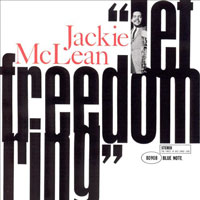 (29.05.2015)
(29.05.2015)

 Mehr ...
Mehr ...
Jackie McLean had always been a highly emotional soloist, so it makes sense that he was one of the first hard bop veterans to find a new voice in the burning intensity of jazz's emerging avant-garde. McLean had previously experimented with Coltrane's angular modes and scales and Ornette's concept of chordal freedom, but Let Freedom Ring was the landmark masterpiece where he put everything together and ushered in the era of the modernists at Blue Note. A number of saxophonists were beginning to explore the ability of the instrument to mimic human cries of passion, and here McLean perfected a long, piercing squeal capable of expressing joy, anguish, fury, and more. The music on Let Freedom Ring remained more rooted in hard bop structure than Coleman's, and McLean was still recognizably himself, but that was precisely what was revolutionary about the album: It validated the avant-garde aesthetic, demonstrating that it had enough value to convert members of the old guard, and wasn't just the province of radical outcasts. There are only four pieces, one of which is the surging Bud Powell ballad "I'll Keep Loving You"; the other three are McLean originals ("Melody for Melonae," "Rene," and "Omega," dedicated to his daughter, son, and mother respectively) that spotlight his tremendous inventiveness on extended material and amaze with a smoldering fire that never lets up. Pianist Walter Davis takes the occasional solo, but the record is McLean's statement of purpose, and he accordingly dominates the proceedings, with the busy, free-flowing dialogues of bassist Herbie Lewis and Ornette drummer Billy Higgins pushing him to even greater heights. The success of Let Freedom Ring paved the way for a bumper crop of other modernist innovators to join the Blue Note roster and, artistically, it still stands with One Step Beyond as McLean's greatest work.
(by Steve Huey, All Music Guide)
An alto saxophonist with a distinctly dry, bittersweet tone, McLean joined Blue Note in 1959 and spent eight years with the label. He started as a hard bop disciple, but as Let Freedom Ring clearly shows, he was a progressive musician who wanted to push the jazz envelope and probe the musicâs boundaries. In the company of pianist Walter Davis, bassist Herbie Lewis and drummer Billy Higgins, McLean reveals his credentials as a forward-thinking modernist with three memorable original tunes and a Bud Powell cover. The music still swings but the squealing, eerie high notes that emanate from McLeanâs horn from time to time show Eric Dolphy and Ornette Colemanâs influence.
(www.udiscovermusic.com)
Platz30bei uDiscoverMusic.
|
Dexter Gordon: "Go!" (BLP 4112, 27. August 1962) |
|
 (10.06.2020)
(10.06.2020)

 Mehr ...
Mehr ...
From the first moments when Dexter Gordon sails into the opening song full of brightness and confidence, it is obvious that Go! is going to be one of those albums where everything just seems to come together magically. A stellar quartet including the stylish pianist Sonny Clark, the agile drummer Billy Higgins, and the solid yet flexible bassist Butch Warren are absolutely crucial in making this album work, but it is still Gordon who shines. Whether he is dropping quotes into "Three O'Clock in the Morning" or running around with spritely bop phrases in "Cheese Cake," the album pops and crackles with energy and exuberance. Beautiful ballads like "I Guess I'll Hang My Tears Out to Dry" metamorphosize that energy into emotion and passion, but you can still see it there nonetheless. Gordon had many high points in his five decade-long career, but this is certainly the peak of it all.
(by Stacia Proefrock, All Music Guide)
Standing at 6â 6âģ high, Dexter Gordon justified his âLong Tall Dexterâ nickname. But what helped make him a true jazz giant was Go!, the third long-player he cut for Blue Note during a career renaissance in the early 60s. With Sonny Clark on piano, Butch Warren on bass, and drummer Billy Higgins, the Los Angeles-born tenor titan offers a stunning collection of performances. They range from fast swingers (âCheese Cakeâ and âLove For Saleâ) and mid-tempo foot-tappers (âThree OâClock In The Morningâ) to bittersweet ballads (âI Guess Iâll Hang My Tears Out To Dryâ).
(www.udiscovermusic.com)
Platz9bei uDiscoverMusic.
|
| Freddie Hubbard: "Hub-Tones" (BLP 4115, 10. Okt. 1962) |
 Viele gute Platten hat der gute Freddie damals fÞr Blue Note aufgenommen. "Hub-Tones"
ist besonders gelungen, was neben Freddie auch an den anderen beiden Solisten - Pianist
Herbie Hancock und FlÃķtist/Altsaxofonist James Spaulding - und der
Rhythmusgruppe - Reggie Workman und Clifford Jarvis - liegt.
Viele gute Platten hat der gute Freddie damals fÞr Blue Note aufgenommen. "Hub-Tones"
ist besonders gelungen, was neben Freddie auch an den anderen beiden Solisten - Pianist
Herbie Hancock und FlÃķtist/Altsaxofonist James Spaulding - und der
Rhythmusgruppe - Reggie Workman und Clifford Jarvis - liegt.

 Mehr ...
Mehr ...
Trumpeter Freddie Hubbard teams up on record with James Spaulding (who doubles on alto and flute) for the first time on this excellent set, with the assistance of pianist Herbie Hancock, bassist Reggie Workman, and drummer Clifford Jarvis. The quintet performs four of the trumpeter's originals (including "Lament for Booker" and the title cut) plus an advanced version of the standard "You're My Everything." John Coltrane's modal music was starting to influence Hubbard's conception and his own playing was pushing the modern mainstream ahead without really entering the avant-garde.
(by Scott Yanow, All Music Guide)
Indianapolis-bred Hubbard set the New York jazz scene on fire with his virtuosic trumpet playing when he moved there aged 20 in 1958. Recorded four years later, Hub-Tones was Hubbardâs fifth Blue Note album. It found him in the company of a quintet that included pianist Herbie Hancock â who was still riding high from the success of his debut platter, Takinâ Off â and saxophonist/flutist, James Spaulding. Though only 24 at the time, Hubbard plays with an astonishing maturity, shining on four original hard bop-style pieces that include the beautiful ballad, âLament For Booker,â a homage to fellow trumpeter Booker Little, who had died the previous year.
(www.udiscovermusic.com)
Platz44bei uDiscoverMusic.
|
| Sheila Jordan: "Portrait Of Sheila" (BLP 9002, 12. Okt. 1962) |
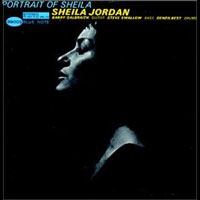 Das DebÞt der SÃĪngerin (Jahrgang 1928) war etwas besonderes: sie war weiÃ, kam aus einfachen
VerhÃĪltnissen, hing mit schwarzen Jazzmusikern ab (mit Charlie Parkers Pianist Duke Jordan
war sie sogar von 1952 bis 1962 verheiratet) und sang lieber instrumentalen Bebop als die Þblichen
Balladen. Bereits damals bevorzugte sie kleine Besetzungen statt groÃer Orchester und ist bis heute,
weit in ihren 80ern, immer noch aktiv, meist im Duo mit Kontrabassisten. Auf ihrer einzigen (?)
Blue Note-Platte ist sie mit Barry Galbraith (Gitarre), Steve Swallow (damls noch am
Kontrabass statt an der Bassgitarre) und Denzil Best (Schlagzeug) zu hÃķren. Tolle Platte.
Das DebÞt der SÃĪngerin (Jahrgang 1928) war etwas besonderes: sie war weiÃ, kam aus einfachen
VerhÃĪltnissen, hing mit schwarzen Jazzmusikern ab (mit Charlie Parkers Pianist Duke Jordan
war sie sogar von 1952 bis 1962 verheiratet) und sang lieber instrumentalen Bebop als die Þblichen
Balladen. Bereits damals bevorzugte sie kleine Besetzungen statt groÃer Orchester und ist bis heute,
weit in ihren 80ern, immer noch aktiv, meist im Duo mit Kontrabassisten. Auf ihrer einzigen (?)
Blue Note-Platte ist sie mit Barry Galbraith (Gitarre), Steve Swallow (damls noch am
Kontrabass statt an der Bassgitarre) und Denzil Best (Schlagzeug) zu hÃķren. Tolle Platte.
(02.01.2013)
|
| Kenny Burrell: "Midnight Blue" (BLP 4123, 7. Jan. 1963) |
|
 Ein grooviges Album des Gitarristen und in den 90ern eine der meist
gesampelten Vorlagen fÞr den so genannten "Acid-Jazz".
Aber keine Sorge: es handelt sich um ein wirklich gutes Album, nur vielleicht
fÞr Jazzpuristen etwas zu "kommerziell" - aber was soll's?
Ein grooviges Album des Gitarristen und in den 90ern eine der meist
gesampelten Vorlagen fÞr den so genannten "Acid-Jazz".
Aber keine Sorge: es handelt sich um ein wirklich gutes Album, nur vielleicht
fÞr Jazzpuristen etwas zu "kommerziell" - aber was soll's?
An den Congas ist der legendÃĪre Ray Barretto dabei und
das Saxofon blÃĪst Stanley Turrentine - auch eine Legende!

 Mehr ...
Mehr ...
This album is one of guitarist Kenny Burrell's best-known sessions for the Blue Note label. Burrell is matched with tenor saxophonist Stanley Turrentine, bassist Major Holley, drummer Bill English, and Ray Barretto on conga for a blues-oriented date highlighted by "Chitlins Con Carne," "Midnight Blue," "Saturday Night Blues," and the lone standard "Gee Baby Ain't I Good to You."
(by Scott Yanow, All Music Guide)
A Detroit-born guitarist, Burrell recorded a plethora of albums for Blue Note during several different stints with Alfred Lionâs label. This album is arguably the pinnacle of Burrellâs work: a small combo recording featuring tenor saxophonist, Stanley Turrentine, and augmented by Hispanic percussionist Ray Barretto. The latterâs congas add a piquant Latin flavor to the tasty âChitlins Con Carneâ and the equally groovy âWavy Gravy,â a mid-tempo blues with a walking bass line. Burrell achieves the perfect balance between virtuosity and deep emotional expression.
(www.udiscovermusic.com)
Platz16bei uDiscoverMusic.
|
| Donald Byrd: "A New Perspective" (BLP 4124, 12. Nov. 1963) |
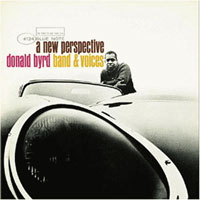 Der Klassiker von Donald Byrd mit einem der schÃķnsten Blue Note-Cover,
wo Byrd mit einem der schÃķnsten Autos dieser Zeit (aller Zeiten?),
dem Jaguar E-Type, posiert. ErwÃĪhnenswert ist auch der eingesetzte
Gospelchor.
Der Klassiker von Donald Byrd mit einem der schÃķnsten Blue Note-Cover,
wo Byrd mit einem der schÃķnsten Autos dieser Zeit (aller Zeiten?),
dem Jaguar E-Type, posiert. ErwÃĪhnenswert ist auch der eingesetzte
Gospelchor.

 Mehr ...
Mehr ...
NatÞrlich nicht neu, aber eine Platte, die eine Hervorhebung mehr als verdient. Und sich bei dem Preis jetzt problemlos und ohne Reue in die Sammlung integrieren lÃĪsst. Erschienen in der Blue Note Rudy Van Gelder-Remaster Serie, also klanglich absolut top. Van Gelder hat 1963 in seinem Tonstudio fÞr die Aufnahmen gesorgt und sie vor ein paar Jahren mit 24-Bit-Technologie selbst restauriert und remastert.
Aber nun zur Musik. Ich bin weder Jazzkenner noch âFan. Das wird auch nichts mehr. Aber was Donald Byrd und sein Septett um Hank Mobley (Sax), Kenny Burrell (Gitarre) und Herbie Hancock (Piano) fÞr A New Perspective einspielten, lÃĪsst mich noch ein jedes Mal dahinschmelzen. TatsÃĪchlich ist das Album so etwas wie âeine neue Sichtweiseâ, denn die Songs sind einfach und klar strukturiert, die solistischen AusflÞge den Songs angemessen und wenn Donald Byrd im einfach gÃķttlichen Christo Redentor (der Song, den ich auf meiner Beerdigung hÃķren will) zum Trompetensolo ansetzt, dann erfasst mich ein WohlgefÞhl, wie ich es nur selten hatte in 35 Jahren aktivem MusikhÃķren. Und ich bin eigentlich jemand, der Trompetensoli in Musik nicht braucht.
Was diese Aufnahmen Þber das Ãbliche hinweg hebt, ist die Integration eines 8-kÃķpfigen Gospelchores, den Duke Pearson innovativ arrangierte. Die Damen sind nur lautmalerisch zu hÃķren und befÃķrdern A New Perspective in eine andere Umlaufbahn. Diese Stimmung, dieses GefÞhl, das ist nicht von dieser Welt! Das ist einzigartig! Das ist wunderschÃķn! Das ist so bezwingend, wie Musik nur sein kann! Upliftend im wahrsten Sinne des Wortes. Als ich Christo Redentor das erste Mal hÃķrte, ich stand in der Mittagssonne vor Norman Jayâs Good Times Bus beim Londoner Notting Hill Carnival, glaubte ich tatsÃĪchlich zu schweben!
(Glitterhouse)
This unusual set (reissued on CD by Blue Note) was one of the most successful uses of a gospel choir in a jazz context. Trumpeter Donald Byrd and a septet that also includes tenor saxophonist Hank Mobley, guitarist Kenny Burrell, and pianist Herbie Hancock are joined by an eight-voice choir directed by Coleridge Perkinson. The arrangements by Duke Pearson are masterful and one song, "Cristo Redentor," became a bit of a hit. This is a memorable effort that is innovative in its own way, a milestone in Donald Byrd's career.
(by Scott Yanow, All Music Guide)
This album is arguably Motor City trumpeter Donald Byrdâs greatest: an inspired coalescence of hard bop and African American sacred music. Herbie Hancock and Hank Mobley feature in a seven-piece band which is augmented by a choir and used by Byrd as a compositional tool to infuse modern jazz with the spirituality of gospel music. Thereâs a fervent church feel to tracks such as âElijahâ and âChantâ with their call and response cadences. But the albumâs centerpiece is âCristo Redentor,â a haunting ballad arranged by its composer, Duke Pearson.
(www.udiscovermusic.com)
Platz31bei uDiscoverMusic.
|
| Horace Parlan: "Happy Frame Of Mind" (BLP 4134, 25. Feb. 1963) |
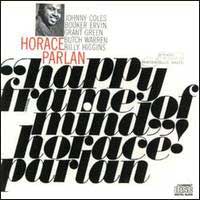 |
| Jackie McLean: "One Step Beyond" (BLP 4137, 30. April 1963) |
 |
| Joe Henderson: "Page One" (BLP 4140, 03. Juni 1963) |
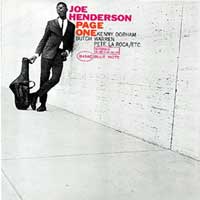 Das Blue Note-DebÞt des Tenorsaxofonisten enthÃĪlt mit "Blue Bossa"
vom an der Aufnahmesession beteiligten Trompeter Kenny Dorham die
Originalversion eines Jazzklassikers, den wohl die meisten kennen - wenn
auch nicht dem Namen nach. FÞr mich bleibt aber unerklÃĪrlich, warum der
hier ausgezeichnet aufspielende Pianist McCoy Tyner als einziger
auf dem Froncover namentlich nicht genannt wird, sondern nur unter "etc."
firmiert.
Das Blue Note-DebÞt des Tenorsaxofonisten enthÃĪlt mit "Blue Bossa"
vom an der Aufnahmesession beteiligten Trompeter Kenny Dorham die
Originalversion eines Jazzklassikers, den wohl die meisten kennen - wenn
auch nicht dem Namen nach. FÞr mich bleibt aber unerklÃĪrlich, warum der
hier ausgezeichnet aufspielende Pianist McCoy Tyner als einziger
auf dem Froncover namentlich nicht genannt wird, sondern nur unter "etc."
firmiert.

 Mehr ...
Mehr ...
Tenor saxophonist Joe Henderson's debut as a leader is a particularly strong and historic effort. With major contributions made by trumpeter Kenny Dorham, pianist McCoy Tyner, bassist Butch Warren, and drummer Pete La Roca, Henderson (who already had a strikingly original sound and a viable inside/outside style) performs six generally memorable compositions on this CD reissue. Highlights include the original versions of Dorham's "Blue Bossa" and Henderson's "Recorda Me." It's highly recommended.
(by Scott Yanow, All Music Guide)
Renowned for his gruff but soulful tenor saxophone tone, Ohio-born Henderson was 26 when he recorded his debut LP, Page One, which opens with the classic track, âBlue Bossa,â written by trumpeter Kenny Dorham, who also plays on the album. From the sensuous rhythms of the Brazilian bossa nova style, the album moves on to encompass driving hard bop (âHomestretchâ), reflective ballads (âLa Meshaâ), cool modal jazz (âRecorda Meâ) and slow, after-hours blues (âOut Of The Nightâ). A stunning debut.
(www.udiscovermusic.com)
Platz24bei uDiscoverMusic.
|
| Grachan Moncur III: "Evolution" (BLP 4153, 21. Nov. 1963) |
 Als eines der wenigen Alben des Posaunisten und Komponisten Grachan Moncur III unter eigenem
Namen ist "Evolution" eine fÞr Blue Note-VerhÃĪltnisse relativ "sperrige" Angelegenheit,
auch wenn der Begriff "Free Jazz" unzutreffend wÃĪre - eher passt "Avantgarde".
Komplexe Kompositionen, eingespielt von einem Spitzenensemble (Lee Morgan
an der Trompete, Bobby Hutcherson am Vibraphon, Jackie McLean
am Altsaxophon, Bob Cranshaw am Bass und der damals 17jÃĪhrige Tony Williams am Schlagzeug)
zeichnen dieses Highlight von Blue Note aus.
Als eines der wenigen Alben des Posaunisten und Komponisten Grachan Moncur III unter eigenem
Namen ist "Evolution" eine fÞr Blue Note-VerhÃĪltnisse relativ "sperrige" Angelegenheit,
auch wenn der Begriff "Free Jazz" unzutreffend wÃĪre - eher passt "Avantgarde".
Komplexe Kompositionen, eingespielt von einem Spitzenensemble (Lee Morgan
an der Trompete, Bobby Hutcherson am Vibraphon, Jackie McLean
am Altsaxophon, Bob Cranshaw am Bass und der damals 17jÃĪhrige Tony Williams am Schlagzeug)
zeichnen dieses Highlight von Blue Note aus.
(27.05. 2009) |
Grant Green: "Idle Moments" (BLP 4154, 15. Nov. 1963) |
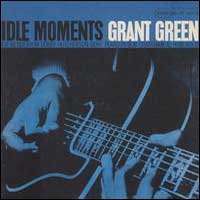 "Idle Moments", so was wie "Momente des MÞÃiggangs",
deutet natÞrlich auf eine sehr lÃĪssige Spielart des Jazz hin,
die hier der Gitarrist Grant Green mit seinen exzellenten Mitspielern
(u. a. Joe Henderson am Tenorsax und Bobby
Hutcherson am Vibraphon) pflegt. Vor allem aber swingt die Platte
ungemein. Mit bÃķser Zunge kÃķnnte man das als "Barjazz"
bezeichnen, aber warum ist das ein Schimpfwort? Diese Band spielt hier
gleichzeitig vÃķllig lÃĪssig und total virtuos - und ich hÃĪtte
sie dabei extrem gerne in einem Jazzclub erlebt! Ansonsten: vielleicht
DIE PERFEKTE BLUE NOTE PLATTE?
"Idle Moments", so was wie "Momente des MÞÃiggangs",
deutet natÞrlich auf eine sehr lÃĪssige Spielart des Jazz hin,
die hier der Gitarrist Grant Green mit seinen exzellenten Mitspielern
(u. a. Joe Henderson am Tenorsax und Bobby
Hutcherson am Vibraphon) pflegt. Vor allem aber swingt die Platte
ungemein. Mit bÃķser Zunge kÃķnnte man das als "Barjazz"
bezeichnen, aber warum ist das ein Schimpfwort? Diese Band spielt hier
gleichzeitig vÃķllig lÃĪssig und total virtuos - und ich hÃĪtte
sie dabei extrem gerne in einem Jazzclub erlebt! Ansonsten: vielleicht
DIE PERFEKTE BLUE NOTE PLATTE?
(Feb. 2006)

 Mehr ...
Mehr ...
This languid, seductive gem may well be Grant Green's greatest moment on record. Right from the opening bars of the classic title cut, Idle Moments is immediately ingratiating and accessible, featuring some of Green's most stylish straight jazz playing. Whether he's running warm (pianist Duke Pearson's "Idle Moments"), cool (the Modern Jazz Quartet's "Django"), or a bit more up-tempo (Pearson's "Nomad," his own "Jean de Fleur"), Green treats the material with the graceful elegance that was the hallmark of his best hard bop sessions, and that quality achieves its fullest expression here. He's helped by an ensemble that, as a sextet, is slightly larger and fuller-sounding than usual, and there's plenty of room for solo explorations on the four extended pieces. Pearson's touch on the piano is typically warm, while two players best known on Blue Note for their modernist dates mellow out a bit -- the cool shimmer of Bobby Hutcherson's vibes is a marvelously effective addition to the atmosphere, while Joe Henderson plays with a husky, almost Ike Quebec-like breathiness. That cushion of support helps spur Green to some of the loveliest, most intimate performances of his career -- no matter what the tempo, it's as if his guitar is whispering secrets in your ear. It's especially true on the dreamy title track, though: a gorgeous, caressing, near-15-minute excursion that drifts softly along like a warm, starry summer night. Even more than the two-disc set The Complete Quartets With Sonny Clark, Idle Moments is the essential first Green purchase, and some of the finest guitar jazz of the hard bop era.
(by Steve Huey, All Music Guide)
Many of Greenâs Blue Note sessions featured him in small combos that gave ample space to showcase his guitar skills. But this album, arguably the St. Louis fretboard maestroâs magnum opus, featured him in a sextet setting using more complex arrangements and denser textures. Though his co-stars included Joe Henderson, Duke Pearson, and Bobby Hutcherson, they didnât eclipse him, allowing Green to shine as both a soloist and an ensemble player. The albumâs four tracks range from zippy swingers (âJean De Fleurâ) to pensive ballads (Duke Pearsonâs epic title song).
(www.udiscovermusic.com)
Platz12bei uDiscoverMusic.
|
Lee Morgan: "The Sidewinder" (BLP 4157, 21. Dez. 1963) |
 "Sidewinder" ist nicht nur das Comeback des Trompeters bei seinem
alten Label als Leader, sondern - so weit ich weià - sogar einer der grÃķÃten
Hits des Blues Note Labels Þberhaupt aus den 60ern! Zusammen mit Joe
Henderson (tsax), Barry Harris (p), Bob Cranshaw (b)
und Billy Higgins (dr) liefert in Lee Morgan in 5 Eigenkompositionen
zwischen 6 und 10 1/2 Minuten, vor allem im blusigen Titelsong, die Vorlage
fÞr viele weitere Blue Note Alben, die da noch kommen sollten ...
"Sidewinder" ist nicht nur das Comeback des Trompeters bei seinem
alten Label als Leader, sondern - so weit ich weià - sogar einer der grÃķÃten
Hits des Blues Note Labels Þberhaupt aus den 60ern! Zusammen mit Joe
Henderson (tsax), Barry Harris (p), Bob Cranshaw (b)
und Billy Higgins (dr) liefert in Lee Morgan in 5 Eigenkompositionen
zwischen 6 und 10 1/2 Minuten, vor allem im blusigen Titelsong, die Vorlage
fÞr viele weitere Blue Note Alben, die da noch kommen sollten ...

 Mehr ...
Mehr ...
ïŧŋ
Der in Philadelphia geborene Trompeter und hervorragende Bebop-Stilist Lee Morgan sammelte seine ersten Erfahrungen bei Dizzy Gillespie und Art Blakey, bevor er sich in den frühen 60ern als Leader mit eigenen Aufnahmen bei Blue Note hervortat. Obwohl musikalisch Gillespie und Clifford Brown verpflichtet, entwickelte er doch bald seine persÃķnliche Stimme, die Halb-Ventil-Effekte ebenso beinhaltete wie Latin-EinflÞsse und volltÃķnende flieÃende Melodien.
WÃĪhrend viele von Morgans spÃĪteren Blue Note Sessions zusammen mit dem Saxophonisten Hank Mobley entstanden, stellt The Sidewinder den noch jungen Tenoristen Joe Henderson an der Seite des Detroiter Pianisten Barry Harris, des Bassisten Bob Cranshaw und des Schlagzeugers Billy Higgins in den Vordergrund. Neben dem TitelstÞck, einem konventionellen 24-taktigen Blues, ist "Totem Pole" der kompositorische Mittelpunkt, ein Latin-Moll-Groove mit einen herausragenden Solo von Joe Henderson. Das ist die Art entspannter, durch geistreiche Darbietungen belebter Studiotermine, die das RÞckgrat des Blue Note-Katalogs ausmachen.
(Fred Goodman, Amazon.de)
In the age of the long-haired rock groups, a jazz hit single was a rarity. In early 1965, however, Lee Morganâs âThe Sidewinderâ, a catchy soul jazz tune riding a jaunty, danceable groove, broke into the US Hot 100, peaking at No.81. The parent album, released the previous year, when Morgan was 25, did even better, reaching No.25 on the US albums chart and becoming the biggest-selling LP in Blue Noteâs history. Though dominated by its highly infectious title song, The Sidewinder is not a one-track wonder. Morgan, together with tenor saxophonist Joe Henderson, pianist Barry Harris, bassist Bob Cranshaw and drummer Billy Higgins, serves up some serious hard bop blowing. Notable for its absence of ballads, The Sidewinder offers a selection of Morgan-penned uptempo numbers, including the super-lively âHocus Pocusâ and slightly mellower âTotem Poleâ, which are characterised by strong solos and taut group interplay.
(www.udiscovermusic.com)
The Sidewinder was trumpeter Lee Morganâs â and for a time, Blue Noteâs â greatest commercial triumph. As a single, the infectious title track with its jaunty, danceable groove, made Billboardâs Hot 100, helping the parent album to ascend to No. 10 in the US R&B albums chart. The rest of the album was more exploratory, ranging from Latin-inflected pieces (âTotem Poleâ) to advanced hard bop (âGaryâs Notebookâ and âHocus-Pocusâ). Morganâs collaborators included Joe Henderson and pianist Barry Harris. Even today, The Sidewinder continues to be one of the top-selling albums in Blue Noteâs catalogue.
(www.udiscovermusic.com)
Platz8bei uDiscoverMusic.
|
| Jackie McLean: "Destination Out" (BLP 4165, 20. Sept. 1963) |
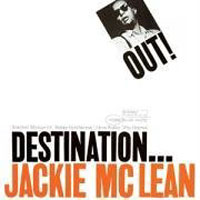 Weil ich letztendlich kein Kenner der Musik von Altsaxophonist Jackie
McLean bin, greife ich nur gelegentlich zu, wenn ich eine seiner Reissue-CDs
in der Grabbelkiste finde. Zwei, dreimal habe ich dabei interessante,
aber mich nicht wirklich begeisternde Aufnahmen entdeckt, aber "Destination
Out" ist ein echter Klassiker: lediglich vier Songs, alles Originalkompositionen,
drei von Posaunist Gracan Moncur III, eine von McLean
selber, jeweils um die 10 Minuten lang, von den beiden BlÃĪsern zusammen
mit der Rhythmusgruppe Roy Haynes (dr) und Larry Ridley
(b) und dem Vibraphonspieler Bobby Hutcherson
als "Pianoersatz" eingespielt, bringen genau die richtige Mischung
aus Form und Freiheit, altem und neuem Jazz. Und wie immer natÞrlich mit
einem fantastischen Sound Dank Rudy van Gelder.
Weil ich letztendlich kein Kenner der Musik von Altsaxophonist Jackie
McLean bin, greife ich nur gelegentlich zu, wenn ich eine seiner Reissue-CDs
in der Grabbelkiste finde. Zwei, dreimal habe ich dabei interessante,
aber mich nicht wirklich begeisternde Aufnahmen entdeckt, aber "Destination
Out" ist ein echter Klassiker: lediglich vier Songs, alles Originalkompositionen,
drei von Posaunist Gracan Moncur III, eine von McLean
selber, jeweils um die 10 Minuten lang, von den beiden BlÃĪsern zusammen
mit der Rhythmusgruppe Roy Haynes (dr) und Larry Ridley
(b) und dem Vibraphonspieler Bobby Hutcherson
als "Pianoersatz" eingespielt, bringen genau die richtige Mischung
aus Form und Freiheit, altem und neuem Jazz. Und wie immer natÞrlich mit
einem fantastischen Sound Dank Rudy van Gelder.
(24.05.2009)

 Mehr ...
Mehr ...
Like Eric Dolphy before him, Jackie McLean sought to create a kind of vanguard "chamber jazz" that still had the blues feel and â occasionally â the groove of hard bop, though with rounded, moodier edges. Destination Out! was the album on which he found it. Still working with Grachan Moncur III and Bobby Hutcherson â his direct spiritual connection to Dolphy â McLean changed his rhythm section by employing drummer Roy Haynes and bassist Larry Ridley. This combination proved a perfect balance of the four elements. The program is four tunes, three of which were written by Moncur. If there was a perfect Blue Note session after John Coltrane's Blue Train, this was it. Opening with a ballad was a novel idea in 1966, but McLean uses Moncur's love and hate to reveal all the tonal possibilities within this group of musicians, and the textural interplay that exists in the heightened sense of form, time breaks, and rhythm changes. As begun on One Step Beyond, the notion of interval is key in this band, and an elemental part of Moncur's composition. The horn lines are spare, haunting, warm, and treated as textural elements by Hutcherson's vibes. On the tune "Esoteric," Hutcherson and Haynes throw complex rhythmic figures into the mix. Moncur's writing is angular, resembling Ornette's early-'60s melodic notions more than Coltrane's modal considerations. Hutcherson's solo amid the complex, knotty melodic frame is just sublime. "Khalil the Prophet" is McLean's only contribution compositionally to the album, but it's a fine one. Using a hard bop lyric and a shape-shifting sense of harmonic interplay between the three front-line players, McLean moves deeply into a blues groove without giving into mere 4/4 time structures. The architecture of his solo is wonderfully obtuse, playing an alternating series of eighths, 12ths, and even 16ths against Hutcherson's wide-open comping and arpeggio runs. The set ends with Moncur's "Riff Raff," a strolling blues that makes full use of counterpoint on the vibes. Moncur sets his solo against McLean's melodic engagement of Hutcherson, forcing both men into opposition positions that get resolved in a sultry, funky, shimmering blues groove. Of all of McLean's Blue Note dates, so many of which are classic jazz recordings, Destination Out! stands as the one that reveals the true soulfulness and complexity of his writing, arranging, and "singing" voice.
(by Thom Jurek, All Music Guide)
|
Eric Dolphy: "Out To Lunch" (BLP 4163, 25. Febr. 1964) |
 Eric Dolphy passte als "Freigeist" mit seiner Musik vielleicht
nicht ganz in das Blue Note-Konzept. Vielleicht gerade deshalb ein tolles
Album? Oder wegen der tollen Band: Freddie Hubbard
(tp), Bobby Hutcherson (vib), Richard Davis
(db) und Tony Williams (dr).
Eric Dolphy passte als "Freigeist" mit seiner Musik vielleicht
nicht ganz in das Blue Note-Konzept. Vielleicht gerade deshalb ein tolles
Album? Oder wegen der tollen Band: Freddie Hubbard
(tp), Bobby Hutcherson (vib), Richard Davis
(db) und Tony Williams (dr).
(28.03.2010)

 Mehr ...
Mehr ...
ïŧŋ
Was die Kunst der musikalischen Improvisation betrifft, so gehörte Eric Dolphy zu den Mutigsten, leidenschaftlichsten und spieltechnisch Besten, die in den 60er Jahren zu musikalischer Reife gelangten. Angefangen mit seinem Durchbruch zusammen mit Chico Hamilton und Charles Mingus, über die richtungsweisende Zeit seiner Zusammenarbeit mit John Coltrane, bis hin zu seinen brillanten Soloaufnahmen für das Prestige-Label faßte dieser innovative Blättchenbläser das Beste aus den Traditionen des Swing und Bebop zusammen -- von Benny Carter bis hin zu Bird. Monks Freiheitsbegriff hinsichtlich Rhythmus, Melodie und Harmonien legte er dabei noch großzügiger aus. Dolphy, dieser Hexenmeister der Gefühle, besaß einen ausgeprägten Hang zur Komik. Erkennbar wird er im rhythmischen, trunkenen Schaukeln des Themas bei "Straight Up and Down". Monks Einfluß wird in Dolphys cleveren Dissonanzen und betont gespielten Blues-Sätzen bei "Out to Lunch" deutlich (seiner einzigen Aufnahme unter dem Blue-Note-Label, vollendet kurz vor seinem viel zu frühen Tod). Richard Davis, Bobby Hutcherson und Tony Williams sind Meister des Rhythmus. Als solche halten sie die Zeit nach Belieben an, machen sich den so entstehenden Raum zu eigen, demontieren Harmonien durch das Aufsetzen kubistischer Rhythmusverschiebungen. Sie versammeln sich um Freddie Hubbards brummelnde Trompete und um Dolphys melodietragende Bassklarinette (so in dem im Stile Monks gehaltenen "Hat and Beard"), um seine wimmernde Altklarinette (in den kampflustigen Parodien auf den Titelsong) und um seine lebendige Querflöte (im lyrischen, swingenden "Gazzelloni"). Out to Lunch ist die am weitesten gehende Umsetzung der Dolphyschen Visionen.
(Chip Stern, Amazon)
Out to Lunch stands as Eric Dolphy's magnum opus, an absolute pinnacle of avant-garde jazz in any form or era. Its rhythmic complexity was perhaps unrivaled since Dave Brubeck's Time Out, and its five Dolphy originals -- the jarring Monk tribute "Hat and Beard," the aptly titled "Something Sweet, Something Tender," the weirdly jaunty flute showcase "Gazzelloni," the militaristic title track, the drunken lurch of "Straight Up and Down" -- were a perfect balance of structured frameworks, carefully calibrated timbres, and generous individual freedom. Much has been written about Dolphy's odd time signatures, wide-interval leaps, and flirtations with atonality. And those preoccupations reach their peak on Out to Lunch, which is less rooted in bop tradition than anything Dolphy had ever done. But that sort of analytical description simply doesn't do justice to the utterly alien effect of the album's jagged soundscapes. Dolphy uses those pet devices for their evocative power and unnerving hints of dementia, not some abstract intellectual exercise. His solos and themes aren't just angular and dissonant -- they're hugely so, with a definite playfulness that becomes more apparent with every listen. The whole ensemble -- trumpeter Freddie Hubbard, vibist Bobby Hutcherson, bassist Richard Davis, and drummer Tony Williams -- takes full advantage of the freedom Dolphy offers, but special mention has to be made of Hutcherson, who has fully perfected his pianoless accompaniment technique. His creepy, floating chords and quick stabs of dissonance anchor the album's texture, and he punctuates the soloists' lines at the least
expected times, suggesting completely different pulses. Meanwhile, Dolphy's stuttering vocal-like effects and oddly placed pauses often make his bass clarinet lines sound like they're tripping over themselves. Just as the title Out to Lunch suggests, this is music that sounds like nothing so much as a mad gleam in its creator's eyes.
(by Steve Huey, All Music Guide)
Eric Dolphy was a true original with his own distinctive styles on alto, flute, and bass clarinet. His music fell into the "avant-garde" category yet he did not discard chordal improvisation altogether (although the relationship of his notes to the chords was often pretty abstract). While most of the other "free jazz" players sounded very serious in their playing, Dolphy's solos often came across as ecstatic and exuberant. His improvisations utilized very wide intervals, a variety of nonmusical speechlike sounds, and its own logic. Although the alto was his main axe, Dolphy was the first flutist to move beyond bop (influencing James Newton) and he largely introduced the bass clarinet to jazz as a solo instrument. He was also one of the first (after Coleman Hawkins) to record unaccompanied horn solos, preceding Anthony Braxton by five years.
Eric Dolphy first recorded while with Roy Porter & His Orchestra (1948-1950) in Los Angeles, he was in the Army for two years, and he then played in obscurity in L.A. until he joined the Chico Hamilton Quintet in 1958. In 1959 he settled in New York and was soon a member of the Charles Mingus Quartet. By 1960 Dolphy was recording regularly as a leader for Prestige and gaining attention for his work with Mingus, but throughout his short career he had difficulty gaining steady work due to his very advanced style. Dolphy recorded quite a bit during 1960-1961, including three albums cut at the Five Spot while with trumpeter Booker Little, Free Jazz with Ornette Coleman, sessions with Max Roach, and some European dates.
Late in 1961 Dolphy was part of the John Coltrane Quintet; their engagement at the Village Vanguard caused conservative critics to try to smear them as playing "anti-jazz" due to the lengthy and very free solos. During 1962-1963 Dolphy played third stream music with Gunther Schuller and Orchestra U.S.A., and gigged all too rarely with his own group. In 1964 he recorded his classic Out to Lunch for Blue Note and traveled to Europe with the Charles Mingus Sextet (which was arguably the bassist's most exciting band, as shown on The Great Concert of Charles Mingus). After he chose to stay in Europe, Dolphy had a few gigs but then died suddenly from a diabetic coma at the age of 36, a major loss.
Virtually all of Eric Dolphy's recordings are in print, including a nine-CD box set of all of his Prestige sessions. In addition, Dolphy can be seen on film with John Coltrane (included on The Coltrane Legacy) and with Mingus from 1964 on a video released by Shanachie.
(by Scott Yanow, All Music Guide)
Out To Lunch! boasts one of Blue Noteâs most iconic Reid Miles-designed covers, perfectly mirroring the exploratory nature of Dolphyâs groundbreaking music. A rising star of jazzâs avant-garde scene who could play alto sax, flute and clarinet, LA-born Dolphy recorded this, his only session as a leader for Blue Note, in February 1964, but died before it was released. The album highlights not only Dolphyâs ability as an instrumentalist but his talent as a composer. Heâs accompanied by an exciting young band that includes trumpeter Freddie Hubbard, vibraphonist Bobby Hutcherson â whose shimmering chords give the music a dreamy feel â and drummer Tony Williams, then just 18. âHat And Beardâ, propelled by Richard Davisâ walking bassline, is a quirky tribute to Thelonious Monk that sets the tone for an album that moves beyond the constraints of bebop and into the realm of unfettered free jazz, yet remains tightly focused. Though he recorded for several other labels, this solitary Blue Note offering remains the go-to album in Dolphyâs canon and is one of the undoubted jewels in the labelâs crown. Every guide to Blue Note should include it.
(www.udiscovermusic.com)
A gifted multi-reed exponent and flutist, the LA-born Eric Dolphy only made one album for Blue Note, but it helped to bring him immortality, even though it was released a few months after his untimely death in June 1964. Considered a leading light of the avant-garde scene, Dolphy created a genuine masterpiece with the innovative Out To Lunch! , featuring the combined talents of Freddie Hubbard, Bobby Hutcherson, bassist Richard Davis, and drummer Tony Williams. Dolphy alternates between bass clarinet, flute, and alto saxophone on five self-written tunes that range from the avant-bebop swing of âHat and Beardâ and âGazzelloniâ to more discursive pieces like the title track and comedic âStraight Up & Down.â Out To Lunch! is a touchstone in avant-garde jazz.
(www.udiscovermusic.com)
Platz4bei uDiscoverMusic.
|
Andrew Hill: "Point Of Departure" (BLP 4167, 21. MÃĪrz 1964) |
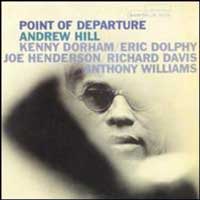

 Mehr ...
Mehr ...
Pianist and composer Andrew Hill is perhaps known more for this date than any other in his catalogue -- and with good reason. Hill's complex compositions straddled many lines in the early to mid-1960s and crossed over many. Point of Departure, with its all-star lineup (even then), took jazz and wrote a new book on it, excluding nothing. With Eric Dolphy and Joe Henderson on saxophones (Dolphy also played clarinet, bass clarinet, and flute), Richard Davis on bass, Tony Williams on drums, and Kenny Dorham on trumpet, this was a cast created for a jazz fire dance. From the opening moments of "Refuge," with its complex minor mode intro that moves headlong via Hill's large, open chords that flat sevenths, ninths, and even 11ths in their striding to move through the mode, into a wellspring of angular hard bop and minor-key blues. Hill's solo is first and it cooks along in the upper middle register, almost all right hand ministrations, creating with his left a virtual counterpoint for Davis and a skittering wash of notes for Williams. The horn solos in are all from the hard bop book, but Dolphy cuts his close to the bone with an edgy tone. "New Monastery," which some mistake for an avant-garde tune, is actually a rewrite of bop minimalism extended by a diminished minor mode and an intervallic sequence that, while clipped, moves very quickly. Dorham solos to connect the dots of the knotty frontline melody and, in his wake, leaves the space open for Dolphy, who blows edgy, blue, and true into the center, as Hill jumps to create a maelstrom by vamping with augmented and suspended chords. Hill chills it out with gorgeous legato phrasing and a left-hand ostinato that cuts through the murk in the harmony. When Henderson takes his break, he just glides into the chromatically elegant space created by Hill, and it's suddenly a new tune. This disc is full of moments like this. In Hill's compositional world, everything is up for grabs. It just has to be taken a piece at a time, and not by leaving your fingerprints all over everything. In "Dedication," where he takes the piano solo further out melodically than on the rest of the album combined, he does so gradually. You cannot remember his starting point, only that there has been a transformation. This is a stellar date, essential for any representative jazz collection, and a record that, in the 21st century, still points the way to the future for jazz.
(by Thom Jurek, AMG)
Like Thelonious Monk before him, the fiercely individualistic pianist/composer Andrew Hill ploughed a lone furrow away from jazz trends. His unique compositional style and jaggedly idiosyncratic approach to the piano is abundantly evident on Point Of Departure, arguably Hillâs most enduring work, which features Eric Dolphy, Joe Henderson, Kenny Dorham, and teenage drummer Tony Williams. The music is complex, asymmetrical, edgy, and abstract though a swing groove often prevails to give it a degree of accessibility. It remains a totemic LP of the post-bop epoch.
(www.udiscovermusic.com)
Platz10bei uDiscoverMusic.
|
| Lee Morgan: "In Search Of The New Land" (BLP 4169, 15. Feb. 1964) |
 Und hier ein weiteres Blue-Note-Highlight aus dieser Zeit. Lee Morgan
galt damals als eines der grÃķÃten Talente an der Trompete, bevor er leider
in den Drogensumpf geriet. Auf dieser Platte gibt es Hard Bob vom Feinsten:
5 Eigenkompositionen von Morgan, unter denen das 15minÞtige TitelstÞck
direkt zu Beginn besonders herausragt. Die Band ist so ziemlich das Beste,
was man bei Blue Note damals aufgefahren hat: Wayne
Shorter am Tenorsaxofon, Gitarrist Grant Green,
Pianist Herbie Hancock, Bassist Reggie Worman
und Trommler Billy Higgins. Muss ich auÃerdem erwÃĪhnen, dass
Rudy van Gelder wie immer einen phantastischen Sound hinbekommen
hat?
Und hier ein weiteres Blue-Note-Highlight aus dieser Zeit. Lee Morgan
galt damals als eines der grÃķÃten Talente an der Trompete, bevor er leider
in den Drogensumpf geriet. Auf dieser Platte gibt es Hard Bob vom Feinsten:
5 Eigenkompositionen von Morgan, unter denen das 15minÞtige TitelstÞck
direkt zu Beginn besonders herausragt. Die Band ist so ziemlich das Beste,
was man bei Blue Note damals aufgefahren hat: Wayne
Shorter am Tenorsaxofon, Gitarrist Grant Green,
Pianist Herbie Hancock, Bassist Reggie Worman
und Trommler Billy Higgins. Muss ich auÃerdem erwÃĪhnen, dass
Rudy van Gelder wie immer einen phantastischen Sound hinbekommen
hat?
(Oktober 2006)

 Mehr ...
Mehr ...
This set (the CD reissue is a duplicate of the original LP) is one of the finest Lee Morgan records. The great trumpeter contributes five challenging compositions ("Search for the New Land," "The Joker," "Mr. Kenyatta," "Melancholee," and "Morgan the Pirate") that deserve to be revived. Morgan, tenor saxophonist Wayne Shorter, guitarist Grant Green, pianist Herbie Hancock, bassist Reggie Workman, and drummer Billy Higgins are all in particularly creative form on the fresh material, and they stretch the boundaries of hard bop (the modern mainstream jazz of the period). The result is a consistently stimulating set that rewards repeated listenings.
Scott Yanow, All Music Guide)
Signing to Blue Note as a teenage trumpet prodigy in 1956, Morgan had been with the label a decade when the company issued Search For The New Land. It had been recorded two years earlier but was shelved when Morgan hit the US pop charts with the single and album, The Sidewinder. Morgan leads an all-star sextet â including Wayne Shorter, Herbie Hancock, and Grant Green â on five enthralling self-penned compositions, that range from the beautifully meditative title track to the African-tinged hard bop of âMr. Kenyatta.â The Sidewinder might have made Lee Morgan a household name but Search For The New Land highlighted the depth of his artistry.
Platz23bei uDiscoverMusic.
|
| Herbie Hancock: "Empyrean Isles" (BLP 4175, 17. Juni 1964) |


 Mehr ...
Mehr ...
My Point of View and Inventions and Dimensions found Herbie Hancock exploring the fringes of hard bop, working with a big band and a Latin-flavored percussion section, respectively. On Empyrean Isles, he returns to hard bop, but the results are anything but conventional. Working with cornetist Freddie Hubbard, bassist Ron Carter, and drummer Tony Williams â a trio just as young and adventurous as he was â Hancock pushes at the borders of hard bop, finding a brilliantly evocative balance between traditional bop, soul-injected grooves, and experimental, post-modal jazz. Hancock's four original concepts are loosely based on the myths of the Empyrean Isles, and they are designed to push the limits of the band and of hard bop. Even "Cantaloupe Island," well-known for its funky piano riff, takes chances and doesn't just ride the groove. "The Egg," with its minimal melody and extended solo improvisations, is the riskiest number on the record, but it works because each musician spins inventive, challenging solos that defy convention. In comparison, "One Finger Snap" and "Oliloqui Valley" (alternate takes of both tracks are included as bonuses on the CD reissue) adhere to hard bop conventions, but each song finds the quartet vigorously searching for new sonic territory with convincing fire. That passion informs all of Empyrean Isles, a record that officially established Hancock as a major artist in his own right.
(by Stephen Thomas Erlewine, All Music Guide)
This, Chicago pianist Hancockâs fourth offering for Blue Note, contained the funky jukebox hit, âCantaloupe Islandâ â a close cousin of his 1962 soul-jazz smash âWatermelon Manâ â but in the main was notable for being a progressive, post-bebop album characterized by envelope-pushing compositions built on advanced harmonic and melodic conceptions. The most outrÃĐ track is âThe Egg,â which with its mesmeric ostinato piano part, anticipates hip-hopâs looped samples and structures.
(www.udiscovermusic.com)
Platz34bei uDiscoverMusic.
|
Horace Silver Quintet: "Song For My Father" (BLP 4185, 26. Okt. 1964) |
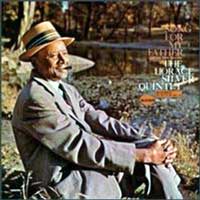

 Mehr ...
Mehr ...
ïŧŋ
Da der Titeltrack Steely Dan zu dem Song "Rikki, Don't Lose That Number" inspirierte, wurde Song For My Father bekannt als Jazzaufnahme, die tausend schlechte Pop-Platten nach sich zog. Aber ganz gleich welche Absichten Steely Dan und ihre vielen, vielen verzweifelten Imitatoren hatten, wir sollten die Schuld hieran nicht dem Pianisten Horace Silver in die Schuhe schieben: Dies ist eine der gefühlvollsten und erfreulichsten Sammlungen von Blue Note -- und das heißt schon etwas. Horace Silver war ein Pionier des Hard-Bop-Stils, der Gospel und R&B mit Jazz kombinierte, er war der Autor von vielen hervorragenden Kompositionen, zu denen nicht nur "Song For My Father" gehört, sondern auch "Opus De Funk", "Nica's Dream", "Senor Blues" und "The Preacher". Seine Quintette, die Tenorsaxofon und Trompete präsentieren, brachten solche Talente hervor wie die Trompeter Woody Shaw, Art Farmer und Donald Byrd. Auf Song For My Father kommt der Tenorsaxofonist Joe Henderson hinzu, der eine seiner typischen Melodien, "The Kicker", beisteuert. Neben der anspruchsvollen Arbeit mit dem Quintett bietet dieses Album auch ein schönes Porträt des Pianisten mit seinem Trio bei "Lonely Woman".
(Fred Goodman, Amazon)
One of Blue Note's greatest mainstream hard bop dates, Song for My Father is Horace Silver's signature LP and the peak of a discography already studded with classics. Silver was always a master at balancing jumping rhythms with complex harmonies for a unique blend of earthiness and sophistication, and Song for My Father has perhaps the most sophisticated air of all his albums. Part of the reason is the faintly exotic tint that comes from Silver's flowering fascination with rhythms and modes from overseas -- the bossa nova beat of the classic "Song for My Father," for example, or the Eastern-flavored theme of "Calcutta Cutie," or the tropical-sounding rhythms of "Que Pasa?" Subtle touches like these alter Silver's core sound just enough to bring out its hidden class, which is why the album has become such a favorite source of upscale ambience. Song for My Father was actually far less focused in its origins than the typical Silver project; it dates from the period when Silver was disbanding his classic quintet and assembling a new group, and it features performances from both bands (and, on the CD reissue with bonus tracks, three different sessions). Still, it hangs together remarkably well, and Silver's writing is at its tightest and catchiest. The title cut became Silver's best-known composition, partly because it provided the musical basis for jazz-rock group Steely Dan's biggest pop hit "Rikki Don't Lose That Number." Another hard bop standard is introduced here in the lone non-Silver tune, tenor saxophonist Joe Henderson's "The Kicker," covered often for the challenge of its stuttering phrases and intricate rhythms. Yet somehow it comes off as warm and inviting as the rest of the album, which is necessary for all jazz collections -- mainstream hard bop rarely comes as good as Song for My Father.
(by Steve Huey, AMG)
A Blue Note stalwart for many years â he joined the label in 1952 and stayed until 1979 â Horace Silver was a pianist who helped to establish not only the hard bop aesthetic but also the genreâs classic small-group format with its twin horn line-up. Silver and his quintet recorded many fine LPs for Blue Note, but Song For My Father, released in early 1965, is one of his finest for the label, even though it features two different incarnations of the pianistâs band. The âclassicâ line-up â featuring saxophonist Junior Cook and trumpeter Blue Mitchell â appears on just one cut, while their replacements (Joe Henderson and Carmel Jones, respectively) are present on four others (the closing track, âLonely Womanâ, is a trio recording between Silver, bassist Gene Taylor and drummer Roy Brooks). Henderson, in fact, brings an earthy robustness to the proceedings with his solo on the albumâs classic title track (whose intro was âborrowedâ by rock group Steely Dan for their 1974 song âRikki Donât Lose That Numberâ).
(www.udiscovermusic.com)
Although he co-founded The Jazz Messengers with Art Blakey, Silver preferred to forge a solo career and spent 28 years recording as a leader for Blue Note. His most famous album was this one, whose cornerstone was the infectious title song defined by a loping bass line, an elegant horn theme, and Joe Hendersonâs vigorous tenor sax solo. The 10-track album also featured elegant ballads (âLonely Womanâ and âCalcutta Cutieâ), Latin grooves (âQue Pasaâ) and swinging hard bop (âThe Kickerâ). The album remains an enduring monument to Silverâs genius.
(www.udiscovermusic.com)
Platz13bei uDiscoverMusic.
|
| Joe Henderson: "Inner Urge" (BLP 4189, 30. Nov. 1964) |
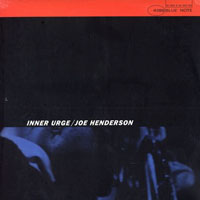 Ein weiteres vorzÞgliches Album eines zum Teil unterschÃĪtzten
Meisters des Tenorsaxofons. Garanten fÞr diese hohe QualitÃĪt
sind natÞrlich auch seine Mitstreiter, die alle grosse Erfahrungen
als Begleiter von SpitzenkÃķnnern am Tenorsax haben: McCoy Tyner
und Elvin Jones aus der Band von John Coltrane,
sowie Bob Cranshaw, der langjÃĪhrige Begleiter von Sonny
Rollins.
Ein weiteres vorzÞgliches Album eines zum Teil unterschÃĪtzten
Meisters des Tenorsaxofons. Garanten fÞr diese hohe QualitÃĪt
sind natÞrlich auch seine Mitstreiter, die alle grosse Erfahrungen
als Begleiter von SpitzenkÃķnnern am Tenorsax haben: McCoy Tyner
und Elvin Jones aus der Band von John Coltrane,
sowie Bob Cranshaw, der langjÃĪhrige Begleiter von Sonny
Rollins.
(09.06. 2010)

 Mehr ...
Mehr ...
This early recording by Joe Henderson is not only one of the finest of all of his fine recordings, but is also a high point for 1960s jazz. At this point in his career, Henderson was a full-time member of Horace Silver's combo and did not yet have a steady band in his hire. He is joined on Inner Urge by veterans of other combos: McCoy Tyner and Elvin Jones from John Coltrane's unit and Sonny Rollins sideman Bob Cranshaw. The presence of these luminaries aside, Inner Urge is home to two of Henderson's best (and best-loved) compositions: "Inner Urge" and "Isotope." The leader's solo on the title track is a marvelous thing, full of melody as well as anarchic bursts of sound, which is in perfect keeping with the spirit of the song's probing, searching theme. The other musicians support Henderson nicely as well as turning in some strong solos of their own. Tyner especially sounds fantastic on this record. Although not the equal of the leader in terms of the quality of his lines or the overall sense of composition of his solos, his performance is at least the rival of Henderson's in terms of raw kinetic power. The other great song on "Inner Urge," the Monk-ish "Isotope," is another ideal showcase for Henderson's total command of his instrument. The remaining tracks on Inner Urge are also fantastic, especially the wailing cry of "El Barrio" and the Henderson-altered head to "Night and Day," but the first side, even if taken alone, is by itself enough to guarantee this album as perhaps the best Henderson recorded in his long and illustrious career, and stands easily alongside the best records of the era.
(by Daniel Gioffre, All Music Guide)
|
Wayne Shorter: "Speak No Evil" (BLP 4194, 24. Dez. 1964) |
 "This is the perfect Wayne Shorter album" sagt der Kritiker
vom All Music Guide.
Und der Mann hat natÞrlich Recht. Zusammen mit Herbie
Hancock am Piano, Freddie Hubbard an der Trompete,
Elvin Jones am Schlagzeug und Ron Carter am Kontrabass entstand
am Heiligabend 1964 eine der schÃķnsten und zeitlosesten Jazzplatten,
die ich kenne.
"This is the perfect Wayne Shorter album" sagt der Kritiker
vom All Music Guide.
Und der Mann hat natÞrlich Recht. Zusammen mit Herbie
Hancock am Piano, Freddie Hubbard an der Trompete,
Elvin Jones am Schlagzeug und Ron Carter am Kontrabass entstand
am Heiligabend 1964 eine der schÃķnsten und zeitlosesten Jazzplatten,
die ich kenne.

 Mehr ...
Mehr ...
ïŧŋ
On his third date for Blue Note within a year, Wayne Shorter changed the bands that played on both Night Dreamer and Juju and came up with not only another winner, but also managed to give critics and jazz fans a different look at him as a saxophonist. Because of his previous associations with McCoy Tyner, Elvin Jones, and Reggie Workman on those recordings, Shorter had been unfairly branded with the "just-another-Coltrane-disciple" tag, despite his highly original and unusual compositions. Here, with only Jones remaining and his bandmates from the Miles Davis Quintet, Herbie Hancock and Ron Carter on board (with Freddie Hubbard filling out the horn section), Shorter at last came into his own and caused a major reappraisal of his earlier work. The odd harmonic frameworks used to erect "Fee-Fi-Fo-Fum," with its balladic structure augmented with a bluesy regimen of hard bop and open-toned modalism, create the illusion of a much larger band managing all that timbral space. Likewise on the title track, with its post-bop-oriented melodic line strewn across a wide chromatic palette of minors and Hancock's piano pushing through a contrapuntal set of semi-quavers, the avant-garde meets the hard bop of the '50s head on and everybody wins. The loping lyric of the horns and Hancock's vamping in the middle section during Shorter's solo reveals a broad sense of humor in the saxophonist's linguistics and a deep, more regimented sense of time and thematic coloration. The set ends with the beautiful "Wild Flower," a lilting ballad with angular accents by Hancock who takes the lyric and inverts it, finding a chromatic counterpoint that segues into the front line instead of playing in opposition. The swing is gentle but pronounced and full of Shorter's singular lyricism as a saxophonist as well as a composer.
(by Thom Jurek, All Music Guide)
As his latest album, the epic triple-set Emanon, clearly shows, the comic-book-obsessed saxophonist dubbed âThe Newark Flashâ is still going strong at 85. Back in December 1964, when Speak No Evil was recorded, Shorter, then 32 and whose day job was with the Miles Davis Quintet, was in the middle of a tremendously fertile spell that would spawn six albums for Blue Note in an intense 18-month period. Though they were all of a high quality, Speak No Evil â on which Shorter is joined by fellow Miles band members Herbie Hancock and Ron Carter, plus trumpeter Freddie Hubbard and Coltrane drummer Elvin Jones â was exceptional. Ever since his apprenticeship in Art Blakeyâs Jazz Messengers, Shorter had shown both skill and ingenuity as a composer, and Speak No Evil demonstrates why Miles Davis recorded so many of the saxophonistâs tunes. His horn themes, often snaking and sinuous, as on the title track and the propulsive opener, âWitch Huntâ, are unorthodox but also supremely elegant. Every track is a winner, but the ballad âInfant Eyesâ, now regarded as a jazz standard, is especially noteworthy.
(www.udiscovermusic.com)
The biggest and brightest jewel in Wayne Shorterâs crown, Speak No Evil stemmed from an intensely creative purple patch in 1964 that resulted in three high-quality Blue Note albums (the other two were Night Dreamer and Juju). Backed by the dependable and inspiring Freddie Hubbard, Herbie Hancock, Ron Carter, and Elvin Jones, Shorter, then the leading supplier of material in the Miles Davis Quintet, impresses as both a composer and improviser. His compositions, with their serpentine melodies, all possess an alluring, mysterious beauty. Highlights include âInfant Eyes,â a haunting ballad now regarded as a jazz standard, along with âDance Cadaverousâ and the faster title song with its earworm motifs.
(www.udiscovermusic.com)
Platz3bei uDiscoverMusic.
|
Herbie Hancock: "Maiden Voyage" (BLP 4195, 17. Mai 1965) |
 In klassischer Quintettbesetzung am 17.05.1965 eingespielt, hÃĪlt
Hancock hier den Standard, den er durch seine Mitwirkung im Miles Davis
Quintet mit gesetzt hat. Von seinem Arbeitgeber kamen Ron Carter
(db), Tony Williams (dr) und George Coleman (sax), wÃĪhrend
Freddie Hubbard (tp) den Chef wÞrdig vertrat.
In klassischer Quintettbesetzung am 17.05.1965 eingespielt, hÃĪlt
Hancock hier den Standard, den er durch seine Mitwirkung im Miles Davis
Quintet mit gesetzt hat. Von seinem Arbeitgeber kamen Ron Carter
(db), Tony Williams (dr) und George Coleman (sax), wÃĪhrend
Freddie Hubbard (tp) den Chef wÞrdig vertrat.

 Mehr ...
Mehr ...
ïŧŋ
Less overtly adventurous than its predecessor, Empyrean Isles, Maiden Voyage nevertheless finds Herbie Hancock at a creative peak. In fact, it's arguably his finest record of the '60s, reaching a perfect balance between accessible, lyrical jazz and chance-taking hard bop. By this point, the pianist had been with Miles Davis for two years, and it's clear that Miles' subdued yet challenging modal experiments had been fully integrated by Hancock. Not only that, but through Davis, Hancock became part of the exceptional rhythm section of bassist Ron Carter and drummer Tony Williams, who are both featured on Maiden Voyage, along with trumpeter Freddie Hubbard and tenor saxophonist George Coleman. The quintet plays a selection of five Hancock originals, many of which are simply superb showcases for the group's provocative, unpredictable solos, tonal textures, and harmonies. While the quintet takes risks, the music is lovely and accessible, thanks to Hancock's understated, melodic compositions and the tasteful group interplay. All of the elements blend together to make Maiden Voyage a shimmering, beautiful album that captures Hancock at his finest as a leader, soloist, and composer.
(by Stephen Thomas Erlewine, All Music Guide)
Chicago-born Herbie Hancock was just 25 and a key member of the Miles Davis Quintet when he produced this sea-inspired masterpiece for Blue Note in 1965. Maiden Voyage was his fifth and arguably best album for the label, and three of its five songs â the gently pulsing and elegant modal-style title track, plus the tumultuous âEye Of The Hurricaneâ and graceful âDolphin Danceâ â are now considered standards in the jazz repertoire. For the session, the pianist surrounded himself with musicians who were either currently with, or who had been in, Miles Davisâ band (bassist Ron Carter and drummer Tony Williams, plus tenor saxophonist George Coleman). Trumpeter Freddie Hubbard completed the line-up and dazzles with his solos. What impresses most, however, is the strength of the compositions, the inventiveness of the arrangements and the intuitive ensemble playing that brings them vividly to life. On Maiden Voyage, Hancock served up an album that was able to push and probe the boundaries of jazz while remaining eminently accessible. Thatâs no mean feat.
(www.udiscovermusic.com)
A maritime-themed concept album, Maiden Voyage is widely regarded as one of Herbie Hancockâs most satisfying long-players even though it came early on in the pianistâs long and storied career. Significantly, it marked a stylistic departure for Hancock, who ventured into the realm of modal jazz for the first time. With trumpeter Freddie Hubbard and saxophonist George Coleman combining their horns, Hancock brought in Ron Carter and Tony Williams â his colleagues in the Miles Davis Quintet â to drive the rhythm section. Of the albumâs five tunes, the title song along with âEye Of The Hurricaneâ and âDolphin Danceâ went on to be regarded as jazz standards.
(www.udiscovermusic.com)
Platz7bei uDiscoverMusic.
|
| Bobby Hutcherson: "Dialogue" (BLP 4198, 03. April 1965) |
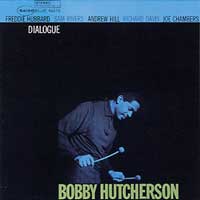 Das DebÞt des ausgezeichneten Vibraphonisten als SolokÞnstler mit einem sehr spannenden Ensemble eingespielt:
Freddie Hubbard an der Trompete, Richard Davis am Bass, Joe Chambers am
Schlagzeug, Sam Rivers am Saxophon und Andrew Hill am Piano.
Das DebÞt des ausgezeichneten Vibraphonisten als SolokÞnstler mit einem sehr spannenden Ensemble eingespielt:
Freddie Hubbard an der Trompete, Richard Davis am Bass, Joe Chambers am
Schlagzeug, Sam Rivers am Saxophon und Andrew Hill am Piano.

 Mehr ...
Mehr ...
In a long and fertile first stint with Blue Note that spanned the years 1963-1977, vibraphonist Bobby Hutcherson recorded 22 albums in a range of different styles. His debut release for Alfred Lionâs label was this adventurous post-bop outing featuring a sextet comprising trumpeter Freddie Hubbard, multi-reed player Sam Rivers, pianist Andrew Hill, bassist Richard Davis, and drummer Joe Chambers. Hill and Chambers share the composer credits on the setâs five tunes, which range from intoxicating Latin grooves (âCattaâ) to pastel-hued reveries (âIdle Whileâ) and jagged, Thelonious Monk-style blues (âGhetto Lightsâ).
(www.udiscovermusic.com)
Platz43bei uDiscoverMusic.
|
| Pete La Roca: "Bazra" (BLP 4205, 19. Mai 1965) |
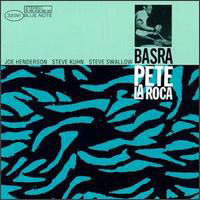 Eine der wenigen Sessions des Schlagzeugers unter eigenem Namen. Damals
noch am Kontrabass statt der Bassgitarre Steve Swallow, der spÃĪtere
Mitstreiter von Gary Burton und Carla Bley, am Klavier Steve
Kuhn. Alle drei spielten damals zusammen in der Band von Trompeter
Art Farmer. Am Saxofon hier zu hÃķren der wunderbare Joe
Henderson. Hard Bop der Spitzenklasse.
Eine der wenigen Sessions des Schlagzeugers unter eigenem Namen. Damals
noch am Kontrabass statt der Bassgitarre Steve Swallow, der spÃĪtere
Mitstreiter von Gary Burton und Carla Bley, am Klavier Steve
Kuhn. Alle drei spielten damals zusammen in der Band von Trompeter
Art Farmer. Am Saxofon hier zu hÃķren der wunderbare Joe
Henderson. Hard Bop der Spitzenklasse.
(06.04.2011)

 Mehr ...
Mehr ...
It is strange to realize that drummer Pete La Roca only led two albums during the prime years of his career, for this CD reissue of his initial date is a classic. La Roca's three originals ("Basra," which holds one's interest despite staying on one chord throughout, the blues "Candu," and the complex "Tears Come From Heaven") are stimulating but it is the other three songs that really bring out the best playing in the quartet (which is comprised of tenor saxophonist Joe Henderson, pianist Steve Kuhn, and bassist Steve Swallow in addition to La Roca). "Malaguena" is given a great deal of passion, Swallow's "Eiderdown" (heard in its initial recording) receives definitive treatment, and the ballad "Lazy Afternoon" is both haunting and very memorable; Henderson's tone perfectly fits that piece.
(by Scott Yanow, All Music Guide)
|
| Horace Silver Quintet plus J.J. Johnson: "The Cap Verdean Blues" (BLP 4220, 22. Okt. 1965) |
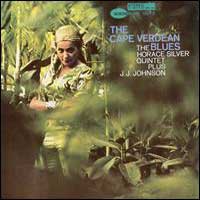 ... und noch mehr vorzÞglicher Jazz (und Dank Rudy van Gelder)
in perfektem Klang von einem wunderbaren Label! Der Pianist Horace
Silver war damals sehr populÃĪr und hatte einen etwas "eingÃĪngigeren
Stil" als manche seiner Kollegen: Mainstream-Jazz auf allerhÃķchstem
Niveau! Mit dabei drei tolle BlÃĪser: Tenorsaxofonist Joe
Henderson war schon auf dem ebenfalls gelungenen VorgÃĪnger "Song
For My Father" zu hÃķren. Trompeter Woody Shaw war als
"Youngster" neu in der Band. Posaunist Jay Jay Johnson
war ein alter WeggefÃĪhrte von Silver aus den 50ern und ist als Gastsolist
zu hÃķren. Und wie immer bei Blue Note: ein sehr schÃķnes Cover!
... und noch mehr vorzÞglicher Jazz (und Dank Rudy van Gelder)
in perfektem Klang von einem wunderbaren Label! Der Pianist Horace
Silver war damals sehr populÃĪr und hatte einen etwas "eingÃĪngigeren
Stil" als manche seiner Kollegen: Mainstream-Jazz auf allerhÃķchstem
Niveau! Mit dabei drei tolle BlÃĪser: Tenorsaxofonist Joe
Henderson war schon auf dem ebenfalls gelungenen VorgÃĪnger "Song
For My Father" zu hÃķren. Trompeter Woody Shaw war als
"Youngster" neu in der Band. Posaunist Jay Jay Johnson
war ein alter WeggefÃĪhrte von Silver aus den 50ern und ist als Gastsolist
zu hÃķren. Und wie immer bei Blue Note: ein sehr schÃķnes Cover!
(14.04.2006)
Platz46bei uDiscoverMusic.

 Mehr ...
Mehr ...
After the success of Song for My Father and its hit title cut, Horace Silver was moved to pay further tribute to his dad, not to mention connect with some of his roots. Silver's father was born in the island nation of Cape Verde (near West Africa) before emigrating to the United States, and that's the inspiration behind The Cape Verdean Blues. Not all of the tracks are directly influenced by the music of Cape Verde (though some do incorporate Silver's taste for light exoticism); however, there's a spirit of adventure that pervades the entire album, a sense of exploration that wouldn't have been quite the same with Silver's quintet of old. On average, the tracks are longer than usual, and the lineup -- featuring tenor saxophonist Joe Henderson (a holdover from the Song for My Father sessions) and trumpeter Woody Shaw -- is one of the most modernist-leaning Silver ever recorded with. They push Silver into more advanced territory than he was normally accustomed to working, with mild dissonances and (especially in Henderson's case) a rawer edge to the playing. What's more, bop trombone legend J.J. Johnson appears on half of the six tracks, and Silver sounds excited to finally work with a collaborator he'd been pursuing for some time. Johnson ably handles some of the album's most challenging material, like the moody, swelling "Bonita" and the complex, up-tempo rhythms of "Nutville." Most interesting, though, is the lilting title track, which conjures the flavor of the islands with a blend of Latin-tinged rhythms and calypso melodies that nonetheless don't sound quite Caribbean in origin. Also noteworthy are "The African Queen," with its blend of emotional power and drifting hints of freedom, and "Pretty Eyes," Silver's first original waltz. Yet another worthwhile Silver album.
(by Steve Huey, All usic Guide)
One of hard bopâs chief architects, Connecticut-born pianist-composer Horace Silver was also a co-founder member of The Jazz Messengers and helped to establish the two-horn frontline (trumpet and saxophone) as the norm in small-group jazz. Silverâs family originated in Cape Verde, a Portuguese-speaking island off north-west Africa, and this, his 13th Blue Note album, paid homage to his ancestral roots. The pianist fronts a quintet featuring rising Philadelphia trumpet star Woody Shaw, and tenor saxophonist Joe Henderson, who are augmented on three tracks by trombonist J.J. Johnson. The music ranges from vibrant uptempo material (the title track and pulsating âNutvilleâ) to mellow mid-tempo grooves (âPretty Eyesâ). But undoubtedly, the albumâs most arresting cut is âThe African Queen,â a loping atmospheric piece characterized by an infectious descending horn melody, a mind-blowing Joe Henderson solo and Roger Humphriesâ turbulent drum fills.
(www.udiscovermusic.com)
|
Larry Young: "Unity" (BLP 4221, 10. Nov. 1965) |
 "Unity" ist vielleicht das beste Album eines der ganz groÃen
Orgelspieler des Jazz! UnterstÞtzt von Elvin Jones am Schlagzeug
und den BlÃĪsern Joe Henderson (Ternorsax) und Woody
Shaw (Trompete) wird hier eine modernere Orgelmusik als etwa bei Jimmy
Smith gepflegt, den ich aber auch sehr schÃĪtze.
"Unity" ist vielleicht das beste Album eines der ganz groÃen
Orgelspieler des Jazz! UnterstÞtzt von Elvin Jones am Schlagzeug
und den BlÃĪsern Joe Henderson (Ternorsax) und Woody
Shaw (Trompete) wird hier eine modernere Orgelmusik als etwa bei Jimmy
Smith gepflegt, den ich aber auch sehr schÃĪtze.
(02.06.2009)

 Mehr ...
Mehr ...
GrÃķÃtes Album des fÞr mich und viele andere besten Jazzorganisten ever ("Coltrane der Orgel"), der u.a. mit Hendrix jammte, bei MilesÂī Bitches Brew dabei war. Post Bop, nicht so abenteurlich wie andere Blue Note-Acts der Zeit (Andrew Hill, Dolphy..), aber schon avanciert, Traditionen brechend. Und melodisch (auch die Soli), z.T. ausgesprochen markant! Eleganz, Finesse, VirtuositÃĪt und perfektes Zusammenspiel vereinen sich zu einem durchweg ziemlich schnellen auf delikate Weise swingenden Meisterwerk. Toller leichtfÞÃiger quecksilbriger Hammond-Ton, Coltrane-beeinfluÃtes Sax (Joe Henderson!), klasse Trompete (W.Shaw), flexible elastische quirlige grandiose Drums (Elvin Jones!; wunderbare kristalline Beckenarbeit!). Penguin Guide (wie auch All Music Guide u.v.a.) vergab die sehr seltene HÃķchstwertung. Rudy Van Gelder-24-Bit-remastered-Edition.
(Glitterhouse)
On his sophomore date as a leader, jazz organist Larry Young began to display some of the angular drive that made him a natural for the jazz-rock explosion to come barely four years later. While about as far from the groove jazz of Jimmy Smith as you could get, Young hadn't made the complete leap into freeform jazz-rock either. Here he finds himself in very distinguished company: drummer Elvin Jones, trumpeter Woody Shaw, and saxman Joe Henderson. Young was clearly taken by the explorations of saxophonists Coleman and Coltrane, as well as the tonal expressionism put in place by Sonny Rollins and the hard-edged modal music of Miles Davis and his young quintet. But the sound here is all Young: the rhythmic thrusting pulses shoved up against Henderson and Shaw as the framework for a melody that never actually emerges ("Zoltan" â one of three Shaw tunes here), the skipping chords he uses to supplant the harmony in "Monk's Dream," and also the reiterating of front-line phrases a half step behind the beat to create an echo effect and leave a tonal trace on the soloists as they emerge into the tunes (Henderson's "If" and Shaw's "The Moontrane"). All of these are Young trademarks, displayed when he was still very young, yet enough of a wiseacre to try to drive a group of musicians as seasoned as this â and he succeeded each and every time. As a soloist, Young is at his best on Shaw's "Beyond All Limits" and the classic nugget "Softly as in a Morning Sunrise." In his breaks, Young uses the middle register as a place of departure, staggering arpeggios against chords against harmonic inversions that swing plenty and still comes out at all angles. Unity proved that Young's debut, Into Somethin', was no fluke, and that he could play with the lions. And as an album, it holds up even better than some of the work by his sidemen here.
(by Thom Jurek, All Music Guide)
Hailed as the organ-playing equivalent to John Coltrane, Newarkâs Larry Young offered a different approach to the Hammond B3 from the likes of blues-based label mates, Jimmy Smith and Big John Patton. Recorded in 1965, Unity is a masterpiece that represents the apotheosis of Youngâs modal jazz aesthetic. Assisting in bringing his musical vision to life were saxophonist Joe Henderson, trumpeter Woody Shaw â who contributes three tunes, including the Coltrane-inspired âThe Moontraneâ â and powerhouse drummer Elvin Jones.
(www.udiscovermusic.com)
Platz29bei uDiscoverMusic.
|
Joe Henderson: "Mode For Joe" (BLP 4227, 27. Jan. 1966) |

(06.01.2019)

 Mehr ...
Mehr ...
ïŧŋ
Given the recording date of Mode for Joe and the band lineup, it's easy to assume this is a straight-up hard bop album. However, this 1966 Joe Henderson record -- featuring trumpeter Lee Morgan, trombonist Curtis Fuller, vibraphonist Bobby Hutcherson, pianist Cedar Walton, bassist Ron Carter, and drummer Joe Chambers -- is a great example of modern jazz at its best. It was recorded during a time of sweeping musical changes due to developments in free jazz, soul-jazz, and even early experiments with fusion. It was a time when the bluesy and funky leanings of hard boppers were giving way to more individualized contemporary approaches. One of the best examples of this shift, Mode for Joe sounds more like the experimental work of Branford Marsalis than the groovy musings of Art Blakey & the Jazz Messengers. The last track here, "Free Wheelin'," is the only dyed-in-the-wool hard bop tune heard here. Other than that, this outing's mostly uptempo songs serve as vehicles for solos. Henderson himself proves that the template for players such as Marsalis, Joe Lovano, and Joshua Redman was invented a generation earlier, as evidenced on "A Shade of Jade," "Black," and others, making this one of the sax legend's most intriguing albums.
(by Eric Starr, All Music Guide)
Hendersonâs fifth and final Blue Note LP was this magnificent opus, which found the Ohio tenor saxophone maven leading a stellar septet that included two of the labelâs rising young stars: trumpeter Lee Morgan and vibraphonist Bobby Hutcherson. Also present is pianist Cedar Walton (who contributes two songs, the first of which is the classic title track), trombonist Curtis Fuller, who adds richness to the horn lines, bassist Ron Carter and drummer Joe Chambers. The music is rooted in hard bop but exhibits modal tendencies on some tunes, imbuing the session with an adventurous and progressive vibe.
(www.udiscovermusic.com)
Platz19bei uDiscoverMusic.
|
| Bobby Hutcherson: "Happenings" (BLP 4231, 06. Febr. 1966) |
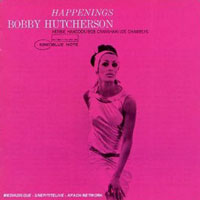 |
| Sam Rivers: "Dimensions & Extensions" (BLP 4261, 17. MÃĪrz 1967 * 1986) |
 Erstmals 1976 als Teil des Doppelalbums "Involution" (BN LA453-H2) verÃķffentlicht, erschien
das Album erstmalig 1986 mit dem ursprÞnglich geplantem Cover und der vorgesehenen Bestellnummer.
Neben Rivers sind Donald Byrd (Trompete), Julian Priester (Posaune),
James Spaulding (Altsaxophon, FlÃķte), Cecil McBee (Bass) und Steve Ellington
(Schlagzeug) dabei.
Erstmals 1976 als Teil des Doppelalbums "Involution" (BN LA453-H2) verÃķffentlicht, erschien
das Album erstmalig 1986 mit dem ursprÞnglich geplantem Cover und der vorgesehenen Bestellnummer.
Neben Rivers sind Donald Byrd (Trompete), Julian Priester (Posaune),
James Spaulding (Altsaxophon, FlÃķte), Cecil McBee (Bass) und Steve Ellington
(Schlagzeug) dabei.
|
| Booker Ervin: "The In Between" (BLP 4283, 12. Jan. 1968) |
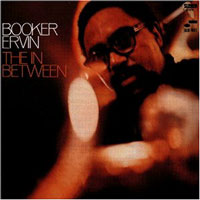 Booker Ervin war mir bisher nur dem Namen nach bekannt, u.a. von
ein paar Charles Mingus-Alben. Auf "In Between" ist er
im Studio von Rudy van Gelder in klassischer Quintett-Besetzung
zu hÃķren, wobei auch die Mitstreiter nicht zu den bekanntesten Blue-Note-Protagonisten
gehÃķren: Trompeter Richard Williams (auch bei Mingus
zu hÃķren), Pianist Bobby Few, Bassist Cevera Jeffries
und Trommler Lennie McBrowne.
Booker Ervin war mir bisher nur dem Namen nach bekannt, u.a. von
ein paar Charles Mingus-Alben. Auf "In Between" ist er
im Studio von Rudy van Gelder in klassischer Quintett-Besetzung
zu hÃķren, wobei auch die Mitstreiter nicht zu den bekanntesten Blue-Note-Protagonisten
gehÃķren: Trompeter Richard Williams (auch bei Mingus
zu hÃķren), Pianist Bobby Few, Bassist Cevera Jeffries
und Trommler Lennie McBrowne.
Beim ersten ReinhÃķren haben mich die beiden ersten Titel direkt zum
Kauf Þberredet: zuerst der Titeltrack mit seiner MÃķrdergroove,
bei der man ein Mitwippen unmÃķglich unterdrÞcken kann. Danach
mit "The Muse" eine schÃķne Ballade mit QuerflÃķte.
Aber auch der Rest ist Þberzeugend: klanglich, spielerisch ... in
jeder Hinsicht!
(08.08.2010)

 Mehr ...
Mehr ...
Booker Ervin headed to Blue Note in 1968 for The In Between, a record that found him continuing in the vein of his later Prestige sessions. Supported by trumpeter Richard Williams, pianist Bobby Few, bassist Cevera Jeffries and drummer Lennie McBrowne, Ervin created an album that pushed the boundaries of hard bop. Every song on The In Between is an Ervin original designed to challenge the musicians. The music rarely reaches avant-garde territory instead, it's edgy, volatile hard bop that comes from the mind as much as the soul. Appropriately, Ervin balances his full-bodied tone with a forceful, aggressive attack that even sounds restless on the slower numbers. The result is a satisfying, cerebral set of adventurous hard bop that finds Booker Ervin at a creative peak.
(by Stephen Thomas Erlewine, All Music Guide)
|
| Bobby Hutcherson: "Total Eclipse" (BLP 4291, 12. Juli 1968) |
|
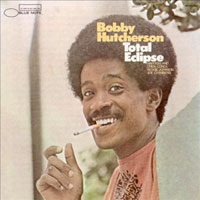 Ob Bobby Hutcherson soviel Spaà hatte, weil man damals
als Raucher noch eine gewisse Coolness
hatte, ist mir nicht bekannt. Die Besetzung der Platte verspricht hÃķchste
QualitÃĪt: Chic Corea am Piano, ansonsten gerade frisch im
Miles Davis Quintet angekommen, Harold Land an Saxofon
und FlÃķte, der hier seine langjÃĪhrige Zusammenarbeit mit Hutcherson
beginnt, Joe Chambers am Schlagzeug und Reggie Johnson
am Bass.
Ob Bobby Hutcherson soviel Spaà hatte, weil man damals
als Raucher noch eine gewisse Coolness
hatte, ist mir nicht bekannt. Die Besetzung der Platte verspricht hÃķchste
QualitÃĪt: Chic Corea am Piano, ansonsten gerade frisch im
Miles Davis Quintet angekommen, Harold Land an Saxofon
und FlÃķte, der hier seine langjÃĪhrige Zusammenarbeit mit Hutcherson
beginnt, Joe Chambers am Schlagzeug und Reggie Johnson
am Bass.
(02.06.2015)

 Mehr ...
Mehr ...
Total Eclipse was Bobby Hutcherson's first recording session with tenor saxophonist Harold Land, who became one of his major collaborators (and a quintet co-leader) during the late '60s. Land's rounded, echoing tone is a nice contrast for the coolly cerebral post-bop that fills Total Eclipse. Hutcherson contributes four of the five compositions (the other, "Matrix," is by pianist Chick Corea), and he's in a mood to intellectually challenge himself and the rest of the quintet, which also includes bassist Reggie Johnson and longtime drummer Joe Chambers. The results are full of the sort of skillful musicianship one would naturally expect of Hutcherson's '60s-era Blue Notes. Land's solo lines are fluid and lengthy, assimilating some of Coltrane's innovations while remaining accessibly soulful. Though they're all pretty strong, "Pompeian" is the most ambitious piece; it opens with a happy-go-lucky, waltz-time flute melody, and after a bit of foreboding, Hutcherson expands upon it with a tinkling bell solo. Toward the end of the piece, the whole group builds to a chaotic eruption, with Hutcherson switching to marimba (as he often did when he wanted a darker tone and high-tempo articulation); the pretty flute theme is then repeated as the dust settles and the piece ends. Overall, though, the album foreshadows Hutcherson's move away from his explicit avant-garde leanings and into a still-advanced but more structured modernist framework. For some reason, Total Eclipse was the only post-bop-styled album Hutcherson and Land recorded together that was released at the time; though they're all high-quality, this remains perhaps the best of the lot.
(by Steve Huey, All Music Guide)
|
| Donald Byrd: "Slow Drag" (BLP 4292, 12. Mai 1967) |
|
 Trompeter Donald Byrd bei einer seiner letzten akustischen Sessions vor seiner erfolgreichen
Funk-Phase, zusammen mit Sonny Red (Altsaxofonist), Cedar Walton (Piano), Walter Booker
(Bass) und Trommler Billy Higgins.
Trompeter Donald Byrd bei einer seiner letzten akustischen Sessions vor seiner erfolgreichen
Funk-Phase, zusammen mit Sonny Red (Altsaxofonist), Cedar Walton (Piano), Walter Booker
(Bass) und Trommler Billy Higgins.
(02.03.2008)
Der erste Anreiz, mich mit "Slow Drag" zu beschÃĪftigen, abgesehen davon, dass Donald Byrd
und Blue Note natÞrlich immer fÞr QualitÃĪt bÞrgen, war zugegebenermaÃen ein rein optischer - aber
es ist auch ein wirklich gutes Album. Wahrscheinlich kein Meilenstein der Jazzgeschichte, aber einfach gut zu hÃķren.
(22.06.2010)

 Mehr ...
Mehr ...
Slow Drag was one of trumpeter Donald Byrd's final hard bop dates. Teamed with altoist Sonny Red, pianist Cedar Walton, bassist Walter Booker and drummer Billy Higgins (who takes a surprise vocal on the title cut), this quintet outing features originals by Byrd, Walton and Red along with the standards "Secret Love" and "My Ideal." The music in general finds Byrd looking both backwards toward the blues and forwards toward modal music and hints of the avant-garde. A fine effort.
(by Scott Yanow, All Music Guide)
|
| Eddie Gale: "Eddie Gale's Ghetto Music" (BLP 4294, 20. Sept. 1968) |
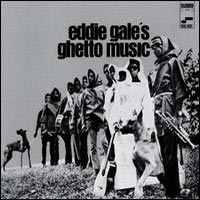 Auf das DebÞtalbum des mir bislang vÃķllig unbekannten Eddie Gale
(spielte bei Cecil Taylor und mit Sun Ra) bin ich zufÃĪllig
im Internet gestossen, wo eine Zusammenarbeit des Trompeters mit der Instrumentalband
Mushroom aus San Francisco, geleitet von Trommler
Pat Thomas, erwÃĪhnt wurde. Dort gab es auch einen Hinweis auf dieses
seltene Kultalbum, das eine Besonderheit im Blue Note-Katalog darstellen
soll. KÞrzlich bekam ich eine Kopie des CD-Reissues auf Water-Records,
betreut von, oh Zufall, Pat Thomas.
Auf das DebÞtalbum des mir bislang vÃķllig unbekannten Eddie Gale
(spielte bei Cecil Taylor und mit Sun Ra) bin ich zufÃĪllig
im Internet gestossen, wo eine Zusammenarbeit des Trompeters mit der Instrumentalband
Mushroom aus San Francisco, geleitet von Trommler
Pat Thomas, erwÃĪhnt wurde. Dort gab es auch einen Hinweis auf dieses
seltene Kultalbum, das eine Besonderheit im Blue Note-Katalog darstellen
soll. KÞrzlich bekam ich eine Kopie des CD-Reissues auf Water-Records,
betreut von, oh Zufall, Pat Thomas.
Die Besetzung besteht aus zwei BlÃĪsern (Eddie und Saxofonist Russell
Lyle), dazu zwei BÃĪsse, zwei Schlagzeuger und ein 11kÃķpfiger Gospelchor.
Die erste Nummer "The Rain" beginnt - verwirrend auf einem Blue
Note-Album - mit einer einzelnen sanften Frauenstimme und Folkgitarre
im Stile von Pentangle oder besser gesagt: Joan Baez, bevor
zur zweiten Strophe Band und Chor dazukommen und die Nummer doch noch
zu einer ekstatischen Jazzimprovisation wird. Ein wirklich tolles Album!
Und wirklich was besonderes im Blue Note-Katalog!
(28.05.2009)

 Mehr ...
Mehr ...
The aesthetic and cultural merits of Eddie Gale's Ghetto Music cannot be overstated. That it is one of the most obscure recordings in Blue Note's catalogue â paid for out of label co-founder Francis Wolff's own pocket â should tell us something. This is an apocryphal album, one that seamlessly blends the new jazz of the '60s â Gale was a member of the Sun Ra Arkestra before and after these sides, and played on Cecil Taylor's Blue Note debut Unit Structures â with gospel, soul, and the blues. Gale's sextet included two bass players and two drummers â in 1968 â as well as a chorus of 11 voices, male and female. Sound like a mess? Far from it. This is some of the most spiritually engaged, forward-thinking, and finely wrought music of 1968. What's more is that, unlike lots of post-Coltrane new jazz, it's ultimately very listenable. Soloists comes and go, but modes, melodies, and harmonies remain firmly intact. The beautiful strains of African folk music and Latin jazz sounds in "Fulton Street," for example, create a veritable chromatic rainbow. "A Walk With Thee" is a spiritual written to a march tempo with drummers playing counterpoint to one another and the front line creating elongated melodic lines via an Eastern harmonic sensibility. Does it swing? Hell yeah! The final cut, "The Coming of Gwilu," moves from the tribal to the urban and everywhere in between using Jamaican thumb piano's, soaring vocals à la the Arkestra, polyrhythmic invention, and good old fashioned groove jazz, making something entirely new in the process. While Albert Ayler's New Grass was a failure for all its adventurousness, Ghetto Music, while a bit narrower in scope, succeeds because it concentrates on creating a space for the myriad voices of an emerging African-American cultural force to be heard in a single architecture.
(by Thom Jurek, All Music Guide)
It is often difficult to gauge the relative importance or message of an artwork, years or decades after its initial release. Truly impressive are those works that not only retain their Zeitgeist, the spirit of the times, but also find relevance and significance with the present. Listening to the re-release of 1968's Eddie Gale's Ghetto Music, one not only senses the social awakening of the late 1960s, there is an equal and unfortunate awareness of our current cultural waste. Francis Wolff, co-founder of Blue Note, felt so strongly about this album that he personally financed the production and release of this music in 1968, after recording Gale on Cecil Taylor's Unit Structures and Larry Young's Of Love and Peace.
Along with its companion piece, Black Rhythm Happening, Eddie Gale's Ghetto Music fell victim to the chaos following Liberty Records' takeover of Blue Note. Both pieces never appeared beyond their initial releases, until now.
The good people at San Francisco-based Water Music have taken the initiative and re-released Eddie Gale's Ghetto Music on CD. The success of the album stems from its unique use of folk, blues, gospel, soul and jazz to create a wildly vibrant, urban force. "The Rain," with Joan Gale's soft, assured delivery, sets the pace for the entire album, as it morphs from a single guitar strum into a massive entity of sound, rhythm, and swing. Surprising, since 17 musicians appear on the album, is the precision and efficiency of the music.
On "Fulton Street," for example, the feel of the famous Brooklyn street is captured immediately by the child-like voices pronouncing its name proudly: "Fulton Street, baby!" Then, the low down riff comes in, the singers mimic the sound of the horns, they interchange riffs, and someone runs here, somebody else goes there, and you feel it, you're on Fulton Street, baby. It welcomes you.
Once in, it may well be difficult to relinquish the sensation of songs like "A Walk With Thee" or "The Coming of Gwilu." Both burn as deep, groove as hard, as anything else on the vaunted Blue Note catalog. For that reason, those that rarely venture outside the hard bop fringes of Blue Note will be most rewarded by the music here, as it presents new possibilities without abandoning the "Blue Note sound."
(Germein Linares, www.allaboutjazz.com)
In 1967, an ailing Alfred Lion left Blue Note Records, the label he had founded in the late 1930s and sold to Liberty Records in 1965. Though staff producers Duke Pearson and Francis Wolff put some memorable records together after his departure, Blue Note declined in stature and relevance into the early seventies. Surprising, then, to find a great Eddie Gale Blue Note record from 1968 (and another solid one from 1969)ârecords inexplicably avoided by the reconstituted EMI-owned Blue Note's own rigorous reissue-and-reissue-again policyârecently made available thanks to Water Records.
Gale is a trumpeter, most famous for his performance on Cecil Taylor's celebrated 1966 Unit Structures album on Blue Note, who also spent significant time with Sun Ra. There's a deep reserve of space in his playing, built cumulatively of longish pauses between phrases, and he has a concise sound that's brassy like Freddie Hubbard, but frayed around the edges like Woody Shaw or Johnny Coles. His melodies and ideas are original and a bit acerbic.
For these two records, his first as a leaderâand last for many years except as a sidemanâGale was thinking big: Amalgamating soul, gospel, African music and jazz into a single sound, executed with a jazz group and chorus. The level of ambition, ritualistic clothes (the musicians appearing in monk's robes on the covers of the records) and cosmic philosophy of some of the lyrics point squarely to Sun Ra's influence, but it's Gale's own show to be sure.
Ghetto Music is certainly one of the last great records released by the original Blue Note (another is Herbie Hancock's The Prisoner) and the finest example of voices-plus-jazz-group on the labelâmore organic than Donald Byrd's famous 1963 album A New Perspective, cooler and more soulful than Andrew Hill's 1969 album Lift Every Voice. The eleven-voice choir is perfectly matched with Gale's two-drummer sextet; sometimes singing over the top of joyful songs, and sometimes weaving chant and syllable singing through the sextet.
"The Rain" is an extraordinary merger of fast jazz waltz, gospel singing, and what sounds like a British folk song influence. It begins with Joann Gale's (Eddie's sister) strummed guitar, and her lovely, measured performance of the tune's folky melody. It wouldn't be out of place on a Fairport Convention or Pentangle album; that is, until the thunderous band rolls into step behind her. "A Understanding" is a swirling spiritual piece, in the style of late-period Coltrane, which sets a platform for some of Gale's finest playing on the record. His solo is remarkable for the single-mindedness with which he pursues a long tension-filled arc. The performance is far enough ahead of its time that it wouldn't sound out of place on a late 90s Matthew Shipp record. "A Walk With Thee" shows off the two drummers, Richard Hackett and Thomas Holman, at their best (and they're excellent throughout). It's reminiscent of some of Masada's music. "The Coming of Gwilu" opens with thumb piano, bird whistle and flute, leaving the urban spirituality of the earlier pieces for a distant natural atmosphere. It opens into a hypnotic rolling 6/4 jazz vamp, over which steel drums announce a beautiful vocal call and response section. Ghetto Music is well paced and cumulatively powerful. It's also one of the better sounding records of the period.
(James Beaudreau, 16 April 2004, www.onefinalnote.com)
|
| Bobby Hutcherson: "Now!" (BLP 4333, 1969) |
 Lost and found!
Lost and found!
(10.05.2013)

 Mehr ...
Mehr ...
1969er-Album des Vibraphonisten Bobby Hutcherson mit SÃĪnger Eugene McDaniels. Spiritual Soul Jazz at ist best!
Ganz im progressiven Geiste einer (seinerzeit) neuen black consciousness konzipiertes Album in der Besetzung Harold Land (Tenor-Saxophon), Kenny Barron (Piano), Stanley Cowell (Piano), Wally Richardson (Gitarre), Herbie Lewis (Bass), Joe Chambers (Drums) und Candido Camero (Congas) sowie LeadsÃĪnger Eugene McDaniels (aus dessen Feder der Jazz / Soul-Protestsong Compared To What stammt) und einem fÞnfstimmigen Backgound- Chor. Ein Meisterwerk.
Now! is one of Bobby Hutcherson's most adventurous recordings. Cut with the Harold Land Quintet in 1969, Hutcherson augments the lineup with vocalist the Right Reverend Eugene McDaniels (then Gene McDaniels) and a chorus at the height of Black Power consciousness. While this band may not appeal to straight hard and post-bop listeners who prefer their music instrumentally, it is a compelling and even stunning record if accepted on its own terms. The compositions reflect the tightrope Hutcherson and Land walked on their earlier outings together between post-bop and vanguard jazz The interplay between Hutcherson and Stanley Cowell's 's piano in the instrumental passages in "Slow Change" is so intuitive and symbiotic it may slip by the listener who is not paying attention. Land's solo too, comes out for the post-Coltrane ethos and fills the vocal lines powerfully and convincingly. Elsewhere, on "Hello to the Wind," written by drummer Joe Chambers and McDaniels, the influence of Terry Callier is evident in the tune's dynamic and melody line that is led by Wally Richardson's guitar. With fine piano work by Kenny Barron and a fluid, modal bassline by Herbie Lewis. McDaniels' voice is in fine form here, his husky baritone effortlessly coloring the mix. The title cut is a short lullaby written by Hutcherson and McDaniels, tender, simple and haunting as Land's saxophone winds through the shouts of female voices with restraint and elegance. The utter creative vision of Herbie Lewis' "The Creators" showcases the band at the height of its powers with Cowell holding the piano chair with killer Latin rhythms, psychedelic electric guitar and a provocative engagement between Land, Hutcherson and the chorus. The original set ends with "Black Heroes" by Land. A scatted, syncopated piece of counterculture beat jazz, it offers a better portrait of the band than it does of McDaniels or the choral group. A hard bop piece with a striated and knotty vocal intro and finish, it is a fitting and exciting final track.
(by Thom Jurek, All Music Guide)
|
| Jackie McLean "Demon's Dance" (BLP 4345, 22. Dez. 1967) |


 Mehr ...
Mehr ...
In den 1960er Jahren Þberschritt der abenteuerlustige Altsaxophonist Jackie McLean auf seinen Blue-Note-Alben mehrfach die Grenzen zur Avantgarde. Auf ÂŧDemon's DanceÂŦ aber, seinem 21. und zugleich auch letzten Album fÞr das Label, fokussierte er sich 1967 mit seinem Quintett ganz auf schneidigen Post-Bop. So eindrucksvoll wie die Musik war auch das Cover-Bild des deutsch-franzÃķsischen Malers Mati Klarwein, der spÃĪter noch ikonische PlattenhÞllen fÞr Miles Davis (âđBitches BrewÂŦ) und Santana (âđAbraxasÂŧ) gestalteten sollte.
|
| Donald Byrd: "Electric Byrd" (BLP 4349, 15. Mai 1970) |
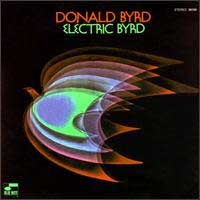 Dieses Album wÃĪre ohne Bitches
Brew wohl kaum entstanden: am 15.Mai, also knapp einen Monat nach
dem Erscheinen von Miles Davis' Meisterwerk war der Blue-Note-Startrompeter
selber im Studio, um seine Version/Vision von "Fusion" zu erschaffen.
Mit dabei u. a. die ehemaligen bzw. zukÞnftigen Miles-Davis-Musiker
Ron Carter und Airto Moreira. Neben Donald Byrds Trompete
sind gleich 4 sehr gute Saxofonisten dabei: Jerry Dodgion, Frank
Foster, Lew Tabackin und Pepper Adams, dazu an der Posaune
Bill Campbell. Trotzdem gibt es keinen klassischen "Bigband"-Sound.
Eine tragende Rolle nimmt das E-Piano von Duke Pearson ein. Um
es noch mal klar zu sagen: hier wird nicht Miles Davis kopiert, sondern
eine entspannte Variante der damaligen "Zeitgeist"-Musik gebracht.
Wer auf lange Klangteppiche á la Bitches
Brew steht, aber dort eine gewisse Leichtigkeit vermisst, der ist
hier gut aufgehoben. FÞr mich eine sehr schÃķne Hintergrundmusik
(was nicht negativ gemeint ist!)
Dieses Album wÃĪre ohne Bitches
Brew wohl kaum entstanden: am 15.Mai, also knapp einen Monat nach
dem Erscheinen von Miles Davis' Meisterwerk war der Blue-Note-Startrompeter
selber im Studio, um seine Version/Vision von "Fusion" zu erschaffen.
Mit dabei u. a. die ehemaligen bzw. zukÞnftigen Miles-Davis-Musiker
Ron Carter und Airto Moreira. Neben Donald Byrds Trompete
sind gleich 4 sehr gute Saxofonisten dabei: Jerry Dodgion, Frank
Foster, Lew Tabackin und Pepper Adams, dazu an der Posaune
Bill Campbell. Trotzdem gibt es keinen klassischen "Bigband"-Sound.
Eine tragende Rolle nimmt das E-Piano von Duke Pearson ein. Um
es noch mal klar zu sagen: hier wird nicht Miles Davis kopiert, sondern
eine entspannte Variante der damaligen "Zeitgeist"-Musik gebracht.
Wer auf lange Klangteppiche á la Bitches
Brew steht, aber dort eine gewisse Leichtigkeit vermisst, der ist
hier gut aufgehoben. FÞr mich eine sehr schÃķne Hintergrundmusik
(was nicht negativ gemeint ist!)

 Mehr ...
Mehr ...
Donald Byrd's transitional sessions from 1969-1971 are actually some of the trumpeter's most intriguing work, balancing accessible, funky, Davis-style fusion with legitimate jazz improvisation. Electric Byrd, from 1970, is the best of the bunch, as Byrd absorbs the innovations of Bitches Brew and comes up with one of his most consistent fusion sets of any flavor. Byrd leads his largest fusion group yet (ten to 11 pieces), featuring many of his cohorts of the time (including Jerry Dodgion, Lew Tabackin, and Frank Foster on various woodwinds). Most important are electric pianist Duke Pearson, who once again dominates the arrangements, and percussionist Airto Moreira, who in places lends a strong Brazilian feel that predates Return to Forever. Moreira also contributes one of the four compositions, "Xibaba," which starts out as an airy Brazilian tune but morphs into a free-form effects extravaganza; the rest are Byrd originals that prove equally imaginative and diverse. The Brazilian-tinged opener "Estavanico" has a gentle, drifting quality that's often disrupted by jarring dissonances. There's also the shifting -- and sometimes even disappearing -- slow groove of "Essence," and the hard-edged, bop-based funk of "The Dude." Much of the album has a spacy, floating feel indebted to the psychedelic fusion of Bitches Brew; it's full of open-ended solo improvisations, loads of amplification effects, and striking sonic textures. The arrangements are continually surprising, and the band never works the same groove too long, switching or completely dropping the underlying rhythms. So even if it wears its influences on its sleeve, Electric Byrd is indisputably challenging, high-quality fusion. It's also the end of the line for jazz purists as far as Donald Byrd is concerned, which is perhaps part of the reason the album has yet to receive its proper due.
(by Steve Huey, AMG)
|
| Jimmy McGriff: "Electric Funk" (BLP 4350, Sept. 1969) |
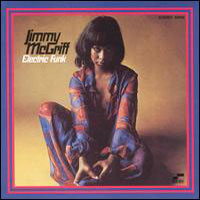
|
| Bobby Hutcherson: "San Francisco" (BLP 4362, 15. Juli 1970) |
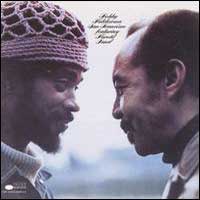 Alleine schon am Cover und Bobbys Kopfbedeckung kann man erkennen, dass
diese Platte nicht aus der Hochphase des Labels Mitte der 60er stammt!
Und auch die Musik steckt irgendwo zwischen klassischem Hardbop der 60er
und dem, was Miles Davis zur selben Zeit mit Bitches
Brew natÞrlich viel radikaler betreibt: der Elektrifizierung
des Jazz. Auf "San Francisco" bezogen heiÃt das aber nur, dass
Joe Sample (der Crusaders-Chef ist hier nur in einer Nebenrolle
dabei!) neben dem FlÞgel auch sehr schÃķn das Rhodes-E-Piano
einsetzt und Bassist John Williams neben dem Kontrabass auch die
Bassgitarre verwendet, bzw. wie man damals immer sagte und es hier auch
auf dem Cover steht: er spielt Fender Bass. Wichtigster
Solist neben Hutcherson, der auÃer dem metallenen Vibraphon auch das verwandte
hÃķlzerne Marimbaphon einsetzt, ist der auf dem Cover mit abgebildete
BlÃĪser Harold Land an Tenorsaxofon, FlÃķte und Oboe. SchÃķne
Platte, die zwar nicht so sehr swingt, aber dafÞr sehr gut groovt!
Alleine schon am Cover und Bobbys Kopfbedeckung kann man erkennen, dass
diese Platte nicht aus der Hochphase des Labels Mitte der 60er stammt!
Und auch die Musik steckt irgendwo zwischen klassischem Hardbop der 60er
und dem, was Miles Davis zur selben Zeit mit Bitches
Brew natÞrlich viel radikaler betreibt: der Elektrifizierung
des Jazz. Auf "San Francisco" bezogen heiÃt das aber nur, dass
Joe Sample (der Crusaders-Chef ist hier nur in einer Nebenrolle
dabei!) neben dem FlÞgel auch sehr schÃķn das Rhodes-E-Piano
einsetzt und Bassist John Williams neben dem Kontrabass auch die
Bassgitarre verwendet, bzw. wie man damals immer sagte und es hier auch
auf dem Cover steht: er spielt Fender Bass. Wichtigster
Solist neben Hutcherson, der auÃer dem metallenen Vibraphon auch das verwandte
hÃķlzerne Marimbaphon einsetzt, ist der auf dem Cover mit abgebildete
BlÃĪser Harold Land an Tenorsaxofon, FlÃķte und Oboe. SchÃķne
Platte, die zwar nicht so sehr swingt, aber dafÞr sehr gut groovt!

 Mehr ...
Mehr ...
|
Bobby Hutcherson's late-'60s partnership with tenor saxophonist Harold
Land had always produced soulful results, but not until San Francisco
did that translate into a literal flirtation with funk and rock. After
watching several advanced post-bop sessions gather dust in the vaults,
Hutcherson decided to experiment with his sound a bit, but San Francisco
still doesn't wind up the commercial jazz-funk extravaganza that purists
might fear. Instead, Hutcherson and Land stake out a warm and engaging
middle ground between muscular funk and Coltrane-style modality; in other
words, they have their cake and eat it too. Joined by pianist/keyboardist
Joe Sample (also of the Jazz Crusaders), acoustic/electric bassist John
Williams, and drummer Mickey Roker, Hutcherson and Land cook up a series
of spacious, breezy grooves that sound unlike any other record in the
vibist's discography (even his more commercial fusion sessions). The selections
-- all group-member originals -- often skirt the edges of fusion, but
rarely play it as expected; they might float some spare tradeoffs over
a loping, heavy bass groove, throw in an oboe solo by Land, or -- as on
the slowest piece -- keep time only with intermittently spaced piano chords.
It's all done with enough imagination and harmonic sophistication to achieve
the rare feat of holding appeal for traditional jazz and rare-groove fans
alike. It's a shame Hutcherson didn't explore this direction more, because
San Francisco is not only one of his best albums, but also one of his
most appealing and accessible.
(by Steve Huey, All
Music Guide)
|
|
| John Scofield: "Time On My Hands" (19.-21. Feb. 1989) |


 Mehr ...
Mehr ...
"Ich bin froh, dass die jungen Gitarristen wissen, wie ich klinge", meinte John Scofield vor ein paar Jahren zu den SchÞlern seiner Meisterklasse an der New York University. "Das heiÃt, sie wissen, dass ich existiere. Also bin ich. Ich muss aber einrÃĪumen, dass ich auch gleich denke: Warum sollte jemand wie ich klingen wollen? Denn ich hÃķre die ungeschliffenen Ecken und Kanten in meinem eigenen Spiel und auch die Dinge, die ich lieber nicht tun wÞrde."
John Scofield war schon immer ein Meister des Understatements. Dabei weià er sicher nur zu gut selbst, dass es gerade diese sehr individuellen Ecken und Kanten sind, die Jazzkritiker und -fans an seinem Gitarrenspiel schon seit Þber vierzig Jahren so sehr lieben. Viele Gitarristen haben versucht ihn zu kopieren, gelungen ist es bis heute aber noch keinem. Erschwerend kommt fÞr Nachahmer hinzu, dass Scofield mit allen erdenklichen stilistischen Wassern gewaschen zu sein scheint. Ihn auf ein Genre festlegen zu wollen, ist als wÞrde man versuchen, einen Pudding an die Wand zu nageln. Seine Wurzeln hat "Sco" zwar eindeutig im Jazz, Blues und Rock, aber mit derselben SelbstverstÃĪndlichkeit handhabt er auch Soul, R'n'Bs, modernen Funk, oder gar Reggae und Afrobeat. Und bleibt dabei doch immer unverkennbar er selbst.
Nachdem sich Scofield ab den spÃĪten 1970er Jahren mit Soloalben fÞr die Labels Enja und Arista Novus eine eingeschworene Fangemeinde erspielt hatte, gelang ihm 1982 der endgÞltige Durchbruch, als ihn der wieder auf die Szene zurÞckgekehrte Miles Davis in seine Band holte. Dreieinhalb Jahre lang tourte der Gitarrist mit der Jazzikone durch die Welt und prÃĪgte die Davis-Alben "Star People", "Decoy" und "You're Under Arrest" maÃgeblich mit. Zur selben Zeit begann er fÞr Gramavision eine Reihe von exzellenten Alben aufzunehmen, auf denen er mit unglaublich groovigem Funk-Jazz glÃĪnzte. 1989 erhielt er dann seinen ersten Vertrag bei einem Major-Label: Blue Note Records. Die Alben, die Scofield dort bis 1995 einspielte, bieten zeitgenÃķssischen Jazz mit einer Vielfalt unterschiedlicher EinflÞsse - von Hard-Bop Þber Soul-Jazz bis hin zu Ornette Coleman und Country. In der preiswerten CD-Box "5 Original Albums" sind fÞnf dieser Blue-Note-Soloalben nun erstmals zusammen erhÃĪltlich. Ausgestattet ist die Box mit Original-Artwork, Stecktaschen-CDs und einem attraktiven Schuber.
FÞr sein Blue-Note-DebÞt stellte der Gitarrist ein besonders hochkarÃĪtiges Quartett mit Saxophonist Joe Lovano, Kontrabassist Charlie Haden und Schlagzeuger Jack DeJohnette zusammen. Die zehn Kompositionen - allesamt aus der Feder des Gitarristen - sind erfrischend klischeefrei und oft von Scofields augenzwinkernder Ironie geprÃĪgt.
John Scofield has turned the corner from journeyman jazz guitarist to become one of the most inventive and witty players on the contemporary scene. This date, his first for the Blue Note label, builds on a discography following several recordings for the Gramavision label, and also progresses this contemporary jazz music into an individualism that can only bode well for his future efforts. Teamed with the rising-star saxophonist Joe Lovano and the bulletproof rhythm team of bassist Charlie Haden and drummer Jack DeJohnette, Scofield is emerging as a player of distinction on the electric guitar, and a composer whose mirthful ideas add spark and vigor to his newfound musical setting. In this co-production with Peter Erskine, Sco has found his melodic stride in making music that is bright and clever without being overly intellectual, retaining a soulful quality enriched by the deep-rooted, bluesy tenor sax of Lovano. What is most refreshing is that this music has broken free of clichÃĐs from the earlier original fusion movement, and what Scofield might have accomplished prior. "Farmacology" is an excellent example of this, more in the hard bop vein and echoing both ringing country twang and the unique voicings of Ornette Coleman. There's rambling neo-bop and good-time fun in the unison of guitar and tenor sax during "Wabash III," a lighter, elegant, but free and melodic tone in 6/8 time for "Flower Power," and squeaky clean, sweet, easygoing swing demonstrated on "Since You Asked." Haden and DeJohnette are so well matched as a rhythm team that it's easy to take them for granted, while hard to ignore their brilliance. They load up on New Orleans-style blues while Scofield doles out amusing and fractured lines for "So Sue Me," collectively move to a sleek and sneaky stance on "Let's Say We Did," and rip up a driven, forceful neo-bop for the linear melody of the witty "Stranger to the Light." Even though it's a first-time issue on CD, there are three bonus tracks, including the soul song shuffle "Time and Tide," a free, loose association that identifies "Be Hear Now," and the big-time, rock & roll-flavored, squawky "Fat Lip." It's hard to fathom this being anything other than a sustainable new direction for Scofield's music, one that he can enhance as bandmembers come and go in the not too distant future.
(by Michael G. Nastos, All Music Guide)
|
| John Scofield: "Grace Under Pressure" (Dez. 1991) |


 Mehr ...
Mehr ...
"Ich bin froh, dass die jungen Gitarristen wissen, wie ich klinge", meinte John Scofield vor ein paar Jahren zu den SchÞlern seiner Meisterklasse an der New York University. "Das heiÃt, sie wissen, dass ich existiere. Also bin ich. Ich muss aber einrÃĪumen, dass ich auch gleich denke: Warum sollte jemand wie ich klingen wollen? Denn ich hÃķre die ungeschliffenen Ecken und Kanten in meinem eigenen Spiel und auch die Dinge, die ich lieber nicht tun wÞrde."
John Scofield war schon immer ein Meister des Understatements. Dabei weià er sicher nur zu gut selbst, dass es gerade diese sehr individuellen Ecken und Kanten sind, die Jazzkritiker und -fans an seinem Gitarrenspiel schon seit Þber vierzig Jahren so sehr lieben. Viele Gitarristen haben versucht ihn zu kopieren, gelungen ist es bis heute aber noch keinem. Erschwerend kommt fÞr Nachahmer hinzu, dass Scofield mit allen erdenklichen stilistischen Wassern gewaschen zu sein scheint. Ihn auf ein Genre festlegen zu wollen, ist als wÞrde man versuchen, einen Pudding an die Wand zu nageln. Seine Wurzeln hat "Sco" zwar eindeutig im Jazz, Blues und Rock, aber mit derselben SelbstverstÃĪndlichkeit handhabt er auch Soul, R'n'Bs, modernen Funk, oder gar Reggae und Afrobeat. Und bleibt dabei doch immer unverkennbar er selbst.
Nachdem sich Scofield ab den spÃĪten 1970er Jahren mit Soloalben fÞr die Labels Enja und Arista Novus eine eingeschworene Fangemeinde erspielt hatte, gelang ihm 1982 der endgÞltige Durchbruch, als ihn der wieder auf die Szene zurÞckgekehrte Miles Davis in seine Band holte. Dreieinhalb Jahre lang tourte der Gitarrist mit der Jazzikone durch die Welt und prÃĪgte die Davis-Alben "Star People", "Decoy" und "You're Under Arrest" maÃgeblich mit. Zur selben Zeit begann er fÞr Gramavision eine Reihe von exzellenten Alben aufzunehmen, auf denen er mit unglaublich groovigem Funk-Jazz glÃĪnzte. 1989 erhielt er dann seinen ersten Vertrag bei einem Major-Label: Blue Note Records. Die Alben, die Scofield dort bis 1995 einspielte, bieten zeitgenÃķssischen Jazz mit einer Vielfalt unterschiedlicher EinflÞsse - von Hard-Bop Þber Soul-Jazz bis hin zu Ornette Coleman und Country. In der preiswerten CD-Box "5 Original Albums" sind fÞnf dieser Blue-Note-Soloalben nun erstmals zusammen erhÃĪltlich. Ausgestattet ist die Box mit Original-Artwork, Stecktaschen-CDs und einem attraktiven Schuber.
Als das "verheiÃungsvollste Gitarristengespann seit John McLaughlin und Carlos Santana" wurden John Scofield und Bill Frisell in den 1980er bejubelt, als sie in Marc Johnsons Band Bass Desires das erste Mal zusammenspielten. Auf "Grace Under Pressure" kam es 1992 zu einer erneuten Kooperation zwischen diesen beiden sehr unterschiedlichen, aber bestens miteinander harmonierenden SaitenkÞnstlern. Anstelle von Marc Johnson und Peter Erskine bildeten diesmal aber Charlie Haden und Joey Baron das agile Rhythmusgespann. FÞr zusÃĪtzliche Klangfarben sorgte bei einigen Nummern auÃerdem ein dezent spielendes BlÃĪsertrio.
John Scofield and Bill Frisell, two of the most distinctive guitarists of the 1990s (they previously fronted Marc Johnson's band Bass Desires,) team up on this quartet date with bassist Charlie Haden and drummer Joey Baron. While Scofield contributed all ten originals, Frisell with his wide variety of sounds and eccentric solos often comes close to stealing the show altogether. Five of the ten numbers add a three-piece brass section for color. The interplay between the two very different yet complementary guitarists is notable.
(by Scott Yanow, All Music Guide)
|
| Cassandra Wilson: "Blue Light ´Til Dawn" (1993) |
 Auf diesem Blue Note Album verband sie ihre fÞr schwarze Jazzer ungewohnte
(?) Vorliebe zu weissen Singer/Songwritern und der Bluesmusik ihre Heimat
(Mississippi-Delta) mit ihrer Jazz-ÃĪsthetik - und das vor allem im
akustischen Gewand. Coverversionen von: Robert Johnson ("Come
On In My Kitchen" und "Hellhound On My Trail"), Ann
Peebles ("I Can't Stand The Rain"), Van Morrison
("Tupelo Honey") und Joni
Mitchell ("Black Crow").
Auf diesem Blue Note Album verband sie ihre fÞr schwarze Jazzer ungewohnte
(?) Vorliebe zu weissen Singer/Songwritern und der Bluesmusik ihre Heimat
(Mississippi-Delta) mit ihrer Jazz-ÃĪsthetik - und das vor allem im
akustischen Gewand. Coverversionen von: Robert Johnson ("Come
On In My Kitchen" und "Hellhound On My Trail"), Ann
Peebles ("I Can't Stand The Rain"), Van Morrison
("Tupelo Honey") und Joni
Mitchell ("Black Crow").

 Mehr ...
Mehr ...
A smoky-voiced chanteuse from Jackson, Mississippi, Wilson already had eight albums under her belt when she cut this striking debut for Blue Note. Thanks to Craig Streetâs sympathetic, uncluttered and ultra-organic production values, Wilsonâs voice shines luminously on an eclectic selection of material drawn from the blues, rock, jazz, folk, and R&B repertoires. She puts her indelible stamp on songs as diverse as Robert Johnsonâs âHellhound On My Trail,â Joni Mitchellâs âBlack Crowâ and Van Morrisonâs âTupelo Honey,â recasting them all in her own unique image.
(www.udiscovermusic.com)
Platz42bei uDiscoverMusic.
|
| Cassandra Wilson: "New Moon Daughter" (Dez. 1995) |
 Auch auf diesem Album pendelt Cassandra Wilson zwischen Jazz und Blues und
Þberrascht neben vorzÞglichem eigenen Material mit der Wahl
der Coverversionen: Son House, Billie Holiday ("Strange
Fruit"), U2, Neil Young ("Harvest
Moon"), The Monkees ("Last Train To Clarksville"),
Hank Williams und Hoagy Carmichael. Weitestgehend akustisch
eingespielt mit Jazz-KÃķnnern und klanglich ein Ohrenschmaus.
Auch auf diesem Album pendelt Cassandra Wilson zwischen Jazz und Blues und
Þberrascht neben vorzÞglichem eigenen Material mit der Wahl
der Coverversionen: Son House, Billie Holiday ("Strange
Fruit"), U2, Neil Young ("Harvest
Moon"), The Monkees ("Last Train To Clarksville"),
Hank Williams und Hoagy Carmichael. Weitestgehend akustisch
eingespielt mit Jazz-KÃķnnern und klanglich ein Ohrenschmaus.
|
| Charlie Hunter Quartet: "Natty Dread" (1997) |
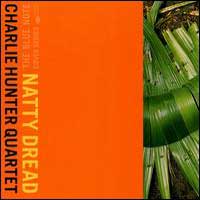

 Mehr ...
Mehr ...
In choosing to record Bob Marley's classic 1974 reggae album Natty Dread track-for-track in an instrumental jazz style, eight-string guitarist Charlie Hunter opened himself up for skepticism. Yet an idea that looked questionable in theory would prove stellar in practice, as Hunter turned Natty Dread -- with the songs sequenced exactly as they were on Marley's original release -- into one of the best CDs of his career. Hunter's customized eight-string instrument and prodigious talent allow him to play simultaneous guitar melodies and basslines, but his Wurlitzer organ simulations and walking bass aren't the only highlights of the opening "Lively Up Yourself." Alto saxophonist Calder Spanier and tenorman Kenny Brooks alternate between swinging leads and supportive harmonies, and drummer Scott Amendola gets in creative solo flurries near the end. Hunter's beautiful intro to "No Woman, No Cry" echoes both Pat Martino and Django Reinhardt; the saxophonists' interplay and Amendola's clever rimshots, tom-toms, and cowbell work lively up "Them Belly Full." The secrets to Hunter's success lie in separate amplifiers for his instrument's guitar and bass portions; great wah-wah pedal work to achieve keyboard tones, and the requisite brain power to play basslines with both thumbs while fretting and fingerpicking the melodies. All are illustrated in readings of the tranquil "Rebel Music," energetic "So Jah Seh" and the shuffling title track. Throughout Natty Dread, reggae is implied more often than played, as Hunter and his quartet portray the fun they had in arranging these pieces with performances both swinging and stirring (even dropping an "I Shot the Sheriff" quote into "Bend Down Low"). Spanier died after Natty Dread's release when he was struck by a car, and Hunter subsequently moved from California to New York and restructured his band. There's no telling what might have come afterward from this quartet of two saxophonists, a drummer, and Hunter, the one-man guitarist, keyboardist, and bassist.
(by Thom Jurek, All Music Guide)
|
| The Jazz Mandolin Project: "Xenoblast" (Aug. 1999) |
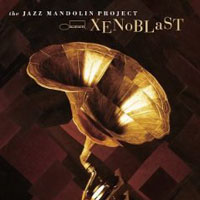 Mandoline, Kontrabass und Schlagzeug - eine ausgezeichnete Kombination,
um zu jazzen. Jamie Masefield ist ein Meister der 8 Saiten. Gerade
in Jamband-Kreisen ist die Kapelle sehr beliebt und wurde mit diesem zweiten
Album sogar fÞr das legendÃĪre Blue Note-Label verpflichtet.
Als Gast dabei: Jamrock-Halbgott Trey Anastasio von Phish an der
Gitarre.
Mandoline, Kontrabass und Schlagzeug - eine ausgezeichnete Kombination,
um zu jazzen. Jamie Masefield ist ein Meister der 8 Saiten. Gerade
in Jamband-Kreisen ist die Kapelle sehr beliebt und wurde mit diesem zweiten
Album sogar fÞr das legendÃĪre Blue Note-Label verpflichtet.
Als Gast dabei: Jamrock-Halbgott Trey Anastasio von Phish an der
Gitarre.
(07.10.2009)

 Mehr ...
Mehr ...
Previous recordings for the Accurate label yielded much the same type of instrumental music as on this, their major label debut. The Jazz Mandolin Project is less about straight ahead, mainstream jazz, and more into exploring a certain amount of improvisation within rock oriented and compositional contexts. Mandolinist Jamie Masefield churns out incessant chords like a guitarist, and his single line inventions fall along conventional staccato tonality. Bassist Chris Dalhgren cuts back his more progressive inclinations, while Ari Hoening provides steadying rhythms. On the rockier front, Phish guitarist Trey Anastasio cameos on the hard edged "Hang Ten," as he and Masefield crisscross ascending and descending scales. The title track is more a two chord surf rocker with avant and meditational breaks. More complex is the noisy intro with 5/4 ostinato bass to contrary 4/4 beat of "Igor." At their best developmentally is the multi-layered "Spiders" with a bass led ostinato, quirky 4/4 to 6/8 mandolin, groovin' bridge for single lines, juggernaut march or peaceful blues themes, and back to the ostinato. A caravan march with distinct Russian elements informs the rocky bridge of "Dromedary," and a slow, ponderous groove sets up "Jovan." At their most melodically centered is the very pleasant "Shaker Hill," reel flavored "The Milliken Way" with instrumental pop inclinations and endless chords, and the only legit jazz piece "Double Agent," with light boppish, nicely hued swing. Perhaps the band should change their name so as not to confuse the listener. There's more folkish power pop going on, but the unquestioned skilled musicianship of the three members is easy to peg. This writer finds their music tedious, but others may very well think it is refreshing, to each his/her own.
(by Michael G. Nastos, All Music Guide)
|
| St. Germain: "Tourist" (Mai 2000) |
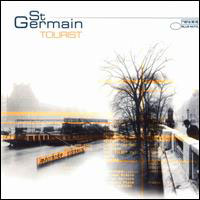 Ein Projekt des franzÃķsischen Produzenten Ludovic Navarre,
der hier erstaunliche Ergebnisse bei der Verbindung von Jazz und Electronik
erzielt: Bass, Schlagzeug und ein paar schicke Samples (u.a. Marlena Shaw
und John Lee Hooker) kommen aus dem Computer, dazu als "SahnehÃĪubchen"
echte Trompete, Saxofon, Gitarre, Piano und Perkussion: alles passt! Und
zurecht geadelt durch die VerÃķffentlichung bei dem legendÃĪren
Jazzlabel!
Ein Projekt des franzÃķsischen Produzenten Ludovic Navarre,
der hier erstaunliche Ergebnisse bei der Verbindung von Jazz und Electronik
erzielt: Bass, Schlagzeug und ein paar schicke Samples (u.a. Marlena Shaw
und John Lee Hooker) kommen aus dem Computer, dazu als "SahnehÃĪubchen"
echte Trompete, Saxofon, Gitarre, Piano und Perkussion: alles passt! Und
zurecht geadelt durch die VerÃķffentlichung bei dem legendÃĪren
Jazzlabel!
(04.06.2011)

 Mehr ...
Mehr ...
Since the advent of acid jazz in the mid-'80s, the many electronic-jazz hybrids to come down the pipe have steadily grown more mature, closer to a balanced fusion that borrows the spontaneity and emphasis on group interaction of classic jazz while still emphasizing the groove and elastic sound of electronic music. For his second album, French producer Ludovic Navarre expanded the possibilities of his template for jazzy house by recruiting a sextet of musicians to solo over his earthy productions. The opener "Rose Rouge" is an immediate highlight, as an understated Marlena Shaw vocal sample ("I want you to get together/put your hands together one time"), trance-state piano lines, and a ride-on-the-rhythm drum program frames solos by trumpeter Pascal Ohse and baritone Claudio de Qeiroz. For "Montego Bay Spleen," Navarre pairs an angular guitar solo by Ernest Ranglin with a deep-groove dub track, complete with phased effects and echoey percussion. "Land Of..." moves from a Hammond- and horn-led soul-jazz stomp into Caribbean territory, marked by more hints of dub and the expressive Latin percussion of Carneiro. Occasionally, Navarre's programming (sampled or otherwise) grows a bit repetitious -- even for dance fans, to say nothing of the jazzbo crowd attracted by the album's Blue Note tag. Though it is just another step on the way to a perfect blend of jazz and electronic, Tourist is an excellent one.
(by John Bush, All Music Guide)
|
| Norah Jones: "Come Away With Me" (Feb. 2002) |
|
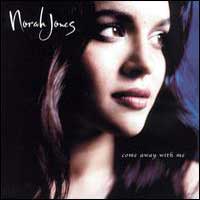 SpÃĪt entdeckt, aber nicht zu spÃĪt! Ein wunderbares Album,
das nicht schon alleine deshalb schlecht sein muss, weil so viele Leute
es offensichtlich auch sehr mÃķgen. Und der Nachfolger von 2004
"Feels Like Home" ist sogar noch
besser, nur eben nicht mehr so Þberraschend.
SpÃĪt entdeckt, aber nicht zu spÃĪt! Ein wunderbares Album,
das nicht schon alleine deshalb schlecht sein muss, weil so viele Leute
es offensichtlich auch sehr mÃķgen. Und der Nachfolger von 2004
"Feels Like Home" ist sogar noch
besser, nur eben nicht mehr so Þberraschend.
(Feb. 2004)

 Mehr ...
Mehr ...
|
Norah Jones's debut on Blue Note is a mellow, acoustic
pop affair with soul and country overtones, immaculately produced by
the great Arif Mardin. (It's pretty much an open secret that the 22-year-old
vocalist and pianist is the daughter of Ravi Shankar.) Jones is not
quite a jazz singer, but she is joined by some highly regarded jazz
talent: guitarists Adam Levy, Adam Rogers, Tony Scherr, Bill Frisell,
and Kevin Breit; drummers Brian Blade, Dan Rieser, and Kenny Wolleson;
organist Sam Yahel; accordionist Rob Burger; and violinist Jenny Scheinman.
Her regular guitarist and bassist, Jesse Harris and Lee Alexander, respectively,
play on every track and also serve as the chief songwriters. Both have
a gift for melody, simple yet elegant progressions, and evocative lyrics.
(Harris made an intriguing guest appearance on Seamus Blake's Stranger
Things Have Happened.) Jones, for her part, wrote the title track and
the pretty but slightly restless "Nightingale." She also includes
convincing readings of Hank Williams's "Cold Cold Heart,"
J.D. Loudermilk's "Turn Me On," and Hoagy Carmichael's "The
Nearness of You." There's a touch of Rickie Lee Jones in Jones's
voice, a touch of Bonnie Raitt in the arrangements; her youth and her
piano skills could lead one to call her an Alicia Keys for grown-ups.
While the mood of this record stagnates after a few songs, it does give
a strong indication of Jones' alluring talents" (David R. Adler,
All Music Guide)
|
|
| Cassandra Wilson: "Belly Of The Sun" (April 2002) |
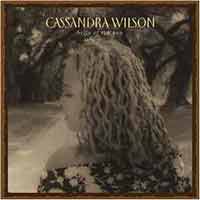 |
| Van Morrison: "What's Wrong With This Picture" (Okt. 2003) |
|
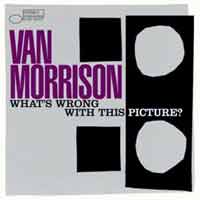 Mit seinem tatsÃĪchlich 32. Soloalbum ist Van The Man nun bei Blue
Note gelandet. Aber hierbei handelt es sich nicht um ein straightes
Jazz-Album, sondern um die Verdichtung seiner mannigfaltigen EinflÞsse
und um diesen unnachahmlichen Flow seiner Kompositionen, der sich auf
„What´s Wrong With This Picture“ gut geerdet zeigt.
Mit einer brillanten Version von „Saint James Infirmary“,
aber leider auch sattsam bekannten Songmustern (jeder weià wie
der Song „Somerset“ klingt). Sicher ist das hier aller Ehren
wert, einige werden hier ein „groÃes Alterwerk“ hÃķren
und ich will hier auch nichts Schlechtes Þber meinen alten Helden
sagen… Also lasse ich es und suche mal nach „Tupelo Honey“.
(Glitterhouse)
Mit seinem tatsÃĪchlich 32. Soloalbum ist Van The Man nun bei Blue
Note gelandet. Aber hierbei handelt es sich nicht um ein straightes
Jazz-Album, sondern um die Verdichtung seiner mannigfaltigen EinflÞsse
und um diesen unnachahmlichen Flow seiner Kompositionen, der sich auf
„What´s Wrong With This Picture“ gut geerdet zeigt.
Mit einer brillanten Version von „Saint James Infirmary“,
aber leider auch sattsam bekannten Songmustern (jeder weià wie
der Song „Somerset“ klingt). Sicher ist das hier aller Ehren
wert, einige werden hier ein „groÃes Alterwerk“ hÃķren
und ich will hier auch nichts Schlechtes Þber meinen alten Helden
sagen… Also lasse ich es und suche mal nach „Tupelo Honey“.
(Glitterhouse)
Das mag ja stimmen, lieber GlitterhÃĪusler. Und sicherlich ist
das Album nicht auf die Ebene von Tupelo
Honey zu heben. Aber im Gegensatz zu einem anderen meiner alten
Helden, Mr. Neil Young, liefert uns Mr. Morrison auch im fortgeschrittenen
Alter noch hÃķchste QualitÃĪt ab. AuÃerdem muss ich sagen: das
neue Album von VAN THE MAN ist, wie schon allen anderen Alben zuvor,
Balsam fÞr Ohren & Seele!
(26.10.2003)

 Mehr ...
Mehr ...
|
Die Rock & Roll Hall of Fame durfte er 1993 betreten,
die Songwriters Hall of Fame zu Beginn 2003; und nun, mit What's Wrong
With This Picture? hat Van Morrison auch eins der maßgeblichen
Labels der Jazzmusik betreten, Blue Note Records. Wohl getan, muss
man sagen, für Label und Sänger gleichermaßen, der
nicht erst mit zunehmendem Alter die Ästhetiken und Dynamiken
des Jazz, speziell seines großen Favoriten Mose Allison, in
seine songorientierte Musik mit einbezog.
Alles in allem ist dies Morrison, wie man ihn kennt, sein poetisch
ambitioniertes Songwriting, sein soulgetränkter Gesang, die blueshafte,
irisch-lakonische Grundhaltung und die warmen, fließenden Texturen
in den Arrangements, die das einfache seiner Songs adelnd hervorheben.
Wie der Mann mit dem Ruf, gerade dann die besten Konzerte zu spielen,
wenn er die übelste Laune hat, das genau macht, hat bisher niemand
analysieren können; wahrscheinlich wieder der "notorische"
menschliche Faktor, der Van, wie auch Elvis Costello, T-Bone Burnett,
Terry Callier und ein paar andere dieser seltenen Vögel, über
das restliche Federvieh hinaus hebt. Die Qualität seines neuen
Albums lässt sich folgerichtig ironisch dahin gehend beschreiben,
dass man nun hoffen muss, dass Morrison in nächster Zeit keine
Konzerte gibt -- denn er ist guter, sehr guter Dinge auf dieser Platte.
What's Wrong With This Picture? beginnt mit dem Titelsong, in dem
Van müde lächelnd und geduldig verdeutlicht, dass er einiges
dessen, was viele immer noch in ihm sehen, längst hinter sich
gelassen hat. Das geht über in gut gelaunten R'n'B-Swing, eine
Soulnummer in bester Marvin-Gaye-Tradition, dann wieder: der Blues,
unvermeidbar und gut. Die Band ist seine beste seit Jahren, die Bläser-
und Streichersätze sind vom Allerfeinsten, der legendäre
Mr. Acker Bilk hat einen wunderbaren Gastauftritt beim Standard "St.
James Infirmary" und Van singt so entspannt, energetisch und
treffsicher wie lange nicht mehr.
Wenn man das Album letztlich doch nicht in eine Reihe stellen kann
mit Morrison-Klassikern wie Astral
Weeks, Veedon Fleece oder
auch Common One, dann nur, weil
die Vorgenannten in ihrer Zeit fortschrittlich, innovativ waren und
What's Wrong With This Picture? es heute nicht sein kann. Die neuerliche
Manifestation eines überdurchschnittlichen Standards ist sie
allemal. (Rolf Jäger, Amazon)
|
|
| Al Green: "I Can't Stop" (Nov. 2003) |
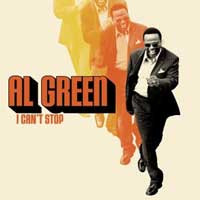 VÃķllig
Þberraschend nach so vielen Jahren ein Album des besten SoulsÃĪngers
Þberhaupt (natÞrlich neben Otis Redding). Als wÃĪre
seit "Let's Stay Together" keine 30 Jahre vergangen. Wenn es
zeitlos gute Popmusik gibt: dann so was! Und der GlitterhÃĪusler soll
sich die Platte einfach noch mal anhÃķren. VÃķllig
Þberraschend nach so vielen Jahren ein Album des besten SoulsÃĪngers
Þberhaupt (natÞrlich neben Otis Redding). Als wÃĪre
seit "Let's Stay Together" keine 30 Jahre vergangen. Wenn es
zeitlos gute Popmusik gibt: dann so was! Und der GlitterhÃĪusler soll
sich die Platte einfach noch mal anhÃķren.
(11.12.2003)

 Mehr ...
Mehr ...
Nach einem groÃen weiÃen SoulsÃĪnger (Van Morrison) ist nun auch einer der grÃķÃten schwarzen Soulstimmen beim Jazzlabel Blue Note gelandet. Und das Ergebnis ist wie bei Van aller Ehren wert, Al Green hat keine Kompromisse an ZeitstrÃķmungen und aktuelle Moden gemacht - keiner rappt, keine HipHop-Beats sind zu hÃķren und die Neptunes haben auch nicht produziert. Da wird auch die Bemusterung mit 20.000 Postkarten in ausgesuchten Scene-Clubs, Cocktail- und Hotelbars nicht viel nutzen.
Denn das Herstellungsdatum von "I Can't Stop" wÃĪre in einem Blind Date kaum zu lokalisieren, denn Green hat sich mit Entdecker, Produzent und Hi-Labelchef Willie Mitchell zusammengetan, dem Mann, mit dem er seine grÃķÃten Erfolge feierte. Und dieser hat nur allerfeinste 70er-Southern-Soul-Zutaten fÞr dieses kleine Festmahl verwand, rollende Hammond-B3-SchÞbe, pechschwarze GospelchÃķre und auch dieser perfekte und unachahmliche Hi-Groove hat noch immer nichts von seiner Faszination eingebÞsst. Dem Info nach wurde das Album gar quasi live in den heiligen Hi-Studio zu Memphis aufgenommen.
Warum bin ich als alter Fan dann nicht total begeistert? Kann ich nicht mal sagen, vielleicht geht es mir hier ÃĪhnlich wie bei Van Morrison. Wenn ich den hÃķren will, dann lege ich was aus den frÞhen/mittigen 70ern auf. So geht's mir mit Al Green eigentlich auch. Und so ein Þberragendes SpÃĪtwerk wie die Solomon Burke Auferstehung ist "I Can't Stop" auch nicht. Aber andererseits muà man den in den letzten Jahren als Prediger arbeitenden Soul-Giganten auch fÞr seine integere RÞckkehr beglÞckwÞnschen. Denn eigentlich finden sich mit "My Problem Is You", "Million To One" und einigen anderen noch echte Juwelen unter den 12 selbst geschrieben Tunes. Und RÞckgrat hat der Kerl auf jeden Fall und sowieso macht er auf dem Cover einen ganz ausgeschlafenen Eindruck. Und das ist ja auch was.
(Glitterhouse)
|
| Norah Jones: "Feels Like Home" (Feb. 2004) |
|
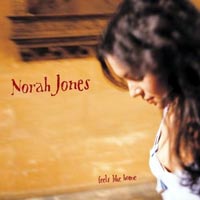 Auch diese Platte ist natÞrlich kein Geheimtipp. Schon das DebÞt
"Come Away With Me" hatte mir eigentlich
recht gut gefallen, obwohl es nie in der Rubrik "Frisch Ausgepackt"
aufgetaucht ist. Immerhin hatte es bis zum letzten Herbst gedauert,
bis ich die Platte endlich auch zu hause hÃķren konnte, da ich die
Kopplung mit dem Konzertvideo "Live In New Orleans" als Weihnachtsgeschenk
fÞr mein Schwesterlein gekauft hatte. Drei GrÞnde sprachen
diesmal aber fÞr eine sofortige Anschaffung:
Auch diese Platte ist natÞrlich kein Geheimtipp. Schon das DebÞt
"Come Away With Me" hatte mir eigentlich
recht gut gefallen, obwohl es nie in der Rubrik "Frisch Ausgepackt"
aufgetaucht ist. Immerhin hatte es bis zum letzten Herbst gedauert,
bis ich die Platte endlich auch zu hause hÃķren konnte, da ich die
Kopplung mit dem Konzertvideo "Live In New Orleans" als Weihnachtsgeschenk
fÞr mein Schwesterlein gekauft hatte. Drei GrÞnde sprachen
diesmal aber fÞr eine sofortige Anschaffung:
- das Video stellte sich als absolut gut heraus, vor allem musikalisch,
aber es ist auch wegen Miss Jones ist in ihrer "schÞchternen"
Art visuell ziemlich beeindruckend.
- bei den Aufnahmen zu "Feels Like Home" waren Levon Helm
und Garth Hudson, zwei meiner alten Helden von The
Band, dabei (auf "Live In New Orleans" wird sogar "Bessie
Smith" von Basement Tapes
gecovert!)
- mit der Coverversion "Be Here To Love Me" wird posthum Townes
Van Zandt, auch einer meiner Helden, geehrt.
Jetzt wo die Platte bei mir lÃĪuft, bin ich total begeistert. Es
ist zwar kein Hit vom "I Don't Know Why"-Kaliber dabei, was
vielleicht gar nicht so schlecht ist, denn so wird das bei mir sicherlich
eine Platte mit Langzeitwirkung. Und viel Wurlitzer-Piano. Falls das
jemanden interessiert.
(28.02.2004)

 Mehr ...
Mehr ...
|
"Tja, das war ein Einstand, der sich gewaschen hatte:
Über 16 Millionen Mal ging das Debütalbum von Norah Jones Come
Away With Me über die Ladentheken, sie sammelte rund 80 Platin-Auszeichnungen
ein und -- sozusagen als Krönung der jungen Musik-Königin --
überhäufte die amerikanische Schallplattenindustrie die Künstlerin
und ihr Erstlingswerk mit insgesamt acht (!) Grammys. Die Welt erlebte
die Geburt eines Weltstars -- einer Musikerin, die mit auffallend leisen,
akustischen, stilistisch kaum einzuordnenden Klängen höchst
erfolgreich gegen den Trend-Strom anschwamm. Was kann da noch kommen?
Antwort: Feels Like Home, ihr zweites Album.
Feels Like Home ist mehr als nur eine Fortsetzung ihrer mit Come Away
With Me begonnen künstlerischen Reise; mehr, als eine kreative Bestätigung
ihres großen Talents; mehr als eine CD ohne einen einzigen Durchhänger.
Feels Like Home ist auch das Reifezeugnis einer scheinbar unbeirrbar gefestigten
Musikerin. Denn genau wie ihr Erstlingswerk wird auch dieses zweite, wieder
von Arif Mardin produzierte Album zuvorderst von einer faszinierend lässigen,
relaxten Atmosphäre geprägt. So hat man beim Durchhören
der CD sogar den Eindruck, dass die New Yorkerin im Vergleich zum Debüt
noch einen Gang zurück schaltet: Wie kaum eine andere lässt
sie die Songs atmen und sich entwickeln, lässt sie Pausen und ganz,
ganz ruhige Momente zu, und schafft dadurch Spannungsbögen, die den
Hörer mit sanfter Gewalt zu fesseln vermögen. Keine Frage: eine
Meisterleistung!
Stilistisch ist die rehäugige Schönheit mit den dunklen Barbie-Locken
genauso wenig einzuordnen wie bei ihrem Debüt: Steht bei den Titeln
das Klavier oder E-Piano (ein knurrendes Fender Rhodes!) im Vordergrund,
überwiegen jazzige Elemente. Spielt in Songs wie "Humble Me"
oder "The Long Way Home" die Akustik-Gitarre die erste Geige,
sind es auch mal reinrassige Folk-Songs. Ein Schuss Country muss natürlich
auch wieder sein: "Creepin' In" heißt der Bluegrass-Feger
(mit Abstand der schnellste Song der CD), bei dem sich Norah Jones mit
hörbarem Spaß das Mikro mit Country-Queen Dolly Parton teilt.
Trotz der vielen stilistischen Ausritte lässt sich ein gemeinsamen
Nenner ausmachen: der Blues. Aus zwei Gründen: Zum einen wegen der
latent melancholischen Note in den Kompositionen, zum anderen wegen Norah
Jones' bluesig-angerauhter Stimme. So erinnert sie in Timbre, Feeling
und Ausdruck an eine sanftere Ausgabe einer Janis Joplin. Beste Beispiele
hierfür sind "In The Morning" und "Be Here To Love
Me". Hätte die wilde Janis damals nicht flaschenweise Jack Daniels
konsumiert und stattdessen nur ab und zu an einem Bud genippt, hätte
sie -- wer weiß -- wohl so ähnlich geklungen. Gewiss aber länger
gelebt." (Gunther MatejkaAus der Amazon.de-Redaktion)
"Ihr Pianosound ist dunkel wie ein Nachtclub bei Stromausfall.
Und sie hat eine einmalige Art, ihre Stimme zum Hauchen werden zu lassen,
während ihr Gesang gerade dynamisch anschwillt. Diese Art der Phrasierung
ist die letzte Spur Jazz, die uns die achtfache Grammy-Siegerin nach ihrem
16-Millionen-Debüt "Come away with me" noch gönnt.
Ihr neues Album ist voller Balladen auf der breiten Basis von Folk und
Country; es ist eins, das uns sediert und melancholisch glücklich
macht. Der perlende Folk von "Sunrise" oder das Boom- tschicka-boom
des Waits-Covers "The long Way home" sind überraschungslos
inszeniert, erfüllen aber auch geschickt die Erwartungen. Nur bei
"Creepin' in", einem flotten Country-Duett mit Dolly Parton,
heben wir einmal irritiert die Braue. Dem Album fehlt die Zauberkraft
des Erstlings, doch vielleicht liegt das nicht am Album selbst, sondern
daran, dass eine solche Verblüffung nur mit der Sensation selber
und nicht mit ihrer Wiederholung zu erzielen ist. Eine Platte für
Männer, die gern taktisch den Sensiblen spielen - und für Frauen,
die sich in der postfeministischen Rolle der starken Scheuen wohl fühlen.
Zusammen gibt es davon global bestimmt mehr als 16 Millionen." (mw,
Kulturnews)
"Zwei Jahre nach der Veröffentlichung ihres mit
zigfachem Platin und acht Grammys ausgezeichneten Debütalbums Come
Away With Me kehrt Norah Jones mit einer superben Sammlung neuer Songs
zurück. Für das Album Feels Like Home arbeitete die Sängerin,
Songwriterin und Komponistin einmal mehr mit dem Produzenten Arif Mardin
zusammen, sowie mit dem Toningenieur Jay Newland und ihrer Begleitband.
Neben eigenen Songs adaptierte Norah Jones auch Songs ihrer Bandkollegen
und von dem Sänger und Songwriter Richard Julian. Außerdem
hat Jones einige Songs gecovert, darunter "Be Here To Love Me"
von Townes Van Zandt und Duke Ellingtons Komposition "Melancholia",
für die sie einen Text schrieb und die nun unter dem Titel "Don't
Miss You At All" erscheint.
Norah Jones hat den größten Teil von Feels Like Home mit jener
Formation aufgenommen, die sie auch auf ihren Tourneen begleitet: Adam
Levy und Kevin Breit (guitars), Daru Oda (keyboards/backing vocals), Lee
Alexander (bass) und Andrew Borger (drums). "Ich wollte keine überproduzierte
Platte machen" erläutert die Künstlerin. "Außerdem
spielt die Band nun seit zwei Jahren kontinuierlich zusammen und man fühlt
sich wohl. Die Aufnahmen für das neue Album haben Spaß gemacht,
weil wir uns so gut kennen. Die Herangehensweise war genauso wie beim
ersten Album: Wir haben uns gute Songs ausgesucht, von denen viele von
der Band selbst stammen, und versucht, die bestmöglichen Aufnahmen
davon zu machen. Und mit dem Ergebnis bin ich wirklich glücklich."
Wie schon auf ihrem Debüt deckt Norah Jones mit Feels Like Home ein
vielfältiges stilistisches Spektrum ab, das neben Country und Pop
natürlich auch Jazz umfasst. War Come Away With Me noch ausgesprochen
ruhig und von Balladen geprägt, variiert Norah Jones nun das Tempo
und hat auch schnellere Songs. So ist die erste Singleauskopplung, "Sunrise",
die Jones mit ihrem Bassisten Lee Alexander geschrieben hat, lebhaft und
überschäumend; "Above Ground", von Oda und Borger
geschrieben, hat einen Hauch von Funk; und "In The Morning",
ein Beitrag von Levy mit Wurlitzer-Solo, zeigt eine Norah Jones, die sich
mit ihrer warmen Stimme völlig dem Blues hingibt." (EMI Music)
|
|
| Thelonius Monk Quartet with John Coltrane: "At Carnegie Hall" (29. Nov. 1957/Sept. 2005) |
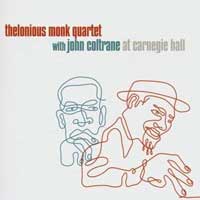 Wahnsinn! Ein neues Album von Monk und Trane, zwei der wichtigsten
Jazzmusiker aller Zeiten und auch zwei meiner absoluten Favoriten! Die
Aufnahmen stammen von einem WohltÃĪtigkeitskonzert in der New Yorker
Carnegie Hall vom 29.11.1957 und wurden erst kÞrzlich in einem verstaubten
Archiv entdeckt. Geniale Musik - und ein fantastischer Sound!
Wahnsinn! Ein neues Album von Monk und Trane, zwei der wichtigsten
Jazzmusiker aller Zeiten und auch zwei meiner absoluten Favoriten! Die
Aufnahmen stammen von einem WohltÃĪtigkeitskonzert in der New Yorker
Carnegie Hall vom 29.11.1957 und wurden erst kÞrzlich in einem verstaubten
Archiv entdeckt. Geniale Musik - und ein fantastischer Sound!
(05.11.2005)

 Mehr ...
Mehr ...
|
Das ist schon eine kleine Sensation: in der Kongressbibliothek von Washington
DC findet Jazz-Experte Larry Applebaum ein Band, einen Live-Mitschnitt,
schlecht beschriftet, unscheinbar, und - hält eine Aufnahme vom Thelonious
Monk Quartet mit John Coltrane in den Händen. Ein ganz besonderer
Fund, denn die Zusammenarbeit der beiden Jazzgiganten währte nur
ein halbes Jahr, es gibt kaum und auch nur schlechte Aufnahmen aus der
Zeit im "Five Spot" in New York, wo die Band im Jahre 1957 häufig
auftrat. Coltrane befand sich damals zwischen zwei Engagements bei Miles
Davis. Nachdem dieser ihn Anfang 1957 wegen notorischer Unzuverlässigkeit
gefeuert hatte, gelang Coltrane der entscheidende persönliche Schritt
- er befreite sich durch einen konsequenten Entzug von Alkohol und Heroin.
Ebenso in die Zeit mit Monk fällt John Coltranes legendäres
Album Blue Train, übrigens das einzige, das er für Blue Note
als Bandleader aufnahm.
John Coltrane lernte von Monk den Umgang mit komplexen melodischen und
rhythmischen Strukturen und begann, als einziger Bläser des Quartetts,
ausgedehntere, immer freiere Soli zu spielen. At Carnegie Hall wurde am
29. November 1957 aufgezeichnet: fast am Ende und vielleicht am Höhepunkt
der für beide Musiker äußerst bereichernden Zusammenarbeit.
Fast alle Stücke stammen aus Monks Feder, am Schlagzeug brilliert
Shadow Wilson, Ahmed Abdul-Malik spielt Kontrabass. Es ist eine leidenschaftliche
Begegnung, klanglich tadellos festgehalten: ein Fest für jeden Liebhaber
und Sammler.
(Katharina Lohmann, amazon)
|
|
| Cassandra Wilson: "Thunderbird" (MÃĪrz 2006) |
|
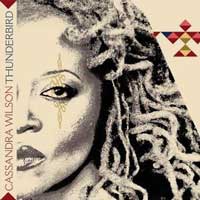 Eigentlich hatte ich mich auf das Album sehr gefreut, als ganz kurzfristig die
VorankÞndigung per Email kam, u. a. weil als Produzent T-Bone
Burnett erwÃĪhnt wird. Aber direkt bei der ersten Nummer gibt
es Computerbeats, die mir erstmal den Appetit verdorben haben. AuÃerdem
fehlt die ultimative Coverversion, fÞr die ich Mrs. Wilson so sehr
liebe (ich denke da z.B. wehmÞtig an das grandiose, gegen den Strich
gebÞrstete "Harvest Moon" auf "New
Moon Daughter" von 1995 und "Tupelo Honey" auf "Blue
Light 'Til Dawn" von 1993). Aber ich werde mich in den nÃĪchsten
Tagen dazu noch mal ÃĪussern ...
Eigentlich hatte ich mich auf das Album sehr gefreut, als ganz kurzfristig die
VorankÞndigung per Email kam, u. a. weil als Produzent T-Bone
Burnett erwÃĪhnt wird. Aber direkt bei der ersten Nummer gibt
es Computerbeats, die mir erstmal den Appetit verdorben haben. AuÃerdem
fehlt die ultimative Coverversion, fÞr die ich Mrs. Wilson so sehr
liebe (ich denke da z.B. wehmÞtig an das grandiose, gegen den Strich
gebÞrstete "Harvest Moon" auf "New
Moon Daughter" von 1995 und "Tupelo Honey" auf "Blue
Light 'Til Dawn" von 1993). Aber ich werde mich in den nÃĪchsten
Tagen dazu noch mal ÃĪussern ...
(09.04.2006)
Tja ... irgendwie werde ich mit dem Album wohl nicht mehr warm. Zuerst
hatte ich keine Lust, es noch mal aufzulegen. Dann hab ich es doch noch
mal gehÃķrt und es machte immer noch nicht "klick". SchlieÃlich
ist die CD ganz aus meiner Aufmerksamkeit verschwunden...
(Weihnachten 2006)
|
| "Keren Ann" (April/Juni 2007) |
 Dies ist wohl schon das dritte Album der Dame, die aus Israel stammt,
in Paris aufgewachsen ist und inzwischen in New York lebt und arbeitet.
FrÞhere Alben sollen in FranzÃķsisch sein, aber auf diesem titellosen
Album wurde erstmals ausschlieÃlich Englisch gesungen. FÞr ÃĪltere
Zeitgenossen: Es klingt stark nach Velvet
Underground. Etwas JÞngere unter uns fÞhlen sich vielleicht
ein wenig an die Band Mazzy Star erinnert,
die ja aber auch im Grunde nach VU klangen.
So etwas mag ich natÞrlich sehr!
Dies ist wohl schon das dritte Album der Dame, die aus Israel stammt,
in Paris aufgewachsen ist und inzwischen in New York lebt und arbeitet.
FrÞhere Alben sollen in FranzÃķsisch sein, aber auf diesem titellosen
Album wurde erstmals ausschlieÃlich Englisch gesungen. FÞr ÃĪltere
Zeitgenossen: Es klingt stark nach Velvet
Underground. Etwas JÞngere unter uns fÞhlen sich vielleicht
ein wenig an die Band Mazzy Star erinnert,
die ja aber auch im Grunde nach VU klangen.
So etwas mag ich natÞrlich sehr!
(30.09.2007)

 Mehr ...
Mehr ...
|
Keren Ann Zeidel's international pedigree — born in Tel Aviv, raised
in Paris, now splits her time between there and New York — served
her well on her first four albums, but this fifth, sung entirely in English,
is her most worldly yet. Chalk that up, one would suppose, to a busy touring
life and a growing confidence to experiment both with identity and available
musical tools. By self-titling the album, Keren Ann is by default making
a statement that this is her statement. That means that the recording
would have to be not only extra-special good but representative of who
she thinks she is at the moment it is unleashed on an ever-growing audience.
And it is that good: it's the singer/songwriter's most far-reaching, defining
album yet. While her trademark wisp of a voice still dominates most of
the album's real estate, it meets up here with a different, more aggressive
and courageous Keren Ann as well: On "It Ain't No Crime," with
its heavy blues thump and screaming distorted guitar, she sings in a compressed,
insistent voice, "There are no victims/There is no truth/We take
their money/They take our youth," something so surprisingly shivery
the Keren Ann of albums one through four would never have dared go there.
The record, at times, is a circus of sounds, an ornate hodgepodge of moody
keyboards and skronky guitars, wordless angel chorales, ambient electronics,
airy woodwinds and overcharged fuzzboxes. On the album's minimal, Velvets-ish
opener, "It's All a Lie," a slow build sucks in droning bass
and distant sonic chaos beneath Keren Ann's typically languid vocal. She
barely rises above Cowboy Junkies lethargy, and the song never picks up
the pace from there but, drenched in reverb, a climax sneaks up, the song
finally sputtering around directionless like a balloon whose air has been
let out. On "The Harder Ships of the World," over lightly plucked
guitar, she manages to squeeze every bit of expression out of an almost
non-existent range of dynamics, barely rising above a whisper but drenching
every word in raw emotion. More so than before, perhaps, Keren Ann seems
to be enjoying herself, directing her music less self-consciously than
before and asserting her eagerness to shift moods and stretch the sonic
easel on which she builds. Her enunciation, no doubt because of her geographic
rootlessness, isn't always as clear as it could be, but that indistinctiveness
ultimately serves to add an even larger air of mystery to the already
mysterious. The six-minute tour de force "Liberty" spends its
last couple of minutes dishing out a repetitive piano tinkle, disembodied
vocal chorus and aimless, backwards looped instruments — all of that
vies for attention but the singer pays it no mind as she goes about her
business. On "Lay Your Head Down," polyrhythmic handclaps and
surfy guitar precede a half-spoken intro, which suddenly morphs into utter
prettiness. Keren Ann never really says more than "Why don't you
lay your head down in my arms?," allowing the various strings, harmonica
and layered vocals to amend her thoughts. She doesn't need to: she's said
all she has to say. Keren Ann fills all of the air and space here but
the music never feels crowded and never loses its way. Only an artist
who has run head-on into self-discovery can get away with that.
(by Jeff Tamarkin, All
Music Guide)
|
|
|
Don't say nothing, I speak for two, singt sie im schleppenden Pseudoblues
"It ain't no Crime" (dem unpassendsten Song der Platte), und
das klingt merkwürdig aus dem Mund einer wie verschleiert wirkenden
Sängerin, deren Musik Schüchternheit ausstrahlt und einen Hang
zu Tranquilizern. Die Französin Keren Ann lebt in New York und schreibt
Songs auf Englisch. Bei manchen dieser Lieder muss man an die frühen
Velvet Underground denken - nicht wegen Nico, deren maskuline Erotik Keren
Ann abgeht; sondern wegen der Klangstatuen, die manchmal aus dem Hintergrund
den Hauchgesang der Sängerin zu beobachten scheinen. Solche Songs
hätte John Cale produziert haben können; beim kargen Geklöppel
von "Lay your Head down" hingegen fühlt man sich anfangs
an Lou Reeds Stil erinnert. Jedenfalls bezirzen uns Keren Ann und Tonmeister
Joe Barresi mit Transparenz, mit verspielten Klangfarben von Gitarren,
Geigen, Elektronik, Perkussion und Bässen, alles aus den Tiefen der
Nacht. Ein apartes Album, das man neben Carla Bruni ins Archiv stellen
sollte.
(www.kulturnews.de)
|
|
| Al Green: "Lay It Down" (Mai 2008) |
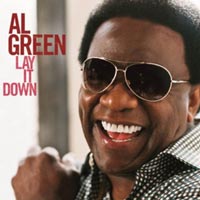 BlÃķde Brille, tolle Musik! Al Green hat sich dieses mal nicht von
seiner alten Memphis-GÃĪng um Wilie Mitchell begleiten lassen, sondern
von einer Studioband um den Schlagzeuger und Produzenten ?uestlove,
der wohl von der berÞhmten (?) Hipp-Hopp(?)-Band The Roots
kommt. Man verzeihe mir meine Ignoranz und die vielen Fragezeichen (kleiner
Witz), aber ich kenne mich in jener Branche leider nicht aus. Die einzige
Platte in meinem Plattenschrank, auf der dieser offensichtlich ausgezeichnete
Musiker zu hÃķren ist, ist "The Soul
Sessions" von Joss Stone, deren Retro-Soul nicht sehr
weit weg ist von Al Green. Und auch auf "Lay It Down" klingt
Al Green so wie immer. Was natÞrlich eine gute Sache ist.
BlÃķde Brille, tolle Musik! Al Green hat sich dieses mal nicht von
seiner alten Memphis-GÃĪng um Wilie Mitchell begleiten lassen, sondern
von einer Studioband um den Schlagzeuger und Produzenten ?uestlove,
der wohl von der berÞhmten (?) Hipp-Hopp(?)-Band The Roots
kommt. Man verzeihe mir meine Ignoranz und die vielen Fragezeichen (kleiner
Witz), aber ich kenne mich in jener Branche leider nicht aus. Die einzige
Platte in meinem Plattenschrank, auf der dieser offensichtlich ausgezeichnete
Musiker zu hÃķren ist, ist "The Soul
Sessions" von Joss Stone, deren Retro-Soul nicht sehr
weit weg ist von Al Green. Und auch auf "Lay It Down" klingt
Al Green so wie immer. Was natÞrlich eine gute Sache ist.
(25.06.2008)

 Mehr ...
Mehr ...
Ein neues Album von Soulgott Al Green ist nach dem programmatischen "I can't stop" (2003) keine Sensation mehr. "Everything's OK" schloss 2005 nahtlos ans groÃartige Comeback an. Die wiederbelebte Kooperation mit Willie Mitchell, dem Produzenten seiner Klassiker aus den 70ern, war ein GlÞcksgriff. Denn dieser Sound war nicht gealtert, im Gegenteil: Er war lÃĪngst eingesickert in die ClubsphÃĪre und hatte so eine neue Generation sensibilisiert fÞr Retrosoul à la Joss Stone und Amy Winehouse. Doch was ist das - kein Mitchell mehr! Stattdessen hat Green sich in junge HÃĪnde begeben, in jene von HipHop- und R'n'B-Leuten wie ?uestlove oder James Poyser. Alte Fans werden platzen vor Skepsis - doch sie kÃķnnen beruhigt sein: Diese Typen wissen, wie man Respekt buchstabiert. Statt die weiterhin hell strahlende Goldkehle Green mit handelsÞblicher Studiotechnik auf Zeitgeist zu trimmen, wirkt die Produktion wie eine einzige Hommage an Mitchell. Das Schlagzeug klingt heimelig dumpf, als schlÞge jemand auf eine noch nachtwarme Matratze ein, die dicke Streicherbutter Ãķlt aufs Geschmeidigste das gemÞtliche Groovescharnier der Songs, die Hammond schmachtet amtlich, und die BlÃĪser der Dap-King Horns wedeln im Hintergrund mit Samt und Seide. Selbst GesangsgÃĪste wie John Legend oder Corinne Bailey Rae bemÞhen sich erfolgreich, nicht sonderlich zu stÃķren. Eine erneut tolle Platte von Green - er kann einfach nichts mehr falsch machen.
(kulturnews.de)
Aaaah - es tut so gut, dass er noch da ist. Al Green ist einer der letzten seiner Generation der ganz groÃen Soul-Stimmen, in den 80ern zunehmend dem frÃķmmelnden Gospel zugetan (das kann er aber auch wie kaum ein anderer), in den 90ern fast in der Versenkung verschwunden (bzw. als Prediger aktiv), legte Al Green vor fÞnf Jahren mit "I Can't Stop" ausgerechnet auf Blue Note Records ein wunderbares Comeback hin, wie einst im Mai vom groÃen Willie Mitchell deep down in Memphis produziert. Der Nachfolger "Everything's Okay" hielt in ÃĪhnlicher personeller Konstellation spielend dieses Niveau und zelebrierte alte Hi-Erfolge, und jetzt fehlt Mitchell plÃķtzlich auf diesem dritten Blue Note-Album. Oje, denkt man gleich, wie soll das nur gut gehen? Doch es geht mehr als gut, denn Green findet den denkbar besten Ersatz, nur eine Generation jÞnger. Die Produktions-arbeit teilen sich auf diesem Album nÃĪmlich der erneut ganz groÃartige ?uestlove, eigentlich Drummer bei der HipHop-Crew The Roots, in Wirklichkeit aber ein Allround-Genie als Musiker, Producer und auch DJ. An seiner Seite findet sich James Poyser, der Mann hinter den ersten (und besten) Alben von Erykah Badu, ein stilsicherer Teamplayer als Keyboarder und Produzent. Statt Memphis Horns erklingen diesmal die ebenso guten Dap-Kings Horns, die Gitarre bedient Chalmers Alford (Joss Stone) und als Gastvokalisten hÃķren wir John Legend, Anthony Hamilton und die Britin Corinne Bailey Rae. Und keine Angst, auch diesmal klingt hier alles nach alter Schule, fast lÃĪsst sich "Lay It Down" als Tribute an Mitchells ProduktionskÞnste verstehen, so authentisch klingen BlÃĪser, Orgel und Gitarren - ganz ohne jede Elektronik oder sonstige Modernismen. Der Meister selbst ist bei bester Stimme, smooth-voiced durch und durch, upliftend und optimistisch - Love is the Message, auch mit deutlich verjÞngtem Team.
(Joe Whirlypop, Glitterhouse)
|


 Ich komme bei diesen frÞhen Aufnahmen von Monk, Miles & Co. immer ein wenig durcheinander,
denn die Aufnahmen stammen zwar von 1947 und '48, wurden aber zuerst als 78er Schellacks verÃķffentlicht,
als 1o"-Alben auf Vinyl wohl aber erst spÃĪter, denn die ersten 10"
von Blue Note erschienen erst 1951. Ein Pflichtkauf, weil Monks erste eigene Version von "'Round Midnight" mit dabei ist.
Ich komme bei diesen frÞhen Aufnahmen von Monk, Miles & Co. immer ein wenig durcheinander,
denn die Aufnahmen stammen zwar von 1947 und '48, wurden aber zuerst als 78er Schellacks verÃķffentlicht,
als 1o"-Alben auf Vinyl wohl aber erst spÃĪter, denn die ersten 10"
von Blue Note erschienen erst 1951. Ein Pflichtkauf, weil Monks erste eigene Version von "'Round Midnight" mit dabei ist. Mehr ...
Mehr ...
 Der zweite Teil des Monk-Klassikers, dieses Mal mit Aufnahmen von 1947 bis '51, auf meiner CD sogar mit Aufnahmen von 1952.
Der zweite Teil des Monk-Klassikers, dieses Mal mit Aufnahmen von 1947 bis '51, auf meiner CD sogar mit Aufnahmen von 1952.
 Miles in Quartettbesetzung mit Horace Silver, Percy Heath und Art Blakey.
Diese gut klingenden Aufnahmen gelten als eine der frÞhesten im Hardbob-Stil.
Miles in Quartettbesetzung mit Horace Silver, Percy Heath und Art Blakey.
Diese gut klingenden Aufnahmen gelten als eine der frÞhesten im Hardbob-Stil. Mehr ...
Mehr ...
 Na? Kommt Euch das Cover bekannt vor? Genau, Joe Jackson hat
es mal fÞr sein jazzangehauchtes Album "Body
And Soul" nachgestellt. Auch der Plattentitel bezieht sich
auf Jazz, denn der gleichnamige Song wurde damals in der Version von
John Coltrane bekannt.
Na? Kommt Euch das Cover bekannt vor? Genau, Joe Jackson hat
es mal fÞr sein jazzangehauchtes Album "Body
And Soul" nachgestellt. Auch der Plattentitel bezieht sich
auf Jazz, denn der gleichnamige Song wurde damals in der Version von
John Coltrane bekannt.
 Mehr ...
Mehr ...

 Mehr ...
Mehr ...

 Ein eher unbekanntes Album des grÃķÃten Saxofonisten aller Zeiten,
noch vor denen bei Atlantic und Impulse und sein einziges
fÞr Blue Note. Mit der bewÃĪhrten Rhythmusgruppe von Miles
Davis (Schlagzeuger Philly Joe Jones und Bassist Paul Chambers),
Kenny Drew am Piano, Posaunist Curtis Fuller und Trompeter
Lee Morgan war das sogar ein Sextett mit drei BlÃĪsern.
Ein eher unbekanntes Album des grÃķÃten Saxofonisten aller Zeiten,
noch vor denen bei Atlantic und Impulse und sein einziges
fÞr Blue Note. Mit der bewÃĪhrten Rhythmusgruppe von Miles
Davis (Schlagzeuger Philly Joe Jones und Bassist Paul Chambers),
Kenny Drew am Piano, Posaunist Curtis Fuller und Trompeter
Lee Morgan war das sogar ein Sextett mit drei BlÃĪsern.
 Mehr ...
Mehr ...

 Ein echter Hardbob-Klassiker in jedem Fall - vielleicht sogar
das Blue-Note-Album-Schlechthin? Ich kenne kaum etwas
mit mehr Swing als diese Aufnahmen des oft unterschÃĪtzten Pianisten,
hier zusammen mit dem Trompeter Art
Farmer, dem Altsaxofonisten Jackie McLean
und der ein Jahr spÃĪter durch das Miles Davis-Album "Kind
Of Blue" weltbekannt werdenden Rhythmusgruppe mit Schlagzeuger
Philly Joe Jones und Bassist Paul Chambers.
Ein echter Hardbob-Klassiker in jedem Fall - vielleicht sogar
das Blue-Note-Album-Schlechthin? Ich kenne kaum etwas
mit mehr Swing als diese Aufnahmen des oft unterschÃĪtzten Pianisten,
hier zusammen mit dem Trompeter Art
Farmer, dem Altsaxofonisten Jackie McLean
und der ein Jahr spÃĪter durch das Miles Davis-Album "Kind
Of Blue" weltbekannt werdenden Rhythmusgruppe mit Schlagzeuger
Philly Joe Jones und Bassist Paul Chambers. Mehr ...
Mehr ...


 Mehr ...
Mehr ...

 Mit dem Titelsong aus der Feder von Pianist Bobby Timmons und "Along Came
Betty" von Saxofonist Benny Golson enthÃĪlt das Album gleich zwei Originalaufnahmen
zukÞnftiger Jazzklassiker. An der Trompete Þberzeugt Lee Morgan.
Mit dem Titelsong aus der Feder von Pianist Bobby Timmons und "Along Came
Betty" von Saxofonist Benny Golson enthÃĪlt das Album gleich zwei Originalaufnahmen
zukÞnftiger Jazzklassiker. An der Trompete Þberzeugt Lee Morgan. Mehr ...
Mehr ...

 Hank Mobley hat als Tenorsaxofonist zwar nie den Bekanntheitsgrad von John
Coltrane oder Sonny Rollins erreicht
und war sicherlich nicht so "innovativ" wie Coltrane, hat aber
nichtsdestotrotz ein paar ausgezeichnete Alben aufgenommen. Dieses "typische
Blue-Note-Album" gilt zu recht als eines seiner besten. Mit dem unvergleichlichen
Art Blakey am Schlagzeug, sowie Wynton Kelly
am Piano und Paul Chambers am Kontrabass, beide Mitglieder vom
Miles Davis Quintet und auch auf dessen legendÃĪrem Album "Kind
Of Blue" dabei.
Hank Mobley hat als Tenorsaxofonist zwar nie den Bekanntheitsgrad von John
Coltrane oder Sonny Rollins erreicht
und war sicherlich nicht so "innovativ" wie Coltrane, hat aber
nichtsdestotrotz ein paar ausgezeichnete Alben aufgenommen. Dieses "typische
Blue-Note-Album" gilt zu recht als eines seiner besten. Mit dem unvergleichlichen
Art Blakey am Schlagzeug, sowie Wynton Kelly
am Piano und Paul Chambers am Kontrabass, beide Mitglieder vom
Miles Davis Quintet und auch auf dessen legendÃĪrem Album "Kind
Of Blue" dabei.
 Mehr ...
Mehr ...
 Tina Brooks ist als Blue Note-Tenorsaxofonist nie so bekannt geworden wie Sonny Rollins,
John Coltrane, Joe Henderson, Wayne Shorter
oder Hank Mobley. Deshalb ist wohl auch vielen diese schÃķne Hardbop-Session mit
Freddie Hubbard (tp), Duke Jordan (p), Sam Jones (b) und Art Taylor
(dr) entgangen. Sommermusik.
Tina Brooks ist als Blue Note-Tenorsaxofonist nie so bekannt geworden wie Sonny Rollins,
John Coltrane, Joe Henderson, Wayne Shorter
oder Hank Mobley. Deshalb ist wohl auch vielen diese schÃķne Hardbop-Session mit
Freddie Hubbard (tp), Duke Jordan (p), Sam Jones (b) und Art Taylor
(dr) entgangen. Sommermusik. Mehr ...
Mehr ...


 Mehr ...
Mehr ...

 Kein besonders kreativer LP-Titel, aber eines der besten Alben eines der besten Jazztrompeter.
"High End Blue Note" sozusagen, Dank Freddie Hubbard,
Tonmeister Rudy van Gelder (wer sonst?) und der tollen Band: Schlagzeuger
Elvin Jones, Pianist McCoy Tyner und Bassist Art Davis
vom Coltrane Quartett (bei Art Davis
bin ich mir nicht sicher, ob er dort fest dabei war oder nur "ErgÃĪnzungsspieler"
), dazu der damals noch "junge" Tenorsaxofonist Wayne
Shorter und Euphoniumspieler Bernard McKinney (der nannte sich
spÃĪter Kiane Zawadi, warum auch immer), aufgenommen
am 12. August 1961. Das im Jazz eher selten eingesetzte Euphonium liegt
von der Lage her zwischen der Trompete und der Tuba und klingt fÞr
ungeÞbte Ohren (also z. B. meine) wie eine Posaune.
Kein besonders kreativer LP-Titel, aber eines der besten Alben eines der besten Jazztrompeter.
"High End Blue Note" sozusagen, Dank Freddie Hubbard,
Tonmeister Rudy van Gelder (wer sonst?) und der tollen Band: Schlagzeuger
Elvin Jones, Pianist McCoy Tyner und Bassist Art Davis
vom Coltrane Quartett (bei Art Davis
bin ich mir nicht sicher, ob er dort fest dabei war oder nur "ErgÃĪnzungsspieler"
), dazu der damals noch "junge" Tenorsaxofonist Wayne
Shorter und Euphoniumspieler Bernard McKinney (der nannte sich
spÃĪter Kiane Zawadi, warum auch immer), aufgenommen
am 12. August 1961. Das im Jazz eher selten eingesetzte Euphonium liegt
von der Lage her zwischen der Trompete und der Tuba und klingt fÞr
ungeÞbte Ohren (also z. B. meine) wie eine Posaune. Mehr ...
Mehr ...
 (29.05.2015)
(29.05.2015)
 Mehr ...
Mehr ...

 Mehr ...
Mehr ...
 Viele gute Platten hat der gute Freddie damals fÞr Blue Note aufgenommen. "Hub-Tones"
ist besonders gelungen, was neben Freddie auch an den anderen beiden Solisten - Pianist
Herbie Hancock und FlÃķtist/Altsaxofonist James Spaulding - und der
Rhythmusgruppe - Reggie Workman und Clifford Jarvis - liegt.
Viele gute Platten hat der gute Freddie damals fÞr Blue Note aufgenommen. "Hub-Tones"
ist besonders gelungen, was neben Freddie auch an den anderen beiden Solisten - Pianist
Herbie Hancock und FlÃķtist/Altsaxofonist James Spaulding - und der
Rhythmusgruppe - Reggie Workman und Clifford Jarvis - liegt.
 Mehr ...
Mehr ...
 Das DebÞt der SÃĪngerin (Jahrgang 1928) war etwas besonderes: sie war weiÃ, kam aus einfachen
VerhÃĪltnissen, hing mit schwarzen Jazzmusikern ab (mit Charlie Parkers Pianist Duke Jordan
war sie sogar von 1952 bis 1962 verheiratet) und sang lieber instrumentalen Bebop als die Þblichen
Balladen. Bereits damals bevorzugte sie kleine Besetzungen statt groÃer Orchester und ist bis heute,
weit in ihren 80ern, immer noch aktiv, meist im Duo mit Kontrabassisten. Auf ihrer einzigen (?)
Blue Note-Platte ist sie mit Barry Galbraith (Gitarre), Steve Swallow (damls noch am
Kontrabass statt an der Bassgitarre) und Denzil Best (Schlagzeug) zu hÃķren. Tolle Platte.
Das DebÞt der SÃĪngerin (Jahrgang 1928) war etwas besonderes: sie war weiÃ, kam aus einfachen
VerhÃĪltnissen, hing mit schwarzen Jazzmusikern ab (mit Charlie Parkers Pianist Duke Jordan
war sie sogar von 1952 bis 1962 verheiratet) und sang lieber instrumentalen Bebop als die Þblichen
Balladen. Bereits damals bevorzugte sie kleine Besetzungen statt groÃer Orchester und ist bis heute,
weit in ihren 80ern, immer noch aktiv, meist im Duo mit Kontrabassisten. Auf ihrer einzigen (?)
Blue Note-Platte ist sie mit Barry Galbraith (Gitarre), Steve Swallow (damls noch am
Kontrabass statt an der Bassgitarre) und Denzil Best (Schlagzeug) zu hÃķren. Tolle Platte. Mehr ...
Mehr ...
 Der Klassiker von Donald Byrd mit einem der schÃķnsten Blue Note-Cover,
wo Byrd mit einem der schÃķnsten Autos dieser Zeit (aller Zeiten?),
dem Jaguar E-Type, posiert. ErwÃĪhnenswert ist auch der eingesetzte
Gospelchor.
Der Klassiker von Donald Byrd mit einem der schÃķnsten Blue Note-Cover,
wo Byrd mit einem der schÃķnsten Autos dieser Zeit (aller Zeiten?),
dem Jaguar E-Type, posiert. ErwÃĪhnenswert ist auch der eingesetzte
Gospelchor.
 Mehr ...
Mehr ...


 Das Blue Note-DebÞt des Tenorsaxofonisten enthÃĪlt mit "Blue Bossa"
vom an der Aufnahmesession beteiligten Trompeter Kenny Dorham die
Originalversion eines Jazzklassikers, den wohl die meisten kennen - wenn
auch nicht dem Namen nach. FÞr mich bleibt aber unerklÃĪrlich, warum der
hier ausgezeichnet aufspielende Pianist McCoy Tyner als einziger
auf dem Froncover namentlich nicht genannt wird, sondern nur unter "etc."
firmiert.
Das Blue Note-DebÞt des Tenorsaxofonisten enthÃĪlt mit "Blue Bossa"
vom an der Aufnahmesession beteiligten Trompeter Kenny Dorham die
Originalversion eines Jazzklassikers, den wohl die meisten kennen - wenn
auch nicht dem Namen nach. FÞr mich bleibt aber unerklÃĪrlich, warum der
hier ausgezeichnet aufspielende Pianist McCoy Tyner als einziger
auf dem Froncover namentlich nicht genannt wird, sondern nur unter "etc."
firmiert.
 Mehr ...
Mehr ...
 Als eines der wenigen Alben des Posaunisten und Komponisten Grachan Moncur III unter eigenem
Namen ist "Evolution" eine fÞr Blue Note-VerhÃĪltnisse relativ "sperrige" Angelegenheit,
auch wenn der Begriff "Free Jazz" unzutreffend wÃĪre - eher passt "Avantgarde".
Komplexe Kompositionen, eingespielt von einem Spitzenensemble (Lee Morgan
an der Trompete, Bobby Hutcherson am Vibraphon, Jackie McLean
am Altsaxophon, Bob Cranshaw am Bass und der damals 17jÃĪhrige Tony Williams am Schlagzeug)
zeichnen dieses Highlight von Blue Note aus.
Als eines der wenigen Alben des Posaunisten und Komponisten Grachan Moncur III unter eigenem
Namen ist "Evolution" eine fÞr Blue Note-VerhÃĪltnisse relativ "sperrige" Angelegenheit,
auch wenn der Begriff "Free Jazz" unzutreffend wÃĪre - eher passt "Avantgarde".
Komplexe Kompositionen, eingespielt von einem Spitzenensemble (Lee Morgan
an der Trompete, Bobby Hutcherson am Vibraphon, Jackie McLean
am Altsaxophon, Bob Cranshaw am Bass und der damals 17jÃĪhrige Tony Williams am Schlagzeug)
zeichnen dieses Highlight von Blue Note aus.
 "Idle Moments", so was wie "Momente des MÞÃiggangs",
deutet natÞrlich auf eine sehr lÃĪssige Spielart des Jazz hin,
die hier der Gitarrist Grant Green mit seinen exzellenten Mitspielern
(u. a. Joe Henderson am Tenorsax und Bobby
Hutcherson am Vibraphon) pflegt. Vor allem aber swingt die Platte
ungemein. Mit bÃķser Zunge kÃķnnte man das als "Barjazz"
bezeichnen, aber warum ist das ein Schimpfwort? Diese Band spielt hier
gleichzeitig vÃķllig lÃĪssig und total virtuos - und ich hÃĪtte
sie dabei extrem gerne in einem Jazzclub erlebt! Ansonsten: vielleicht
DIE PERFEKTE BLUE NOTE PLATTE?
"Idle Moments", so was wie "Momente des MÞÃiggangs",
deutet natÞrlich auf eine sehr lÃĪssige Spielart des Jazz hin,
die hier der Gitarrist Grant Green mit seinen exzellenten Mitspielern
(u. a. Joe Henderson am Tenorsax und Bobby
Hutcherson am Vibraphon) pflegt. Vor allem aber swingt die Platte
ungemein. Mit bÃķser Zunge kÃķnnte man das als "Barjazz"
bezeichnen, aber warum ist das ein Schimpfwort? Diese Band spielt hier
gleichzeitig vÃķllig lÃĪssig und total virtuos - und ich hÃĪtte
sie dabei extrem gerne in einem Jazzclub erlebt! Ansonsten: vielleicht
DIE PERFEKTE BLUE NOTE PLATTE?  Mehr ...
Mehr ...

 "Sidewinder" ist nicht nur das Comeback des Trompeters bei seinem
alten Label als Leader, sondern - so weit ich weià - sogar einer der grÃķÃten
Hits des Blues Note Labels Þberhaupt aus den 60ern! Zusammen mit Joe
Henderson (tsax), Barry Harris (p), Bob Cranshaw (b)
und Billy Higgins (dr) liefert in Lee Morgan in 5 Eigenkompositionen
zwischen 6 und 10 1/2 Minuten, vor allem im blusigen Titelsong, die Vorlage
fÞr viele weitere Blue Note Alben, die da noch kommen sollten ...
"Sidewinder" ist nicht nur das Comeback des Trompeters bei seinem
alten Label als Leader, sondern - so weit ich weià - sogar einer der grÃķÃten
Hits des Blues Note Labels Þberhaupt aus den 60ern! Zusammen mit Joe
Henderson (tsax), Barry Harris (p), Bob Cranshaw (b)
und Billy Higgins (dr) liefert in Lee Morgan in 5 Eigenkompositionen
zwischen 6 und 10 1/2 Minuten, vor allem im blusigen Titelsong, die Vorlage
fÞr viele weitere Blue Note Alben, die da noch kommen sollten ...
 Mehr ...
Mehr ...
 Weil ich letztendlich kein Kenner der Musik von Altsaxophonist Jackie
McLean bin, greife ich nur gelegentlich zu, wenn ich eine seiner Reissue-CDs
in der Grabbelkiste finde. Zwei, dreimal habe ich dabei interessante,
aber mich nicht wirklich begeisternde Aufnahmen entdeckt, aber "Destination
Out" ist ein echter Klassiker: lediglich vier Songs, alles Originalkompositionen,
drei von Posaunist Gracan Moncur III, eine von McLean
selber, jeweils um die 10 Minuten lang, von den beiden BlÃĪsern zusammen
mit der Rhythmusgruppe Roy Haynes (dr) und Larry Ridley
(b) und dem Vibraphonspieler Bobby Hutcherson
als "Pianoersatz" eingespielt, bringen genau die richtige Mischung
aus Form und Freiheit, altem und neuem Jazz. Und wie immer natÞrlich mit
einem fantastischen Sound Dank Rudy van Gelder.
Weil ich letztendlich kein Kenner der Musik von Altsaxophonist Jackie
McLean bin, greife ich nur gelegentlich zu, wenn ich eine seiner Reissue-CDs
in der Grabbelkiste finde. Zwei, dreimal habe ich dabei interessante,
aber mich nicht wirklich begeisternde Aufnahmen entdeckt, aber "Destination
Out" ist ein echter Klassiker: lediglich vier Songs, alles Originalkompositionen,
drei von Posaunist Gracan Moncur III, eine von McLean
selber, jeweils um die 10 Minuten lang, von den beiden BlÃĪsern zusammen
mit der Rhythmusgruppe Roy Haynes (dr) und Larry Ridley
(b) und dem Vibraphonspieler Bobby Hutcherson
als "Pianoersatz" eingespielt, bringen genau die richtige Mischung
aus Form und Freiheit, altem und neuem Jazz. Und wie immer natÞrlich mit
einem fantastischen Sound Dank Rudy van Gelder. Mehr ...
Mehr ...

 Eric Dolphy passte als "Freigeist" mit seiner Musik vielleicht
nicht ganz in das Blue Note-Konzept. Vielleicht gerade deshalb ein tolles
Album? Oder wegen der tollen Band: Freddie Hubbard
(tp), Bobby Hutcherson (vib), Richard Davis
(db) und Tony Williams (dr).
Eric Dolphy passte als "Freigeist" mit seiner Musik vielleicht
nicht ganz in das Blue Note-Konzept. Vielleicht gerade deshalb ein tolles
Album? Oder wegen der tollen Band: Freddie Hubbard
(tp), Bobby Hutcherson (vib), Richard Davis
(db) und Tony Williams (dr). Mehr ...
Mehr ...


 Mehr ...
Mehr ...
 Und hier ein weiteres Blue-Note-Highlight aus dieser Zeit. Lee Morgan
galt damals als eines der grÃķÃten Talente an der Trompete, bevor er leider
in den Drogensumpf geriet. Auf dieser Platte gibt es Hard Bob vom Feinsten:
5 Eigenkompositionen von Morgan, unter denen das 15minÞtige TitelstÞck
direkt zu Beginn besonders herausragt. Die Band ist so ziemlich das Beste,
was man bei Blue Note damals aufgefahren hat: Wayne
Shorter am Tenorsaxofon, Gitarrist Grant Green,
Pianist Herbie Hancock, Bassist Reggie Worman
und Trommler Billy Higgins. Muss ich auÃerdem erwÃĪhnen, dass
Rudy van Gelder wie immer einen phantastischen Sound hinbekommen
hat?
Und hier ein weiteres Blue-Note-Highlight aus dieser Zeit. Lee Morgan
galt damals als eines der grÃķÃten Talente an der Trompete, bevor er leider
in den Drogensumpf geriet. Auf dieser Platte gibt es Hard Bob vom Feinsten:
5 Eigenkompositionen von Morgan, unter denen das 15minÞtige TitelstÞck
direkt zu Beginn besonders herausragt. Die Band ist so ziemlich das Beste,
was man bei Blue Note damals aufgefahren hat: Wayne
Shorter am Tenorsaxofon, Gitarrist Grant Green,
Pianist Herbie Hancock, Bassist Reggie Worman
und Trommler Billy Higgins. Muss ich auÃerdem erwÃĪhnen, dass
Rudy van Gelder wie immer einen phantastischen Sound hinbekommen
hat? Mehr ...
Mehr ...

 Mehr ...
Mehr ...


 Mehr ...
Mehr ...
 Ein weiteres vorzÞgliches Album eines zum Teil unterschÃĪtzten
Meisters des Tenorsaxofons. Garanten fÞr diese hohe QualitÃĪt
sind natÞrlich auch seine Mitstreiter, die alle grosse Erfahrungen
als Begleiter von SpitzenkÃķnnern am Tenorsax haben: McCoy Tyner
und Elvin Jones aus der Band von John Coltrane,
sowie Bob Cranshaw, der langjÃĪhrige Begleiter von Sonny
Rollins.
Ein weiteres vorzÞgliches Album eines zum Teil unterschÃĪtzten
Meisters des Tenorsaxofons. Garanten fÞr diese hohe QualitÃĪt
sind natÞrlich auch seine Mitstreiter, die alle grosse Erfahrungen
als Begleiter von SpitzenkÃķnnern am Tenorsax haben: McCoy Tyner
und Elvin Jones aus der Band von John Coltrane,
sowie Bob Cranshaw, der langjÃĪhrige Begleiter von Sonny
Rollins. Mehr ...
Mehr ...

 "This is the perfect Wayne Shorter album" sagt der Kritiker
vom All Music Guide.
Und der Mann hat natÞrlich Recht. Zusammen mit Herbie
Hancock am Piano, Freddie Hubbard an der Trompete,
Elvin Jones am Schlagzeug und Ron Carter am Kontrabass entstand
am Heiligabend 1964 eine der schÃķnsten und zeitlosesten Jazzplatten,
die ich kenne.
"This is the perfect Wayne Shorter album" sagt der Kritiker
vom All Music Guide.
Und der Mann hat natÞrlich Recht. Zusammen mit Herbie
Hancock am Piano, Freddie Hubbard an der Trompete,
Elvin Jones am Schlagzeug und Ron Carter am Kontrabass entstand
am Heiligabend 1964 eine der schÃķnsten und zeitlosesten Jazzplatten,
die ich kenne.
 Mehr ...
Mehr ...

 In klassischer Quintettbesetzung am 17.05.1965 eingespielt, hÃĪlt
Hancock hier den Standard, den er durch seine Mitwirkung im Miles Davis
Quintet mit gesetzt hat. Von seinem Arbeitgeber kamen Ron Carter
(db), Tony Williams (dr) und George Coleman (sax), wÃĪhrend
Freddie Hubbard (tp) den Chef wÞrdig vertrat.
In klassischer Quintettbesetzung am 17.05.1965 eingespielt, hÃĪlt
Hancock hier den Standard, den er durch seine Mitwirkung im Miles Davis
Quintet mit gesetzt hat. Von seinem Arbeitgeber kamen Ron Carter
(db), Tony Williams (dr) und George Coleman (sax), wÃĪhrend
Freddie Hubbard (tp) den Chef wÞrdig vertrat.
 Mehr ...
Mehr ...
 Das DebÞt des ausgezeichneten Vibraphonisten als SolokÞnstler mit einem sehr spannenden Ensemble eingespielt:
Freddie Hubbard an der Trompete, Richard Davis am Bass, Joe Chambers am
Schlagzeug, Sam Rivers am Saxophon und Andrew Hill am Piano.
Das DebÞt des ausgezeichneten Vibraphonisten als SolokÞnstler mit einem sehr spannenden Ensemble eingespielt:
Freddie Hubbard an der Trompete, Richard Davis am Bass, Joe Chambers am
Schlagzeug, Sam Rivers am Saxophon und Andrew Hill am Piano.
 Mehr ...
Mehr ...
 Eine der wenigen Sessions des Schlagzeugers unter eigenem Namen. Damals
noch am Kontrabass statt der Bassgitarre Steve Swallow, der spÃĪtere
Mitstreiter von Gary Burton und Carla Bley, am Klavier Steve
Kuhn. Alle drei spielten damals zusammen in der Band von Trompeter
Art Farmer. Am Saxofon hier zu hÃķren der wunderbare Joe
Henderson. Hard Bop der Spitzenklasse.
Eine der wenigen Sessions des Schlagzeugers unter eigenem Namen. Damals
noch am Kontrabass statt der Bassgitarre Steve Swallow, der spÃĪtere
Mitstreiter von Gary Burton und Carla Bley, am Klavier Steve
Kuhn. Alle drei spielten damals zusammen in der Band von Trompeter
Art Farmer. Am Saxofon hier zu hÃķren der wunderbare Joe
Henderson. Hard Bop der Spitzenklasse. Mehr ...
Mehr ...
 ... und noch mehr vorzÞglicher Jazz (und Dank Rudy van Gelder)
in perfektem Klang von einem wunderbaren Label! Der Pianist Horace
Silver war damals sehr populÃĪr und hatte einen etwas "eingÃĪngigeren
Stil" als manche seiner Kollegen: Mainstream-Jazz auf allerhÃķchstem
Niveau! Mit dabei drei tolle BlÃĪser: Tenorsaxofonist Joe
Henderson war schon auf dem ebenfalls gelungenen VorgÃĪnger "Song
For My Father" zu hÃķren. Trompeter Woody Shaw war als
"Youngster" neu in der Band. Posaunist Jay Jay Johnson
war ein alter WeggefÃĪhrte von Silver aus den 50ern und ist als Gastsolist
zu hÃķren. Und wie immer bei Blue Note: ein sehr schÃķnes Cover!
... und noch mehr vorzÞglicher Jazz (und Dank Rudy van Gelder)
in perfektem Klang von einem wunderbaren Label! Der Pianist Horace
Silver war damals sehr populÃĪr und hatte einen etwas "eingÃĪngigeren
Stil" als manche seiner Kollegen: Mainstream-Jazz auf allerhÃķchstem
Niveau! Mit dabei drei tolle BlÃĪser: Tenorsaxofonist Joe
Henderson war schon auf dem ebenfalls gelungenen VorgÃĪnger "Song
For My Father" zu hÃķren. Trompeter Woody Shaw war als
"Youngster" neu in der Band. Posaunist Jay Jay Johnson
war ein alter WeggefÃĪhrte von Silver aus den 50ern und ist als Gastsolist
zu hÃķren. Und wie immer bei Blue Note: ein sehr schÃķnes Cover! Mehr ...
Mehr ...

 "Unity" ist vielleicht das beste Album eines der ganz groÃen
Orgelspieler des Jazz! UnterstÞtzt von Elvin Jones am Schlagzeug
und den BlÃĪsern Joe Henderson (Ternorsax) und Woody
Shaw (Trompete) wird hier eine modernere Orgelmusik als etwa bei Jimmy
Smith gepflegt, den ich aber auch sehr schÃĪtze.
"Unity" ist vielleicht das beste Album eines der ganz groÃen
Orgelspieler des Jazz! UnterstÞtzt von Elvin Jones am Schlagzeug
und den BlÃĪsern Joe Henderson (Ternorsax) und Woody
Shaw (Trompete) wird hier eine modernere Orgelmusik als etwa bei Jimmy
Smith gepflegt, den ich aber auch sehr schÃĪtze. Mehr ...
Mehr ...


 Mehr ...
Mehr ...

 Erstmals 1976 als Teil des Doppelalbums "Involution" (BN LA453-H2) verÃķffentlicht, erschien
das Album erstmalig 1986 mit dem ursprÞnglich geplantem Cover und der vorgesehenen Bestellnummer.
Neben Rivers sind Donald Byrd (Trompete), Julian Priester (Posaune),
James Spaulding (Altsaxophon, FlÃķte), Cecil McBee (Bass) und Steve Ellington
(Schlagzeug) dabei.
Erstmals 1976 als Teil des Doppelalbums "Involution" (BN LA453-H2) verÃķffentlicht, erschien
das Album erstmalig 1986 mit dem ursprÞnglich geplantem Cover und der vorgesehenen Bestellnummer.
Neben Rivers sind Donald Byrd (Trompete), Julian Priester (Posaune),
James Spaulding (Altsaxophon, FlÃķte), Cecil McBee (Bass) und Steve Ellington
(Schlagzeug) dabei.
 Booker Ervin war mir bisher nur dem Namen nach bekannt, u.a. von
ein paar Charles Mingus-Alben. Auf "In Between" ist er
im Studio von Rudy van Gelder in klassischer Quintett-Besetzung
zu hÃķren, wobei auch die Mitstreiter nicht zu den bekanntesten Blue-Note-Protagonisten
gehÃķren: Trompeter Richard Williams (auch bei Mingus
zu hÃķren), Pianist Bobby Few, Bassist Cevera Jeffries
und Trommler Lennie McBrowne.
Booker Ervin war mir bisher nur dem Namen nach bekannt, u.a. von
ein paar Charles Mingus-Alben. Auf "In Between" ist er
im Studio von Rudy van Gelder in klassischer Quintett-Besetzung
zu hÃķren, wobei auch die Mitstreiter nicht zu den bekanntesten Blue-Note-Protagonisten
gehÃķren: Trompeter Richard Williams (auch bei Mingus
zu hÃķren), Pianist Bobby Few, Bassist Cevera Jeffries
und Trommler Lennie McBrowne. Mehr ...
Mehr ...
 Mehr ...
Mehr ...
 Mehr ...
Mehr ...
 Auf das DebÞtalbum des mir bislang vÃķllig unbekannten Eddie Gale
(spielte bei Cecil Taylor und mit Sun Ra) bin ich zufÃĪllig
im Internet gestossen, wo eine Zusammenarbeit des Trompeters mit der Instrumentalband
Mushroom aus San Francisco, geleitet von Trommler
Pat Thomas, erwÃĪhnt wurde. Dort gab es auch einen Hinweis auf dieses
seltene Kultalbum, das eine Besonderheit im Blue Note-Katalog darstellen
soll. KÞrzlich bekam ich eine Kopie des CD-Reissues auf Water-Records,
betreut von, oh Zufall, Pat Thomas.
Auf das DebÞtalbum des mir bislang vÃķllig unbekannten Eddie Gale
(spielte bei Cecil Taylor und mit Sun Ra) bin ich zufÃĪllig
im Internet gestossen, wo eine Zusammenarbeit des Trompeters mit der Instrumentalband
Mushroom aus San Francisco, geleitet von Trommler
Pat Thomas, erwÃĪhnt wurde. Dort gab es auch einen Hinweis auf dieses
seltene Kultalbum, das eine Besonderheit im Blue Note-Katalog darstellen
soll. KÞrzlich bekam ich eine Kopie des CD-Reissues auf Water-Records,
betreut von, oh Zufall, Pat Thomas. Mehr ...
Mehr ...
 Lost and found!
Lost and found! Mehr ...
Mehr ...

 Mehr ...
Mehr ...
 Dieses Album wÃĪre ohne Bitches
Brew wohl kaum entstanden: am 15.Mai, also knapp einen Monat nach
dem Erscheinen von Miles Davis' Meisterwerk war der Blue-Note-Startrompeter
selber im Studio, um seine Version/Vision von "Fusion" zu erschaffen.
Mit dabei u. a. die ehemaligen bzw. zukÞnftigen Miles-Davis-Musiker
Ron Carter und Airto Moreira. Neben Donald Byrds Trompete
sind gleich 4 sehr gute Saxofonisten dabei: Jerry Dodgion, Frank
Foster, Lew Tabackin und Pepper Adams, dazu an der Posaune
Bill Campbell. Trotzdem gibt es keinen klassischen "Bigband"-Sound.
Eine tragende Rolle nimmt das E-Piano von Duke Pearson ein. Um
es noch mal klar zu sagen: hier wird nicht Miles Davis kopiert, sondern
eine entspannte Variante der damaligen "Zeitgeist"-Musik gebracht.
Wer auf lange Klangteppiche á la Bitches
Brew steht, aber dort eine gewisse Leichtigkeit vermisst, der ist
hier gut aufgehoben. FÞr mich eine sehr schÃķne Hintergrundmusik
(was nicht negativ gemeint ist!)
Dieses Album wÃĪre ohne Bitches
Brew wohl kaum entstanden: am 15.Mai, also knapp einen Monat nach
dem Erscheinen von Miles Davis' Meisterwerk war der Blue-Note-Startrompeter
selber im Studio, um seine Version/Vision von "Fusion" zu erschaffen.
Mit dabei u. a. die ehemaligen bzw. zukÞnftigen Miles-Davis-Musiker
Ron Carter und Airto Moreira. Neben Donald Byrds Trompete
sind gleich 4 sehr gute Saxofonisten dabei: Jerry Dodgion, Frank
Foster, Lew Tabackin und Pepper Adams, dazu an der Posaune
Bill Campbell. Trotzdem gibt es keinen klassischen "Bigband"-Sound.
Eine tragende Rolle nimmt das E-Piano von Duke Pearson ein. Um
es noch mal klar zu sagen: hier wird nicht Miles Davis kopiert, sondern
eine entspannte Variante der damaligen "Zeitgeist"-Musik gebracht.
Wer auf lange Klangteppiche á la Bitches
Brew steht, aber dort eine gewisse Leichtigkeit vermisst, der ist
hier gut aufgehoben. FÞr mich eine sehr schÃķne Hintergrundmusik
(was nicht negativ gemeint ist!)
 Mehr ...
Mehr ...

 Alleine schon am Cover und Bobbys Kopfbedeckung kann man erkennen, dass
diese Platte nicht aus der Hochphase des Labels Mitte der 60er stammt!
Und auch die Musik steckt irgendwo zwischen klassischem Hardbop der 60er
und dem, was Miles Davis zur selben Zeit mit Bitches
Brew natÞrlich viel radikaler betreibt: der Elektrifizierung
des Jazz. Auf "San Francisco" bezogen heiÃt das aber nur, dass
Joe Sample (der Crusaders-Chef ist hier nur in einer Nebenrolle
dabei!) neben dem FlÞgel auch sehr schÃķn das Rhodes-E-Piano
einsetzt und Bassist John Williams neben dem Kontrabass auch die
Bassgitarre verwendet, bzw. wie man damals immer sagte und es hier auch
auf dem Cover steht: er spielt Fender Bass. Wichtigster
Solist neben Hutcherson, der auÃer dem metallenen Vibraphon auch das verwandte
hÃķlzerne Marimbaphon einsetzt, ist der auf dem Cover mit abgebildete
BlÃĪser Harold Land an Tenorsaxofon, FlÃķte und Oboe. SchÃķne
Platte, die zwar nicht so sehr swingt, aber dafÞr sehr gut groovt!
Alleine schon am Cover und Bobbys Kopfbedeckung kann man erkennen, dass
diese Platte nicht aus der Hochphase des Labels Mitte der 60er stammt!
Und auch die Musik steckt irgendwo zwischen klassischem Hardbop der 60er
und dem, was Miles Davis zur selben Zeit mit Bitches
Brew natÞrlich viel radikaler betreibt: der Elektrifizierung
des Jazz. Auf "San Francisco" bezogen heiÃt das aber nur, dass
Joe Sample (der Crusaders-Chef ist hier nur in einer Nebenrolle
dabei!) neben dem FlÞgel auch sehr schÃķn das Rhodes-E-Piano
einsetzt und Bassist John Williams neben dem Kontrabass auch die
Bassgitarre verwendet, bzw. wie man damals immer sagte und es hier auch
auf dem Cover steht: er spielt Fender Bass. Wichtigster
Solist neben Hutcherson, der auÃer dem metallenen Vibraphon auch das verwandte
hÃķlzerne Marimbaphon einsetzt, ist der auf dem Cover mit abgebildete
BlÃĪser Harold Land an Tenorsaxofon, FlÃķte und Oboe. SchÃķne
Platte, die zwar nicht so sehr swingt, aber dafÞr sehr gut groovt!
 Mehr ...
Mehr ...

 Mehr ...
Mehr ...
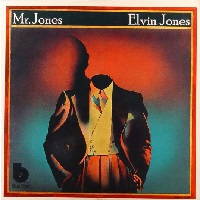
 Mehr ...
Mehr ...
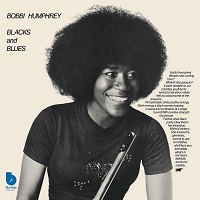
 Mehr ...
Mehr ...
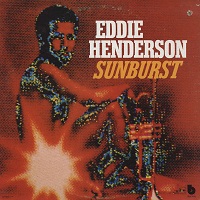
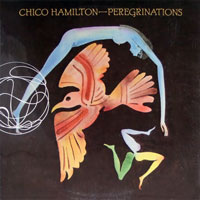 Mein erstes Blue Note Album vom ehemaligen Trommler des berÞhmten Gerry Mulligan/Chet Baker Quartetts
aus den 50ern mit einem "zeitgenÃķssischen" Mix aus Jazz, Funk, Rock und Disco.
Irgendwann in den spÃĪten 70ern/frÞhen 80ern hatte ich das Album fÞr wenig Geld irgendwo
aus der Grabbeliste gezogen und fand es zuerst, wie ich zugeben muÃ, ziemlich scheiÃe,
vor allem wegen der verwendeten Streicher. Wenn ich mir diese Musik jetzt aber aus der
Distanz so anhÃķre, dann hat das aber durchaus was! Zwar ist sie fÞr mich nicht so gut
wie die vom Labelkollegen Donald Byrd, aber immerhin mit
Arnie Lawrence und dem damaligen Shootingstar Arthur Blythe
an den Saxofonen, sowie Joe Beck und Barry Finnerty an den Gitarren. Bei
einigen Nummern mit dominaten Bassfiguren von Steve Turre habe ich sogar den Eindruck,
daà sich hier Kurti Hauenstein von Supermax doch sehr "inspirieren" lieÃ!
Und "Andy's Walk" ist eine wahre Hohner-D6-Orgie, die sich
durchaus mit "Superstition" von Stevie Wonder messen kann ...
Mein erstes Blue Note Album vom ehemaligen Trommler des berÞhmten Gerry Mulligan/Chet Baker Quartetts
aus den 50ern mit einem "zeitgenÃķssischen" Mix aus Jazz, Funk, Rock und Disco.
Irgendwann in den spÃĪten 70ern/frÞhen 80ern hatte ich das Album fÞr wenig Geld irgendwo
aus der Grabbeliste gezogen und fand es zuerst, wie ich zugeben muÃ, ziemlich scheiÃe,
vor allem wegen der verwendeten Streicher. Wenn ich mir diese Musik jetzt aber aus der
Distanz so anhÃķre, dann hat das aber durchaus was! Zwar ist sie fÞr mich nicht so gut
wie die vom Labelkollegen Donald Byrd, aber immerhin mit
Arnie Lawrence und dem damaligen Shootingstar Arthur Blythe
an den Saxofonen, sowie Joe Beck und Barry Finnerty an den Gitarren. Bei
einigen Nummern mit dominaten Bassfiguren von Steve Turre habe ich sogar den Eindruck,
daà sich hier Kurti Hauenstein von Supermax doch sehr "inspirieren" lieÃ!
Und "Andy's Walk" ist eine wahre Hohner-D6-Orgie, die sich
durchaus mit "Superstition" von Stevie Wonder messen kann ... Mehr ...
Mehr ...
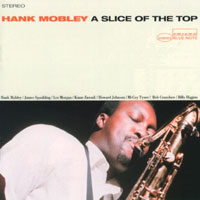 (18.10.2016)
(18.10.2016)
 Mehr ...
Mehr ...
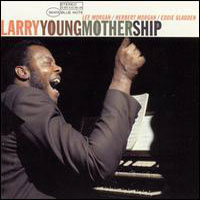 Seine letzte Session fÞr Blue Note, die aber erst mit 11 Jahren VerspÃĪtung, nach seinem
frÞhen Tod (30.03.78), erschien. Die Besetzung ist die gleiche wie zuvor bei seinem Meisterwerk
"Unity" von 1965: Orgel, Schlagzeug (Eddie Gladden),
Trompete (Lee Morgan) und Tenorsaxofon (Herbert Morgan),
aber die Musik hat sich natÞrlich weiterentwickelt: fÞnf Eigenkompositionen zwischen knapp 7 und 13 Minuten LÃĪnge,
die noch Hardbop und schon
ein klein wenig Jazzrock sind. Seine nÃĪchste Station wenige Monate spÃĪter war dann das fÞr
den Jazzrock bahnbrechende Trio Lifetime mit Tony Williams und John McLaughlin.
Der Rest ist Geschichte.
Seine letzte Session fÞr Blue Note, die aber erst mit 11 Jahren VerspÃĪtung, nach seinem
frÞhen Tod (30.03.78), erschien. Die Besetzung ist die gleiche wie zuvor bei seinem Meisterwerk
"Unity" von 1965: Orgel, Schlagzeug (Eddie Gladden),
Trompete (Lee Morgan) und Tenorsaxofon (Herbert Morgan),
aber die Musik hat sich natÞrlich weiterentwickelt: fÞnf Eigenkompositionen zwischen knapp 7 und 13 Minuten LÃĪnge,
die noch Hardbop und schon
ein klein wenig Jazzrock sind. Seine nÃĪchste Station wenige Monate spÃĪter war dann das fÞr
den Jazzrock bahnbrechende Trio Lifetime mit Tony Williams und John McLaughlin.
Der Rest ist Geschichte. Mehr ...
Mehr ...

 Mehr ...
Mehr ...

 Mehr ...
Mehr ...
 Auf diesem Blue Note Album verband sie ihre fÞr schwarze Jazzer ungewohnte
(?) Vorliebe zu weissen Singer/Songwritern und der Bluesmusik ihre Heimat
(Mississippi-Delta) mit ihrer Jazz-ÃĪsthetik - und das vor allem im
akustischen Gewand. Coverversionen von: Robert Johnson ("Come
On In My Kitchen" und "Hellhound On My Trail"), Ann
Peebles ("I Can't Stand The Rain"), Van Morrison
("Tupelo Honey") und Joni
Mitchell ("Black Crow").
Auf diesem Blue Note Album verband sie ihre fÞr schwarze Jazzer ungewohnte
(?) Vorliebe zu weissen Singer/Songwritern und der Bluesmusik ihre Heimat
(Mississippi-Delta) mit ihrer Jazz-ÃĪsthetik - und das vor allem im
akustischen Gewand. Coverversionen von: Robert Johnson ("Come
On In My Kitchen" und "Hellhound On My Trail"), Ann
Peebles ("I Can't Stand The Rain"), Van Morrison
("Tupelo Honey") und Joni
Mitchell ("Black Crow").
 Mehr ...
Mehr ...
 Auch auf diesem Album pendelt Cassandra Wilson zwischen Jazz und Blues und
Þberrascht neben vorzÞglichem eigenen Material mit der Wahl
der Coverversionen: Son House, Billie Holiday ("Strange
Fruit"), U2, Neil Young ("Harvest
Moon"), The Monkees ("Last Train To Clarksville"),
Hank Williams und Hoagy Carmichael. Weitestgehend akustisch
eingespielt mit Jazz-KÃķnnern und klanglich ein Ohrenschmaus.
Auch auf diesem Album pendelt Cassandra Wilson zwischen Jazz und Blues und
Þberrascht neben vorzÞglichem eigenen Material mit der Wahl
der Coverversionen: Son House, Billie Holiday ("Strange
Fruit"), U2, Neil Young ("Harvest
Moon"), The Monkees ("Last Train To Clarksville"),
Hank Williams und Hoagy Carmichael. Weitestgehend akustisch
eingespielt mit Jazz-KÃķnnern und klanglich ein Ohrenschmaus.

 Mehr ...
Mehr ...
 Mandoline, Kontrabass und Schlagzeug - eine ausgezeichnete Kombination,
um zu jazzen. Jamie Masefield ist ein Meister der 8 Saiten. Gerade
in Jamband-Kreisen ist die Kapelle sehr beliebt und wurde mit diesem zweiten
Album sogar fÞr das legendÃĪre Blue Note-Label verpflichtet.
Als Gast dabei: Jamrock-Halbgott Trey Anastasio von Phish an der
Gitarre.
Mandoline, Kontrabass und Schlagzeug - eine ausgezeichnete Kombination,
um zu jazzen. Jamie Masefield ist ein Meister der 8 Saiten. Gerade
in Jamband-Kreisen ist die Kapelle sehr beliebt und wurde mit diesem zweiten
Album sogar fÞr das legendÃĪre Blue Note-Label verpflichtet.
Als Gast dabei: Jamrock-Halbgott Trey Anastasio von Phish an der
Gitarre. Mehr ...
Mehr ...
 Ein Projekt des franzÃķsischen Produzenten Ludovic Navarre,
der hier erstaunliche Ergebnisse bei der Verbindung von Jazz und Electronik
erzielt: Bass, Schlagzeug und ein paar schicke Samples (u.a. Marlena Shaw
und John Lee Hooker) kommen aus dem Computer, dazu als "SahnehÃĪubchen"
echte Trompete, Saxofon, Gitarre, Piano und Perkussion: alles passt! Und
zurecht geadelt durch die VerÃķffentlichung bei dem legendÃĪren
Jazzlabel!
Ein Projekt des franzÃķsischen Produzenten Ludovic Navarre,
der hier erstaunliche Ergebnisse bei der Verbindung von Jazz und Electronik
erzielt: Bass, Schlagzeug und ein paar schicke Samples (u.a. Marlena Shaw
und John Lee Hooker) kommen aus dem Computer, dazu als "SahnehÃĪubchen"
echte Trompete, Saxofon, Gitarre, Piano und Perkussion: alles passt! Und
zurecht geadelt durch die VerÃķffentlichung bei dem legendÃĪren
Jazzlabel!  Mehr ...
Mehr ...
 Mehr ...
Mehr ...

 Mehr ...
Mehr ...
 VÃķllig
Þberraschend nach so vielen Jahren ein Album des besten SoulsÃĪngers
Þberhaupt (natÞrlich neben Otis Redding). Als wÃĪre
seit "Let's Stay Together" keine 30 Jahre vergangen. Wenn es
zeitlos gute Popmusik gibt: dann so was! Und der GlitterhÃĪusler soll
sich die Platte einfach noch mal anhÃķren.
VÃķllig
Þberraschend nach so vielen Jahren ein Album des besten SoulsÃĪngers
Þberhaupt (natÞrlich neben Otis Redding). Als wÃĪre
seit "Let's Stay Together" keine 30 Jahre vergangen. Wenn es
zeitlos gute Popmusik gibt: dann so was! Und der GlitterhÃĪusler soll
sich die Platte einfach noch mal anhÃķren. Mehr ...
Mehr ...
 Mehr ...
Mehr ...
 Wahnsinn! Ein neues Album von Monk und Trane, zwei der wichtigsten
Jazzmusiker aller Zeiten und auch zwei meiner absoluten Favoriten! Die
Aufnahmen stammen von einem WohltÃĪtigkeitskonzert in der New Yorker
Carnegie Hall vom 29.11.1957 und wurden erst kÞrzlich in einem verstaubten
Archiv entdeckt. Geniale Musik - und ein fantastischer Sound!
Wahnsinn! Ein neues Album von Monk und Trane, zwei der wichtigsten
Jazzmusiker aller Zeiten und auch zwei meiner absoluten Favoriten! Die
Aufnahmen stammen von einem WohltÃĪtigkeitskonzert in der New Yorker
Carnegie Hall vom 29.11.1957 und wurden erst kÞrzlich in einem verstaubten
Archiv entdeckt. Geniale Musik - und ein fantastischer Sound! Mehr ...
Mehr ...
 Dies ist wohl schon das dritte Album der Dame, die aus Israel stammt,
in Paris aufgewachsen ist und inzwischen in New York lebt und arbeitet.
FrÞhere Alben sollen in FranzÃķsisch sein, aber auf diesem titellosen
Album wurde erstmals ausschlieÃlich Englisch gesungen. FÞr ÃĪltere
Zeitgenossen: Es klingt stark nach Velvet
Underground. Etwas JÞngere unter uns fÞhlen sich vielleicht
ein wenig an die Band Mazzy Star erinnert,
die ja aber auch im Grunde nach VU klangen.
So etwas mag ich natÞrlich sehr!
Dies ist wohl schon das dritte Album der Dame, die aus Israel stammt,
in Paris aufgewachsen ist und inzwischen in New York lebt und arbeitet.
FrÞhere Alben sollen in FranzÃķsisch sein, aber auf diesem titellosen
Album wurde erstmals ausschlieÃlich Englisch gesungen. FÞr ÃĪltere
Zeitgenossen: Es klingt stark nach Velvet
Underground. Etwas JÞngere unter uns fÞhlen sich vielleicht
ein wenig an die Band Mazzy Star erinnert,
die ja aber auch im Grunde nach VU klangen.
So etwas mag ich natÞrlich sehr! Mehr ...
Mehr ...
 BlÃķde Brille, tolle Musik! Al Green hat sich dieses mal nicht von
seiner alten Memphis-GÃĪng um Wilie Mitchell begleiten lassen, sondern
von einer Studioband um den Schlagzeuger und Produzenten ?uestlove,
der wohl von der berÞhmten (?) Hipp-Hopp(?)-Band The Roots
kommt. Man verzeihe mir meine Ignoranz und die vielen Fragezeichen (kleiner
Witz), aber ich kenne mich in jener Branche leider nicht aus. Die einzige
Platte in meinem Plattenschrank, auf der dieser offensichtlich ausgezeichnete
Musiker zu hÃķren ist, ist "The Soul
Sessions" von Joss Stone, deren Retro-Soul nicht sehr
weit weg ist von Al Green. Und auch auf "Lay It Down" klingt
Al Green so wie immer. Was natÞrlich eine gute Sache ist.
BlÃķde Brille, tolle Musik! Al Green hat sich dieses mal nicht von
seiner alten Memphis-GÃĪng um Wilie Mitchell begleiten lassen, sondern
von einer Studioband um den Schlagzeuger und Produzenten ?uestlove,
der wohl von der berÞhmten (?) Hipp-Hopp(?)-Band The Roots
kommt. Man verzeihe mir meine Ignoranz und die vielen Fragezeichen (kleiner
Witz), aber ich kenne mich in jener Branche leider nicht aus. Die einzige
Platte in meinem Plattenschrank, auf der dieser offensichtlich ausgezeichnete
Musiker zu hÃķren ist, ist "The Soul
Sessions" von Joss Stone, deren Retro-Soul nicht sehr
weit weg ist von Al Green. Und auch auf "Lay It Down" klingt
Al Green so wie immer. Was natÞrlich eine gute Sache ist. Mehr ...
Mehr ...
 Alle paar Jahre macht Rosanne Cash ein Album - und eigentlich immer
ein ziemlich gutes. Das hat wenig mit Country und Nashville zu tun,
sondern ist einfach nur Singer/Songwritermusik in Perfektion, wobei
diese "Perfektion" zu keinem Zeitpunkt stÃķrt. DafÞr
verantwortlich sind neben Rosannes Stimme und ihren Texten vor allem
die Kompsitionen und die Produktion von Ehemann John Leventhal,
der auch fast alle Instrumente gespielt hat. Zu den gelegentlichen
GÃĪsten gehÃķrt u.a. Derek
Trucks, der einmal seine geniale Slidegitarre auspackt. Gesangliche
UnterstÞtzung kommt von solch illustren GÃĪsten wie Allison
Moorer, Amy Helm, John Prine,
Tony Joe White und Kris
Kristofferson.
Alle paar Jahre macht Rosanne Cash ein Album - und eigentlich immer
ein ziemlich gutes. Das hat wenig mit Country und Nashville zu tun,
sondern ist einfach nur Singer/Songwritermusik in Perfektion, wobei
diese "Perfektion" zu keinem Zeitpunkt stÃķrt. DafÞr
verantwortlich sind neben Rosannes Stimme und ihren Texten vor allem
die Kompsitionen und die Produktion von Ehemann John Leventhal,
der auch fast alle Instrumente gespielt hat. Zu den gelegentlichen
GÃĪsten gehÃķrt u.a. Derek
Trucks, der einmal seine geniale Slidegitarre auspackt. Gesangliche
UnterstÞtzung kommt von solch illustren GÃĪsten wie Allison
Moorer, Amy Helm, John Prine,
Tony Joe White und Kris
Kristofferson. Mehr ...
Mehr ...
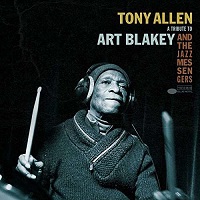 Der legendÃĪre Schlagzeuger aus Nigeria mit seinem DebÞt auf Zehn Zoll fÞr das legendÃĪre Jazzlabel
mit einer Hommage an Art Blakey, einen anderen legendÃĪren Trommler ...
Der legendÃĪre Schlagzeuger aus Nigeria mit seinem DebÞt auf Zehn Zoll fÞr das legendÃĪre Jazzlabel
mit einer Hommage an Art Blakey, einen anderen legendÃĪren Trommler ... Mehr ...
Mehr ...
 Der legendÃĪre Schlagzeuger aus Nigeria mit seinem ersten Longplayer fÞr das legendÃĪre Jazzlabel ...
Der legendÃĪre Schlagzeuger aus Nigeria mit seinem ersten Longplayer fÞr das legendÃĪre Jazzlabel ... Mehr ...
Mehr ...
 Zuerst ein neues Meisterwerk von Kamasi Washington, dann ein Archivschatz von
John Coltrane und jetzt auch noch ein tolles Doppelalbum von Charles Lloyd
und seiner Wahnsinnsband um die Gitarristen Bill Frisell und Greg Leisz mit einer gut aufgelegten
Lucinda Williams hinter dem Mikrophon: im Juni hat der Jazz bei mir
dem Rock'n'Roll doch klar die RÞcklichter gezeigt! Ach ja: Bassmann Chris von den
Wood Brothers ist ja eigentlich auch ein Weltklasse-Jazzer ...
Zuerst ein neues Meisterwerk von Kamasi Washington, dann ein Archivschatz von
John Coltrane und jetzt auch noch ein tolles Doppelalbum von Charles Lloyd
und seiner Wahnsinnsband um die Gitarristen Bill Frisell und Greg Leisz mit einer gut aufgelegten
Lucinda Williams hinter dem Mikrophon: im Juni hat der Jazz bei mir
dem Rock'n'Roll doch klar die RÞcklichter gezeigt! Ach ja: Bassmann Chris von den
Wood Brothers ist ja eigentlich auch ein Weltklasse-Jazzer ... Mehr ...
Mehr ...
 Wilco |
Julian Lage]
Wilco |
Julian Lage]
 Mehr ...
Mehr ...

 Mehr ...
Mehr ...
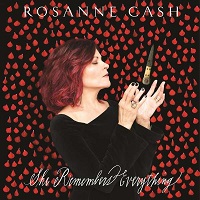 Bereits das zweite Album von Johnnys Tochter beim legendÃĪren Jazzlabel - wobei sie natÞrlich auch dort keinen Jazz macht,
sondern wie gehabt allerbeste Singer/Songwriter-Musik liefert. Aufgenommen zur einen HÃĪlfte in ihren Wahlheimat New York
mit Ehemann, Produzent und Multiinstrumentalist John Leventhal und zur anderen HÃĪlfte mit und bei dem von mir hochgeschÃĪtzen
Tucker Martine (Laura Veirs, The Decemberists)
in Portland. Als singende und komponierende GÃĪste sind unter anderem Elvis Costello und Kris Kristofferson
dabei.
Bereits das zweite Album von Johnnys Tochter beim legendÃĪren Jazzlabel - wobei sie natÞrlich auch dort keinen Jazz macht,
sondern wie gehabt allerbeste Singer/Songwriter-Musik liefert. Aufgenommen zur einen HÃĪlfte in ihren Wahlheimat New York
mit Ehemann, Produzent und Multiinstrumentalist John Leventhal und zur anderen HÃĪlfte mit und bei dem von mir hochgeschÃĪtzen
Tucker Martine (Laura Veirs, The Decemberists)
in Portland. Als singende und komponierende GÃĪste sind unter anderem Elvis Costello und Kris Kristofferson
dabei. Mehr ...
Mehr ...

 Mehr ...
Mehr ...
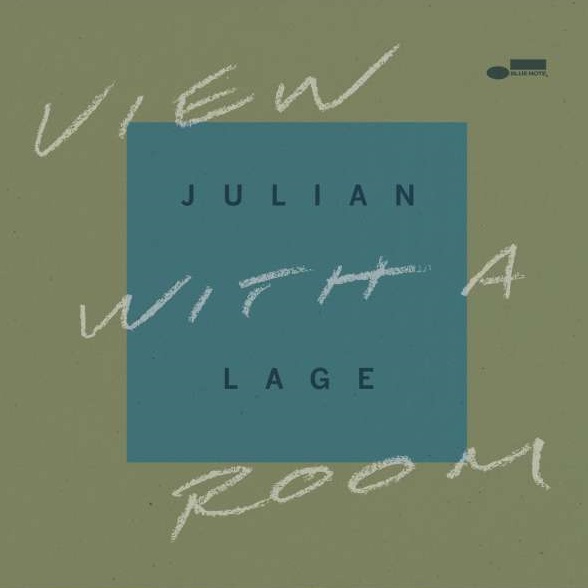 [Bill Frisell |
Nels Cline 4]
[Bill Frisell |
Nels Cline 4]
 Mehr ...
Mehr ...
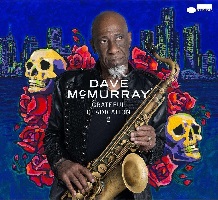 [Grateful Dead Covers]
[Grateful Dead Covers]
 Mehr ...
Mehr ...


 Ike Quebec war ein enger Freund von Produzent und Labelchef Alfred Lion, arbeitete
hauptsÃĪchlich als Talentscout fÞr Blue Note, nahm aber auch gelegentlich noch eigene Alben auf.
Ike Quebec war ein enger Freund von Produzent und Labelchef Alfred Lion, arbeitete
hauptsÃĪchlich als Talentscout fÞr Blue Note, nahm aber auch gelegentlich noch eigene Alben auf. Aufgenommen 1961, verÃķffentlicht aber erst 1964, was aber nicht ungewÃķhnlich fÞr
Blue-Note und viele andere Jazzlabels war: Oft wurde in einer Session
Material fÞr mehrere Alben eingespielt, manchmal verschwanden ganze
Sessions und somit ganze geplante Alben erst einmal im Archiv und wurden erst
nach dem Tod (Quebec verstarb 1963) oder nach Labelwechsel der KÞnstler
verÃķffentlicht, ohne dass man dabei aber von AusschuÃmaterial
sprechen kÃķnnte.
Aufgenommen 1961, verÃķffentlicht aber erst 1964, was aber nicht ungewÃķhnlich fÞr
Blue-Note und viele andere Jazzlabels war: Oft wurde in einer Session
Material fÞr mehrere Alben eingespielt, manchmal verschwanden ganze
Sessions und somit ganze geplante Alben erst einmal im Archiv und wurden erst
nach dem Tod (Quebec verstarb 1963) oder nach Labelwechsel der KÞnstler
verÃķffentlicht, ohne dass man dabei aber von AusschuÃmaterial
sprechen kÃķnnte. 
 Ein grooviges Album des Gitarristen und in den 90ern eine der meist
gesampelten Vorlagen fÞr den so genannten "Acid-Jazz".
Aber keine Sorge: es handelt sich um ein wirklich gutes Album, nur vielleicht
fÞr Jazzpuristen etwas zu "kommerziell" - aber was soll's?
Ein grooviges Album des Gitarristen und in den 90ern eine der meist
gesampelten Vorlagen fÞr den so genannten "Acid-Jazz".
Aber keine Sorge: es handelt sich um ein wirklich gutes Album, nur vielleicht
fÞr Jazzpuristen etwas zu "kommerziell" - aber was soll's? Ob Bobby Hutcherson soviel Spaà hatte, weil man damals
Ob Bobby Hutcherson soviel Spaà hatte, weil man damals
 Trompeter Donald Byrd bei einer seiner letzten akustischen Sessions vor seiner erfolgreichen
Funk-Phase, zusammen mit Sonny Red (Altsaxofonist), Cedar Walton (Piano), Walter Booker
(Bass) und Trommler Billy Higgins.
Trompeter Donald Byrd bei einer seiner letzten akustischen Sessions vor seiner erfolgreichen
Funk-Phase, zusammen mit Sonny Red (Altsaxofonist), Cedar Walton (Piano), Walter Booker
(Bass) und Trommler Billy Higgins.  SpÃĪt entdeckt, aber nicht zu spÃĪt! Ein wunderbares Album,
das nicht schon alleine deshalb schlecht sein muss, weil so viele Leute
es offensichtlich auch sehr mÃķgen. Und der Nachfolger von 2004
"
SpÃĪt entdeckt, aber nicht zu spÃĪt! Ein wunderbares Album,
das nicht schon alleine deshalb schlecht sein muss, weil so viele Leute
es offensichtlich auch sehr mÃķgen. Und der Nachfolger von 2004
" Mit seinem tatsÃĪchlich 32. Soloalbum ist Van The Man nun bei Blue
Note gelandet. Aber hierbei handelt es sich nicht um ein straightes
Jazz-Album, sondern um die Verdichtung seiner mannigfaltigen EinflÞsse
und um diesen unnachahmlichen Flow seiner Kompositionen, der sich auf
„What´s Wrong With This Picture“ gut geerdet zeigt.
Mit einer brillanten Version von „Saint James Infirmary“,
aber leider auch sattsam bekannten Songmustern (jeder weià wie
der Song „Somerset“ klingt). Sicher ist das hier aller Ehren
wert, einige werden hier ein „groÃes Alterwerk“ hÃķren
und ich will hier auch nichts Schlechtes Þber meinen alten Helden
sagen… Also lasse ich es und suche mal nach „Tupelo Honey“.
(Glitterhouse)
Mit seinem tatsÃĪchlich 32. Soloalbum ist Van The Man nun bei Blue
Note gelandet. Aber hierbei handelt es sich nicht um ein straightes
Jazz-Album, sondern um die Verdichtung seiner mannigfaltigen EinflÞsse
und um diesen unnachahmlichen Flow seiner Kompositionen, der sich auf
„What´s Wrong With This Picture“ gut geerdet zeigt.
Mit einer brillanten Version von „Saint James Infirmary“,
aber leider auch sattsam bekannten Songmustern (jeder weià wie
der Song „Somerset“ klingt). Sicher ist das hier aller Ehren
wert, einige werden hier ein „groÃes Alterwerk“ hÃķren
und ich will hier auch nichts Schlechtes Þber meinen alten Helden
sagen… Also lasse ich es und suche mal nach „Tupelo Honey“.
(Glitterhouse) Auch diese Platte ist natÞrlich kein Geheimtipp. Schon das DebÞt
"
Auch diese Platte ist natÞrlich kein Geheimtipp. Schon das DebÞt
" Eigentlich hatte ich mich auf das Album sehr gefreut, als ganz kurzfristig die
VorankÞndigung per Email kam, u. a. weil als Produzent T-Bone
Burnett erwÃĪhnt wird. Aber direkt bei der ersten Nummer gibt
es Computerbeats, die mir erstmal den Appetit verdorben haben. AuÃerdem
fehlt die ultimative Coverversion, fÞr die ich Mrs. Wilson so sehr
liebe (ich denke da z.B. wehmÞtig an das grandiose, gegen den Strich
gebÞrstete "Harvest Moon" auf "
Eigentlich hatte ich mich auf das Album sehr gefreut, als ganz kurzfristig die
VorankÞndigung per Email kam, u. a. weil als Produzent T-Bone
Burnett erwÃĪhnt wird. Aber direkt bei der ersten Nummer gibt
es Computerbeats, die mir erstmal den Appetit verdorben haben. AuÃerdem
fehlt die ultimative Coverversion, fÞr die ich Mrs. Wilson so sehr
liebe (ich denke da z.B. wehmÞtig an das grandiose, gegen den Strich
gebÞrstete "Harvest Moon" auf "
(2021-06-27)